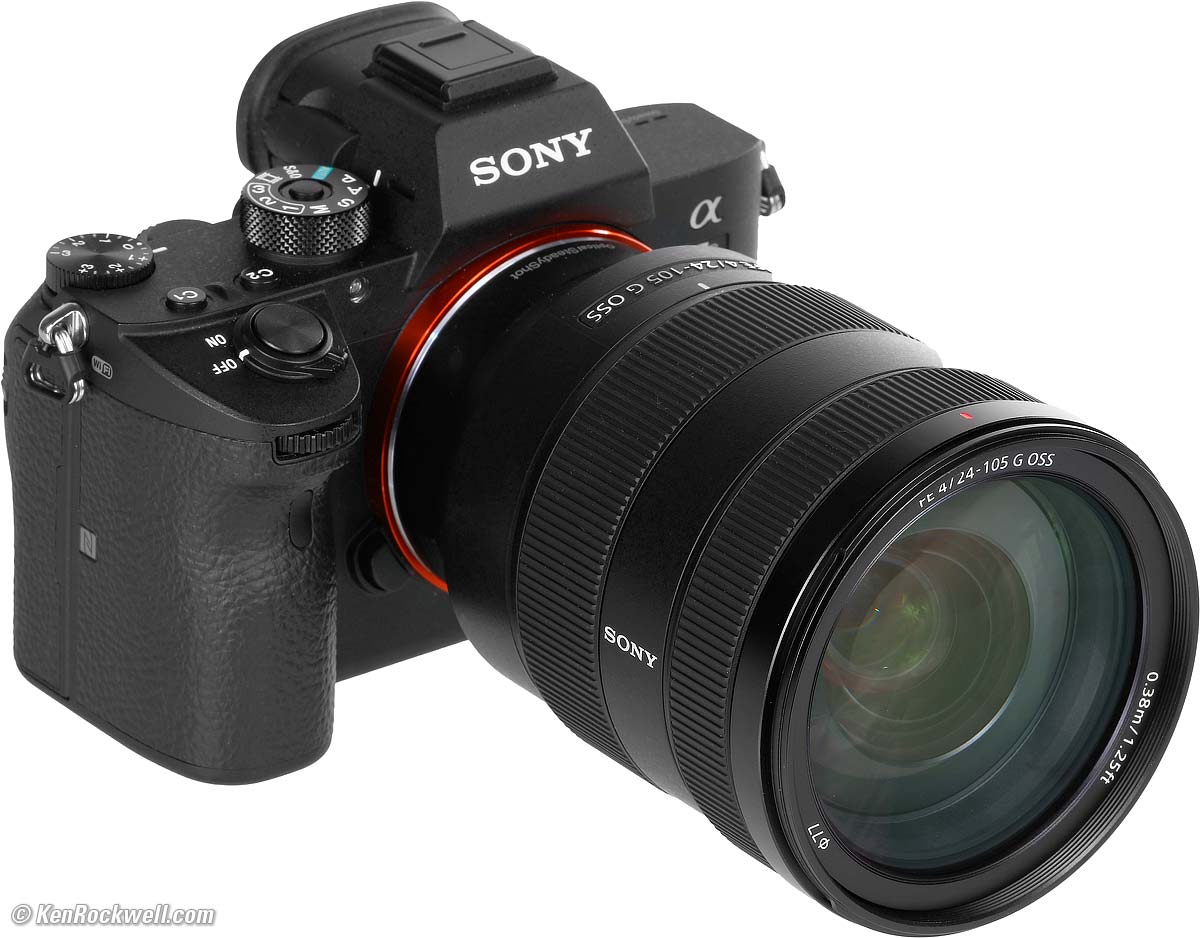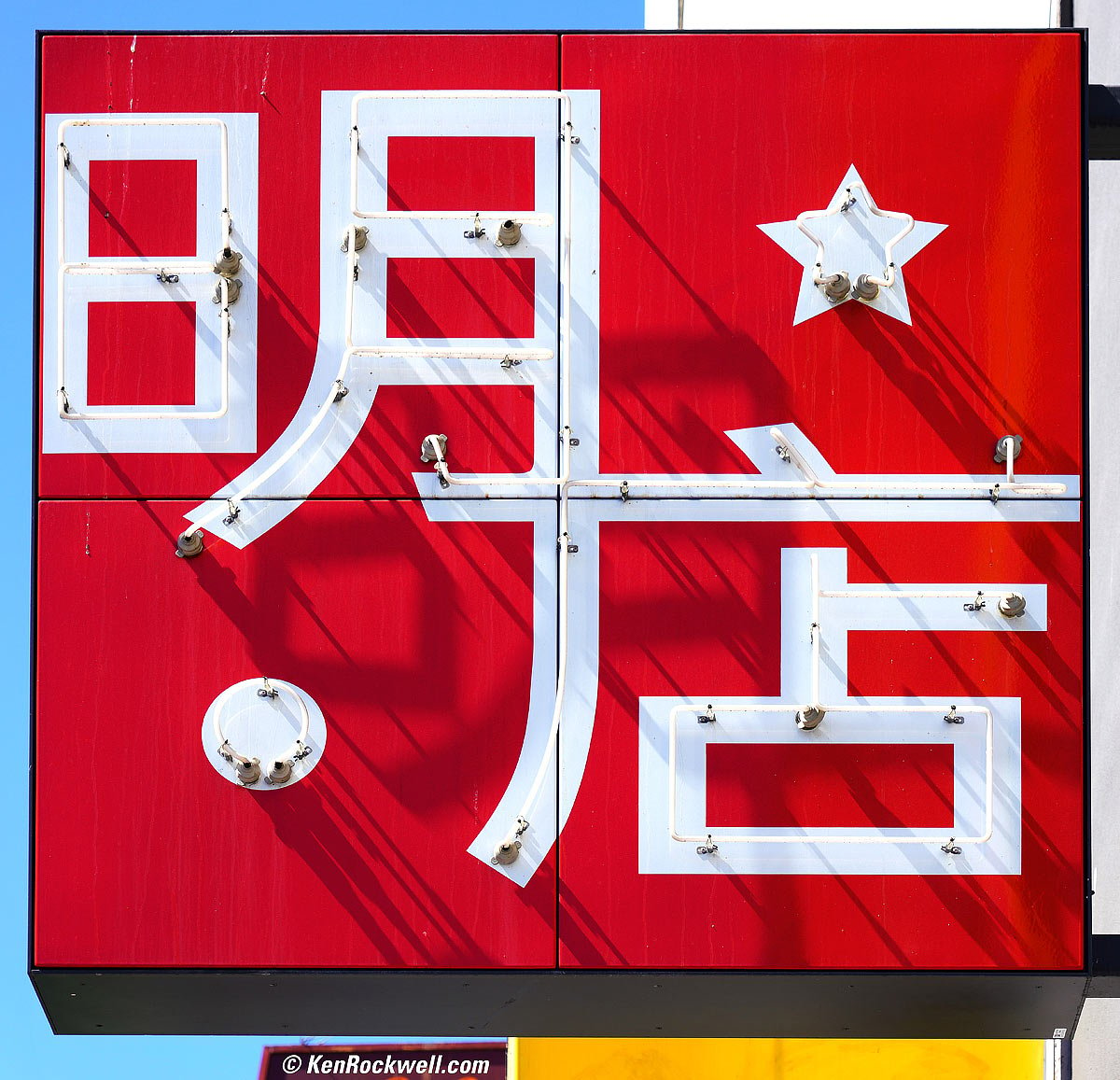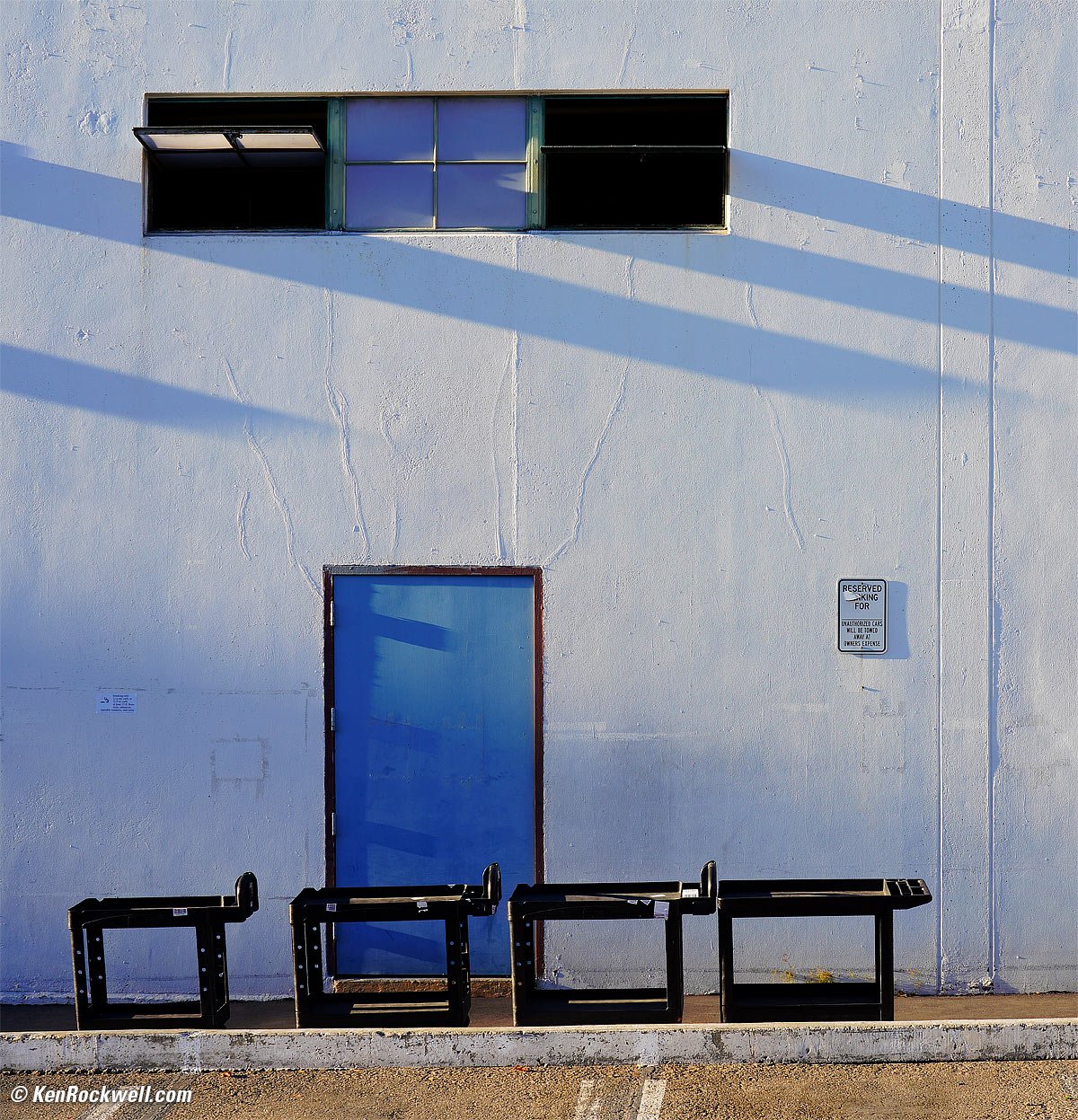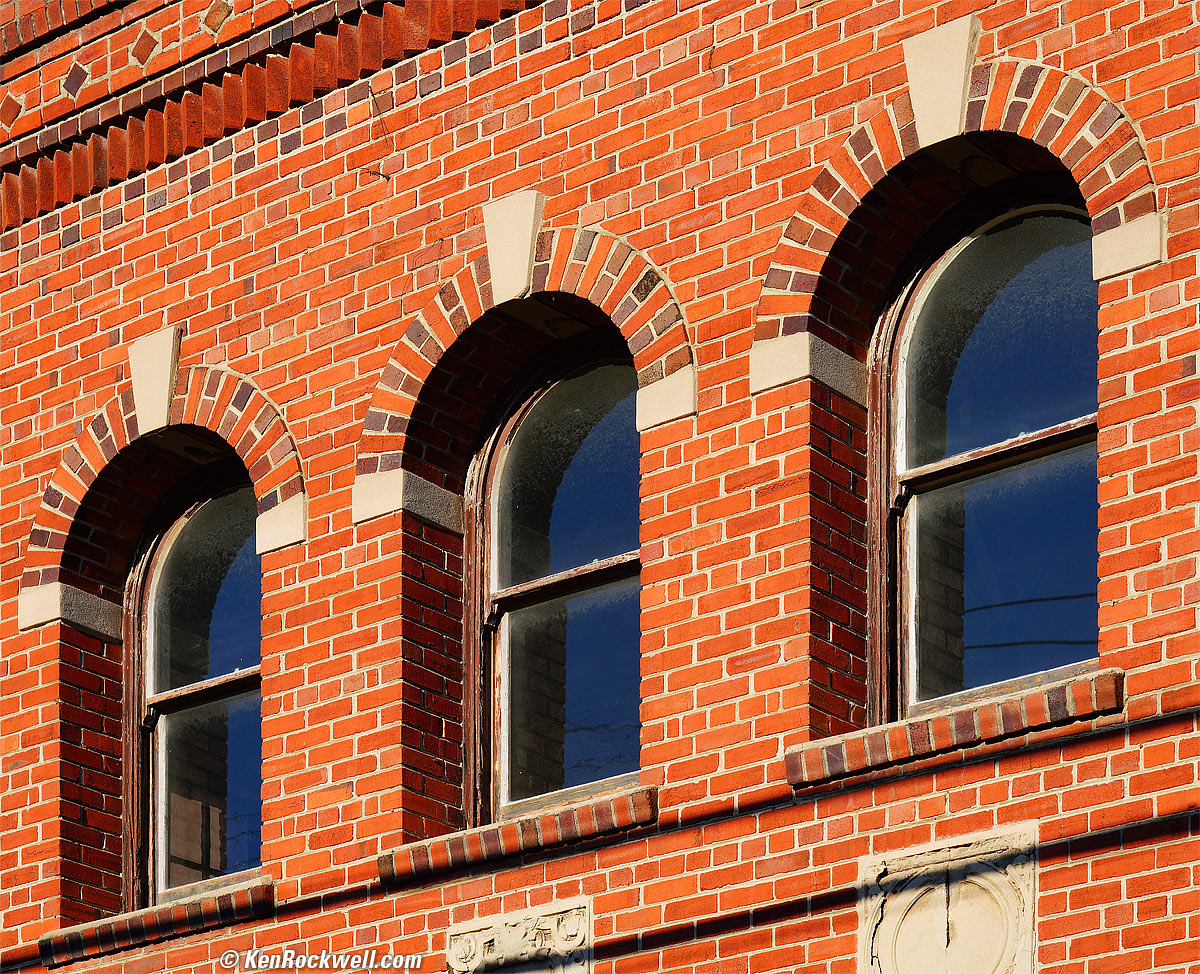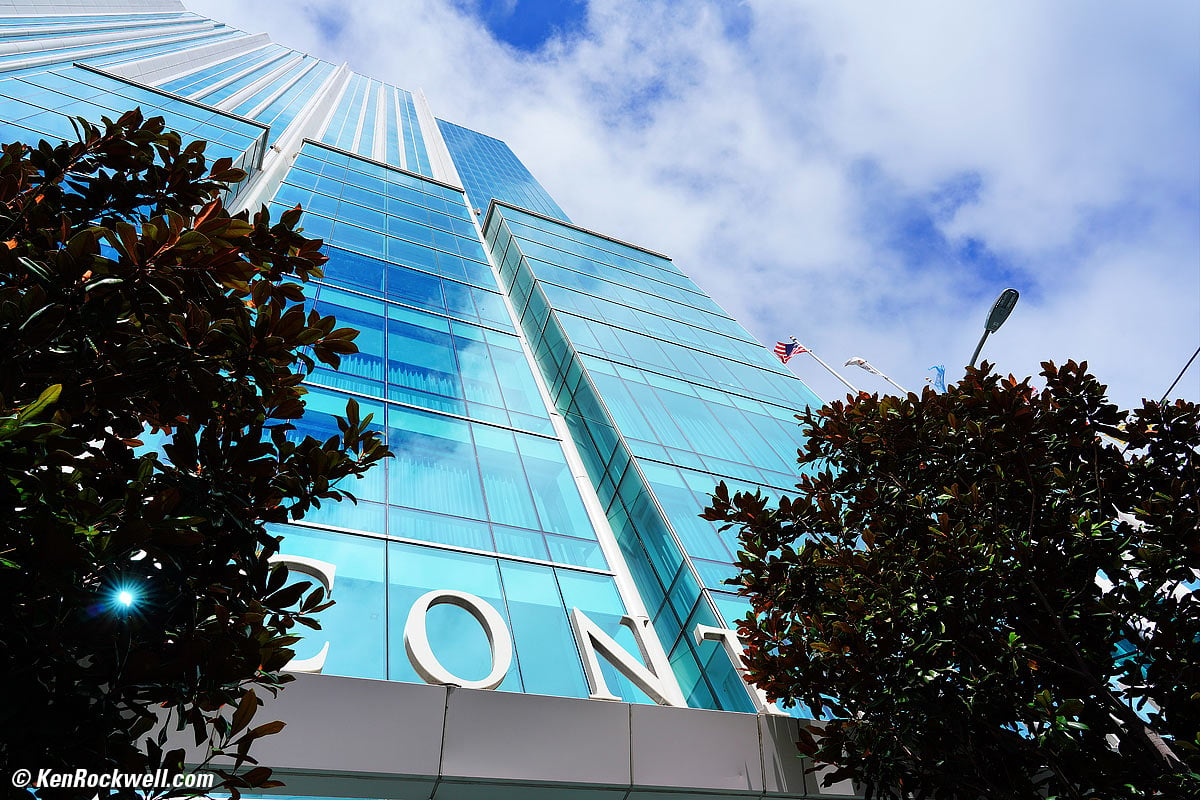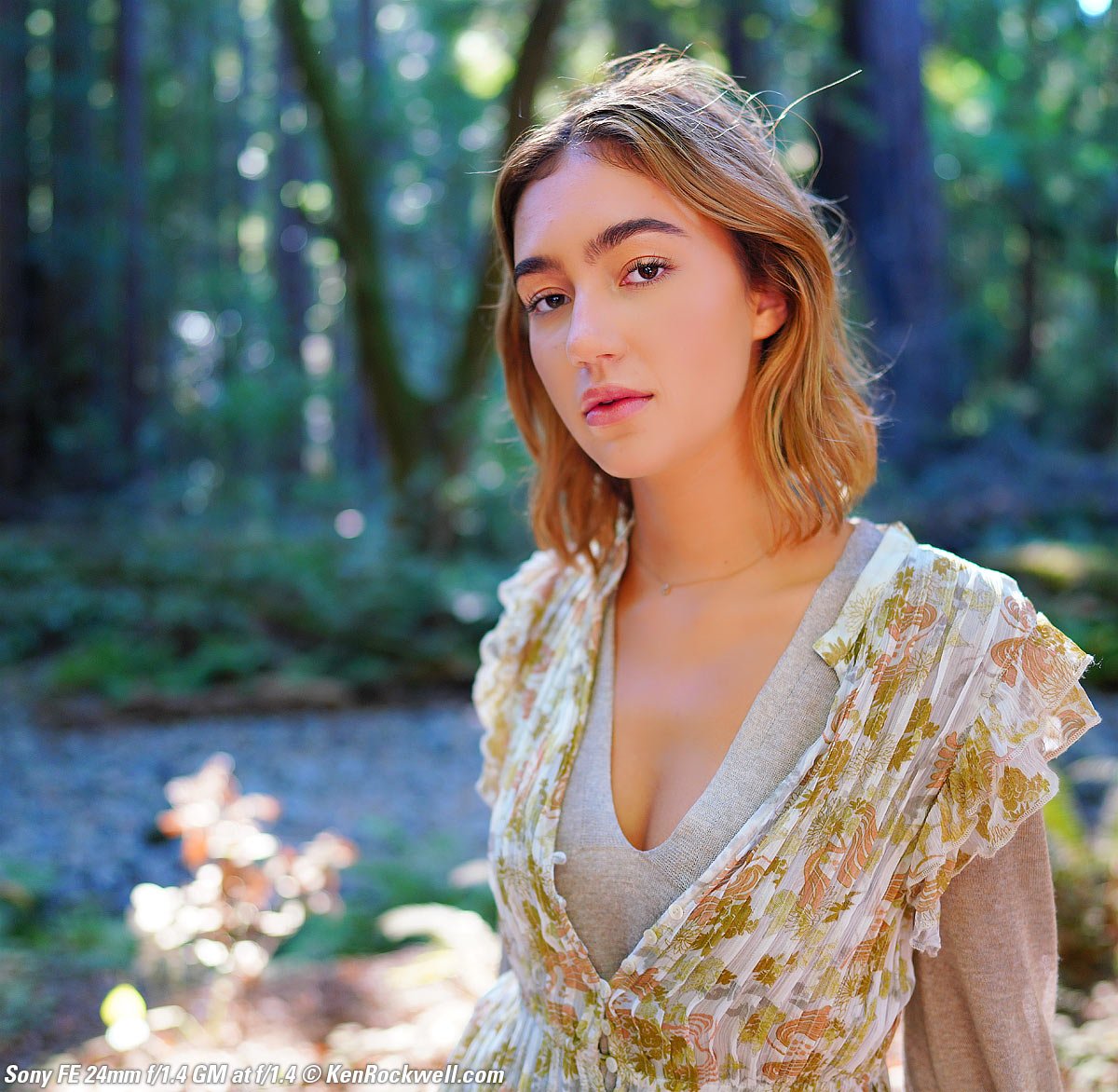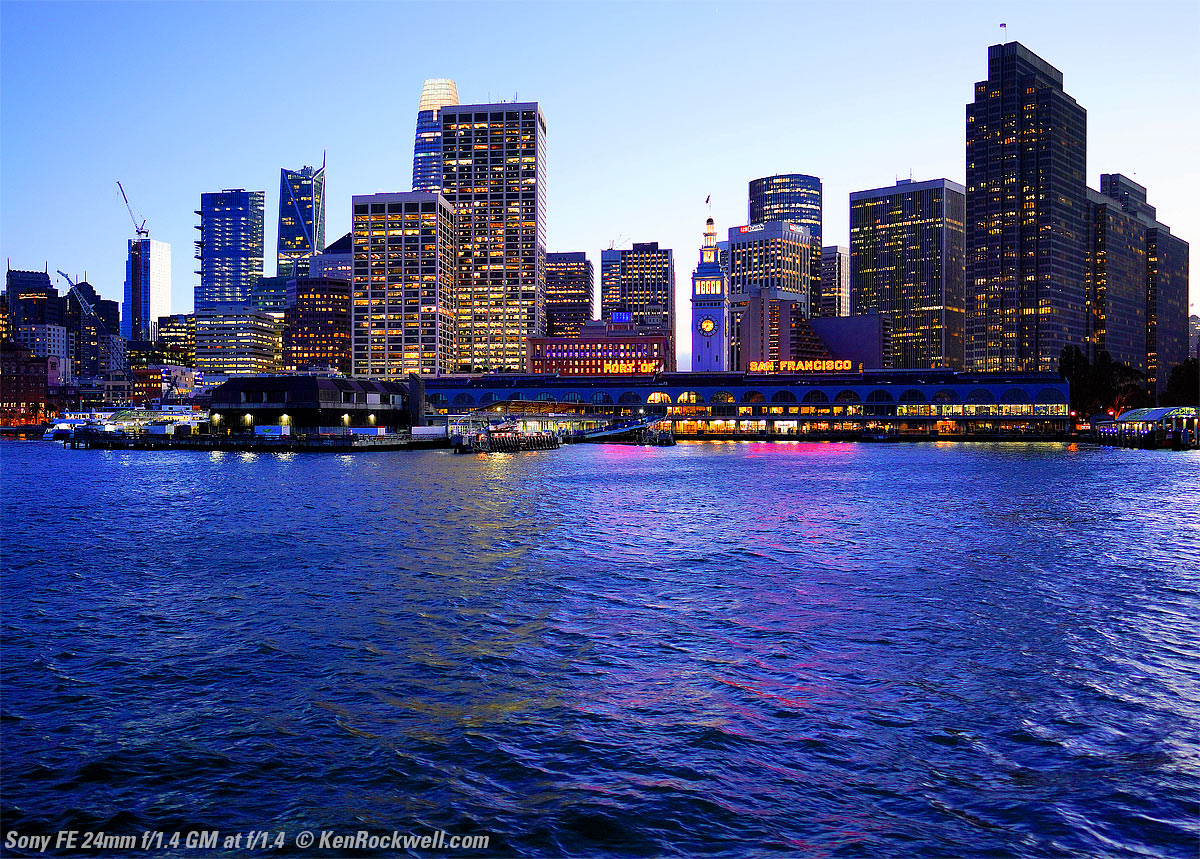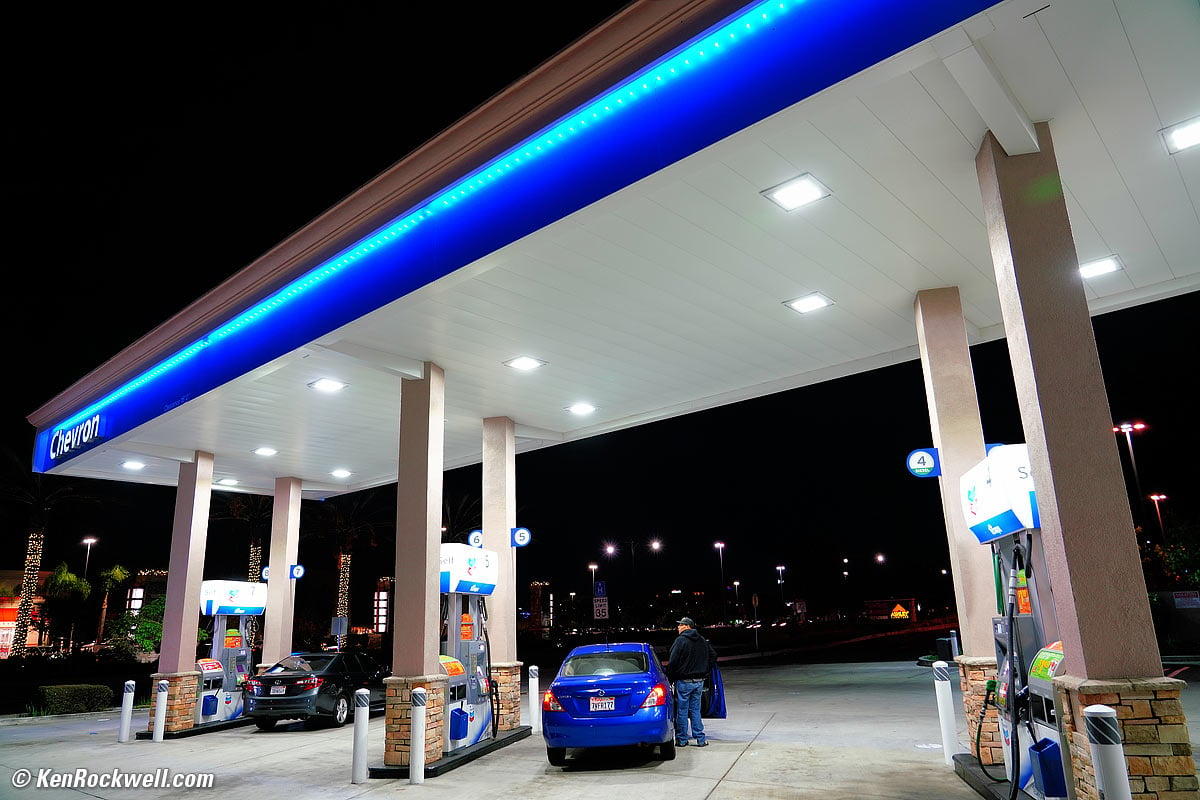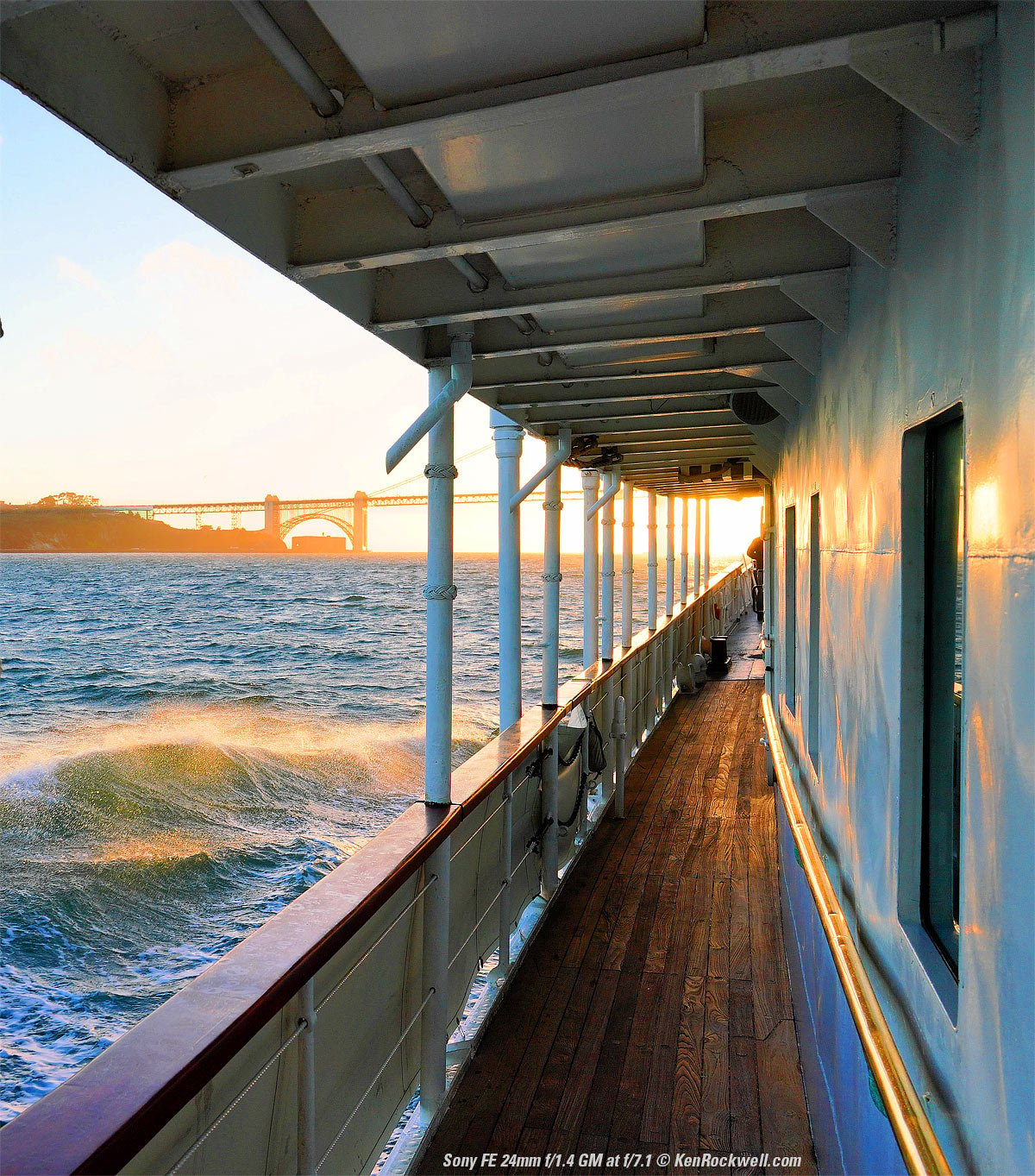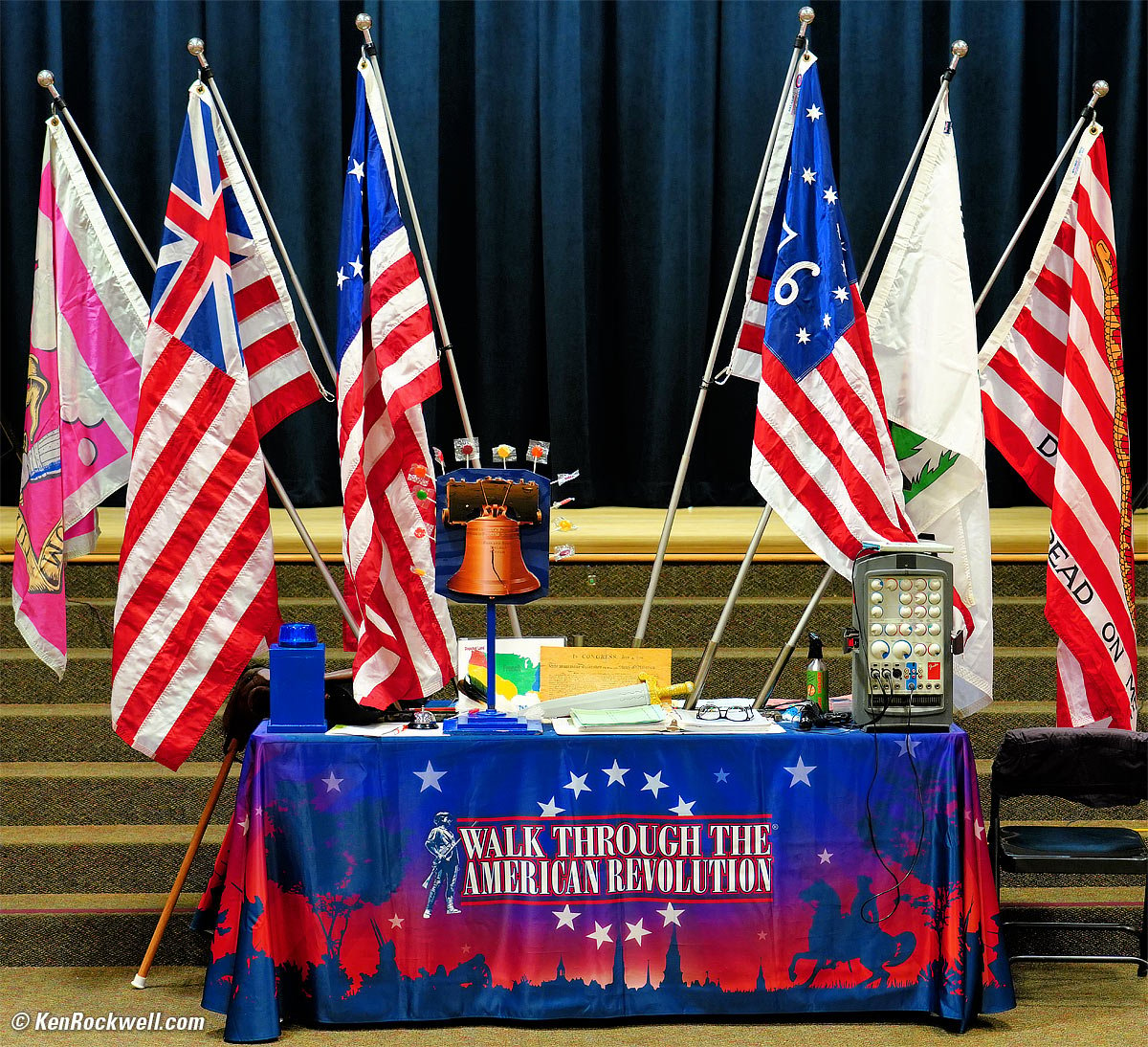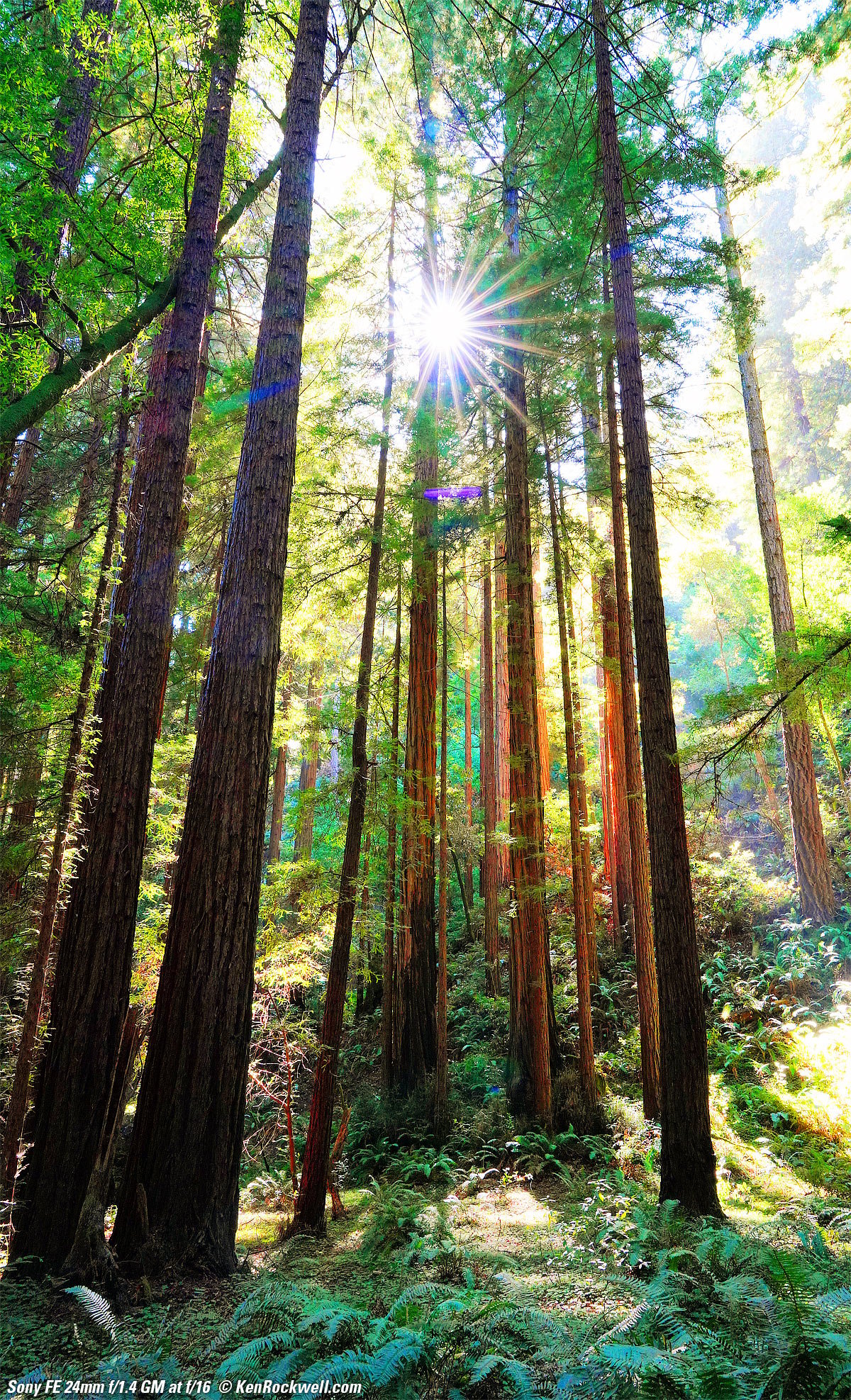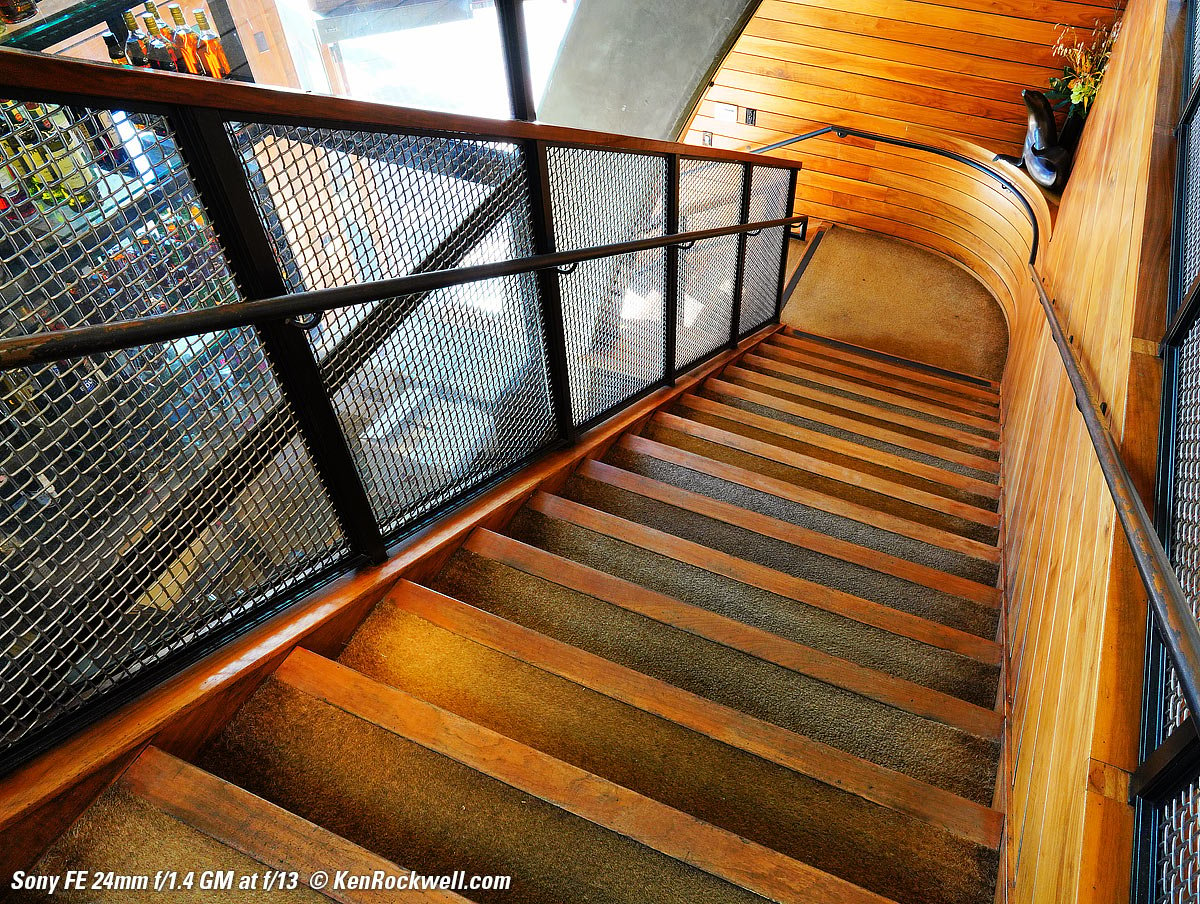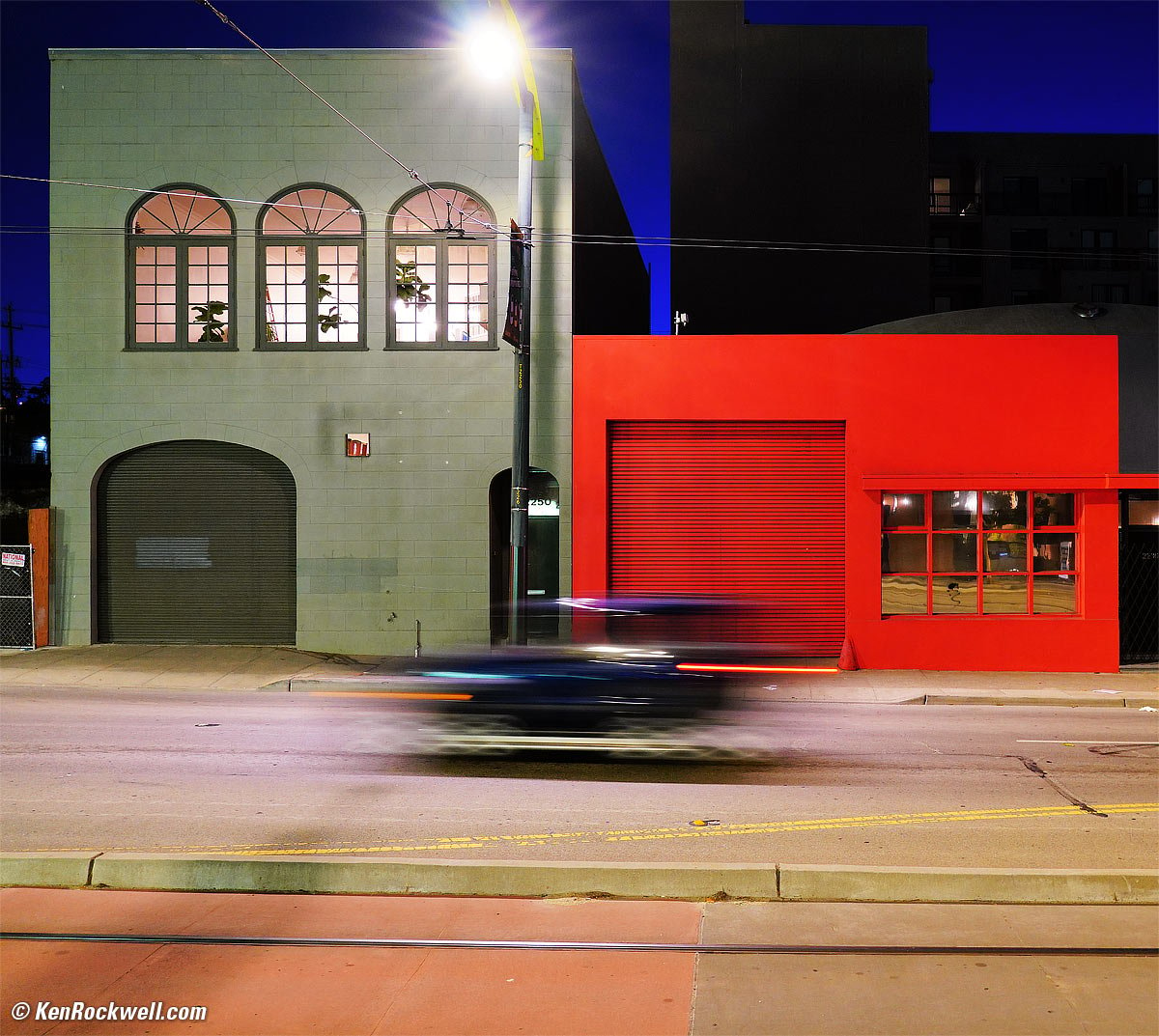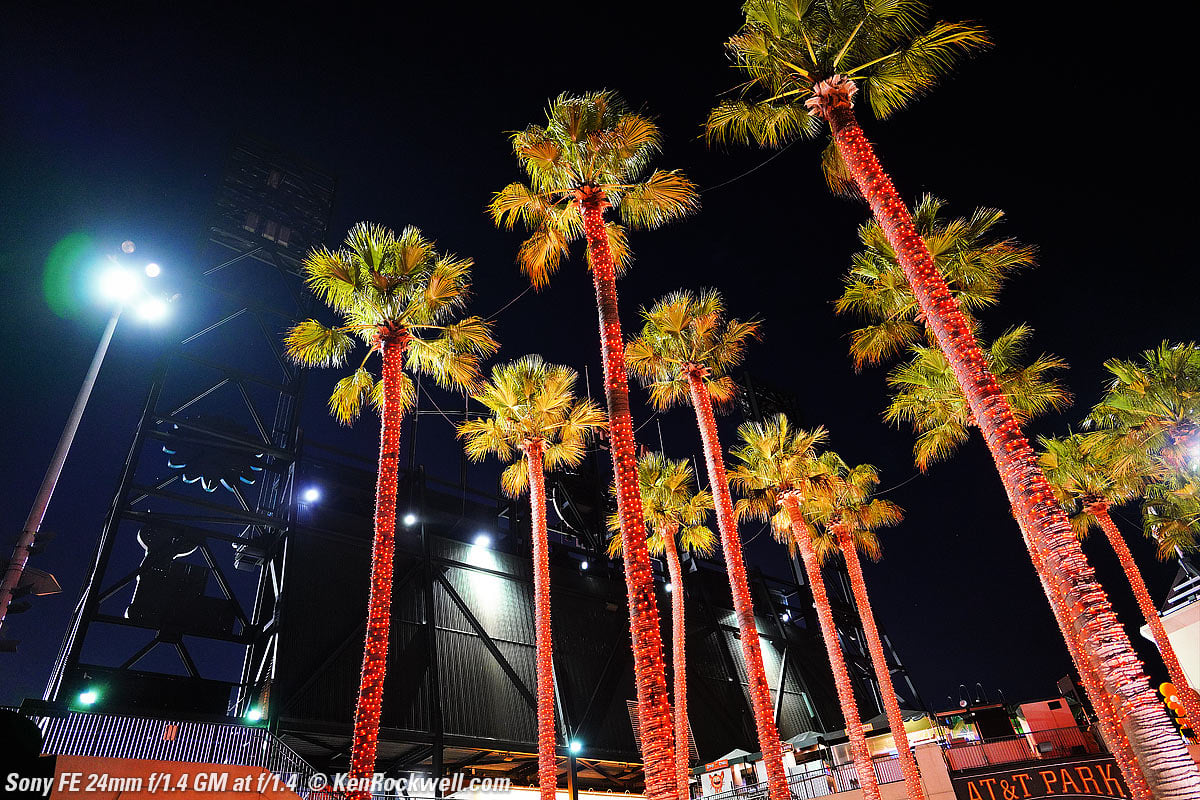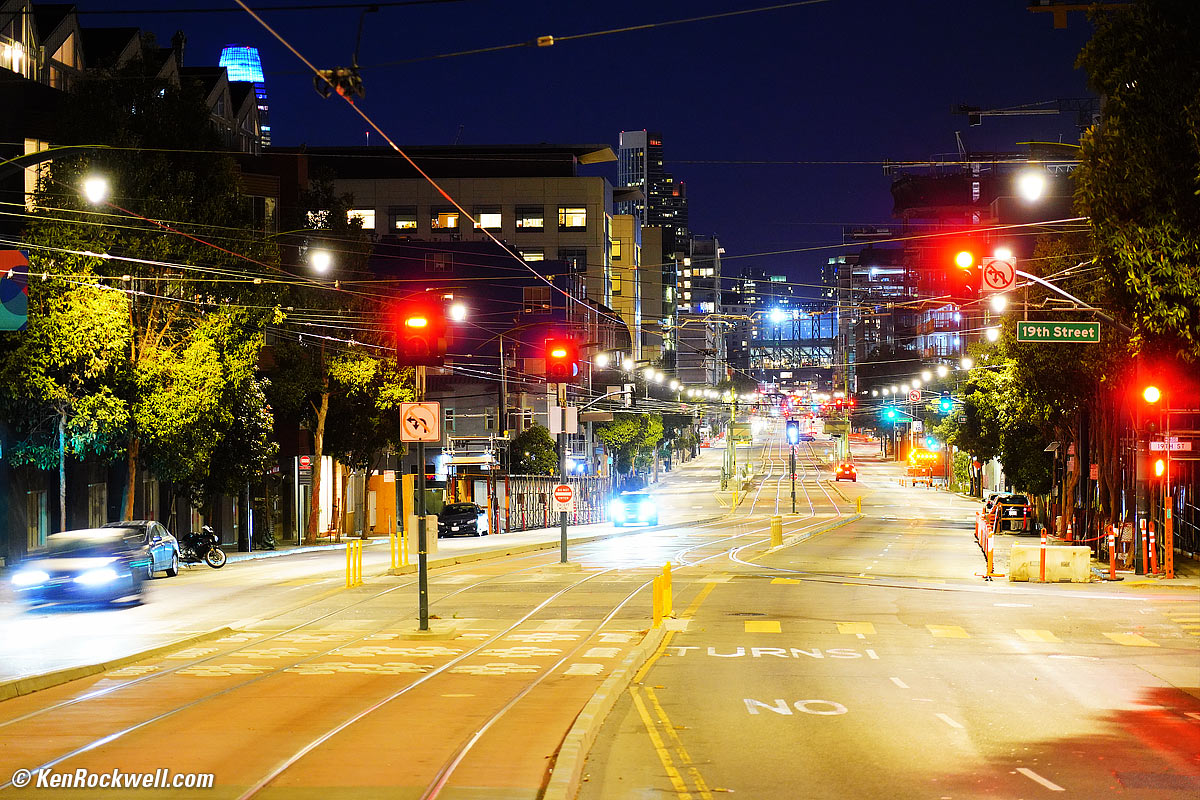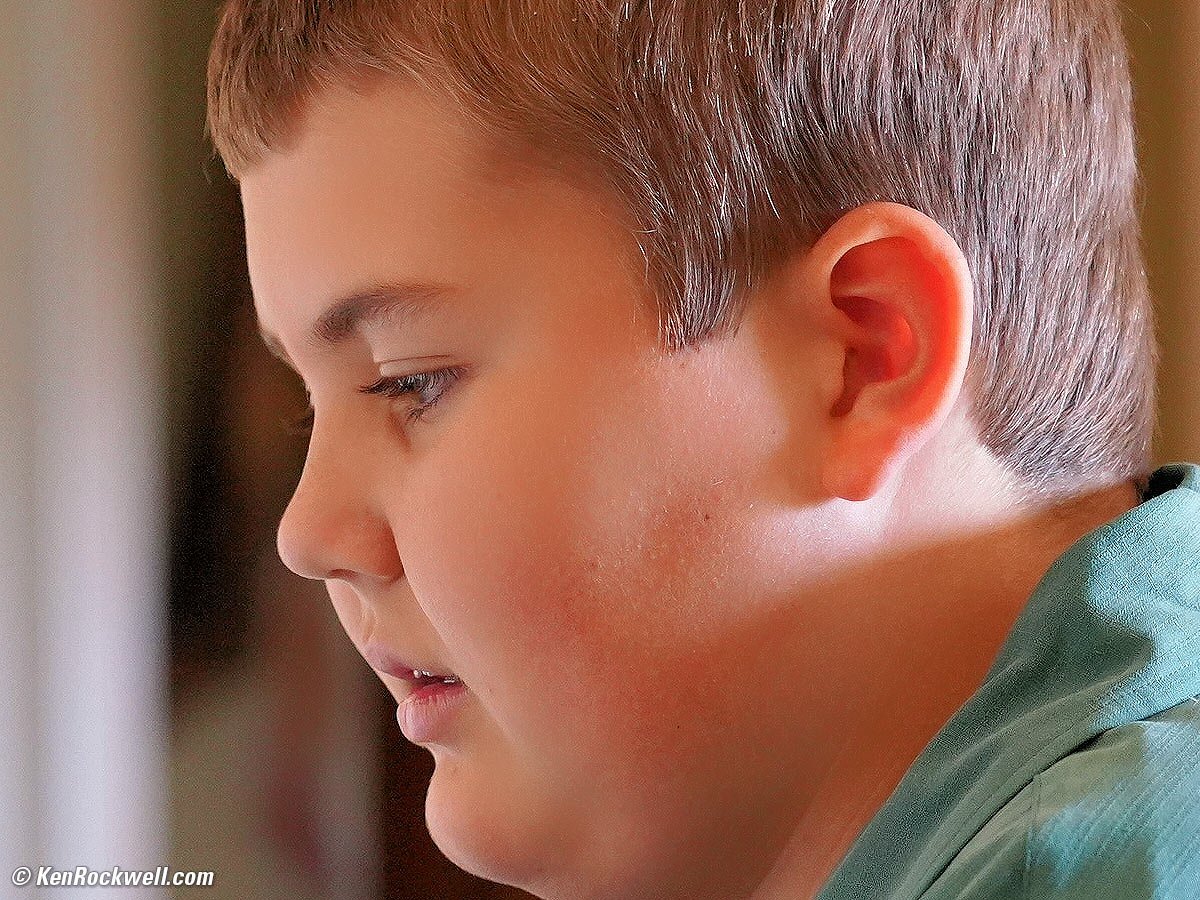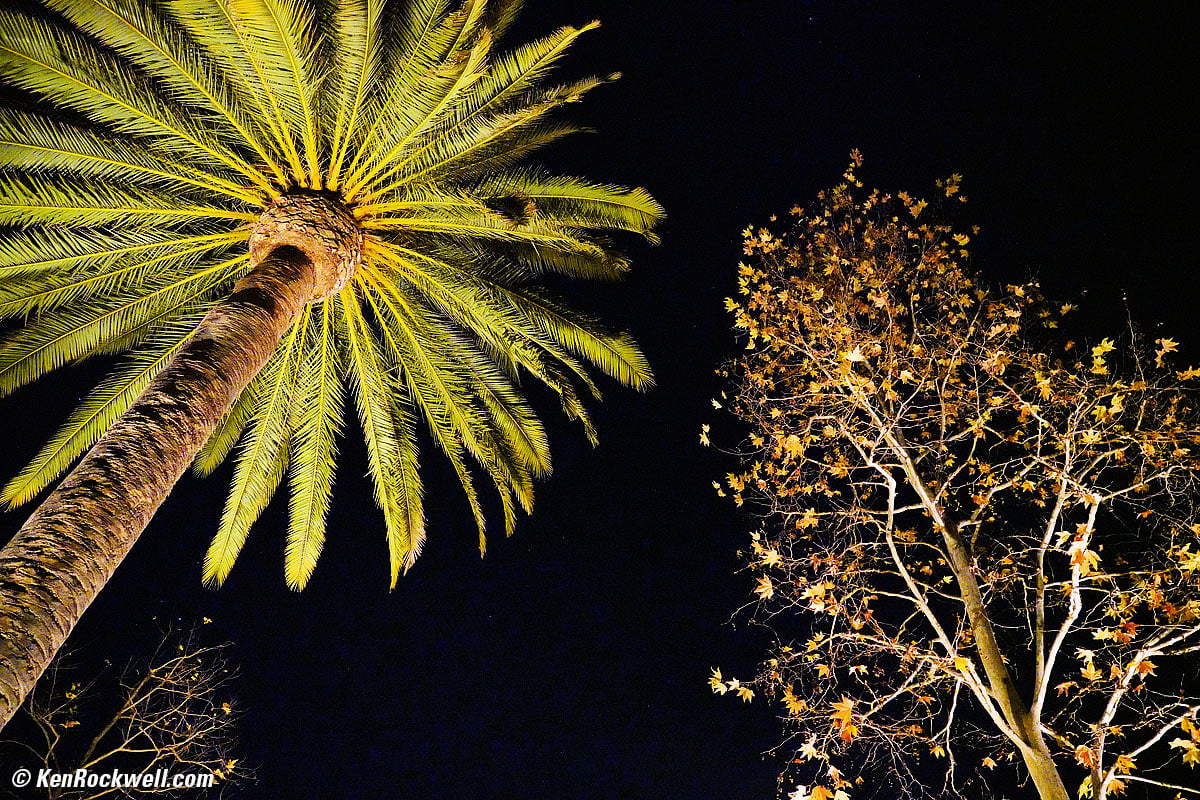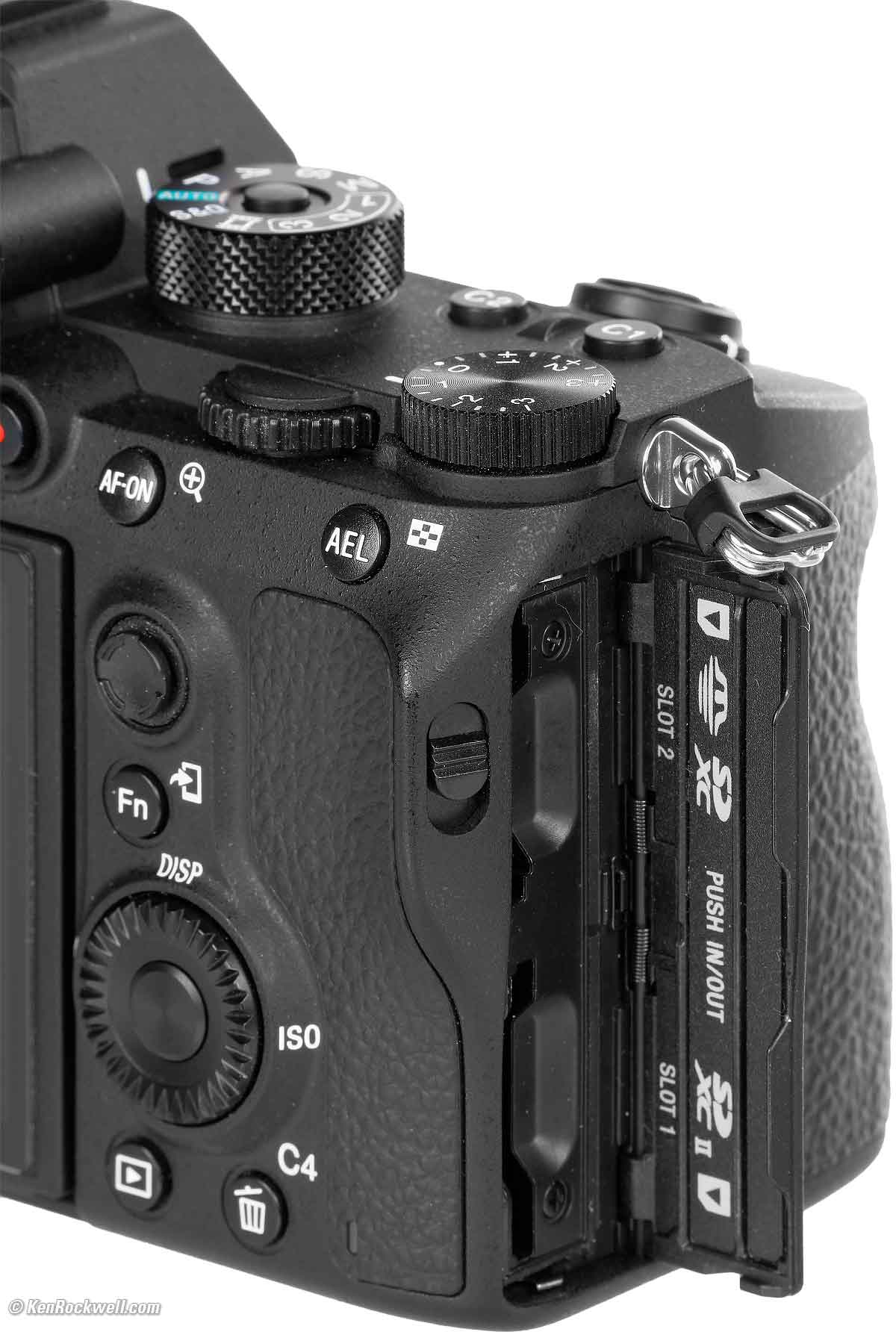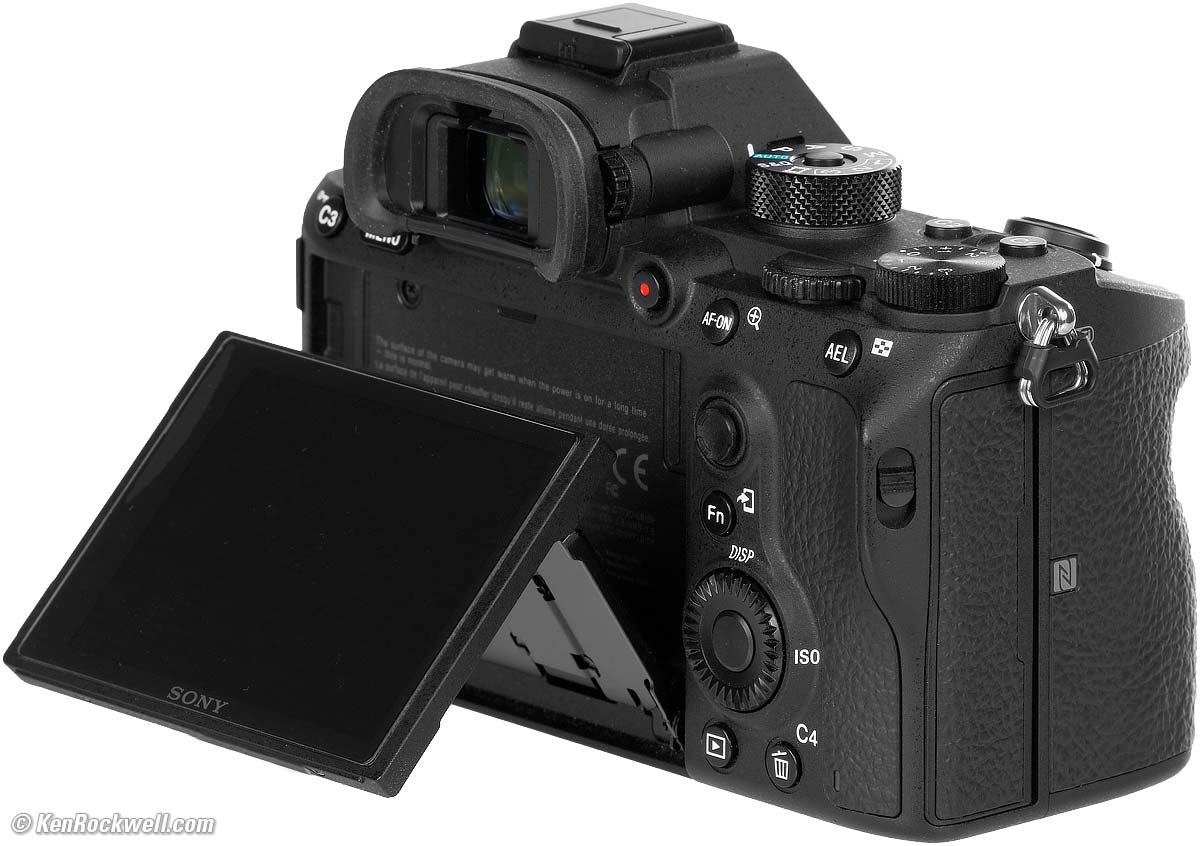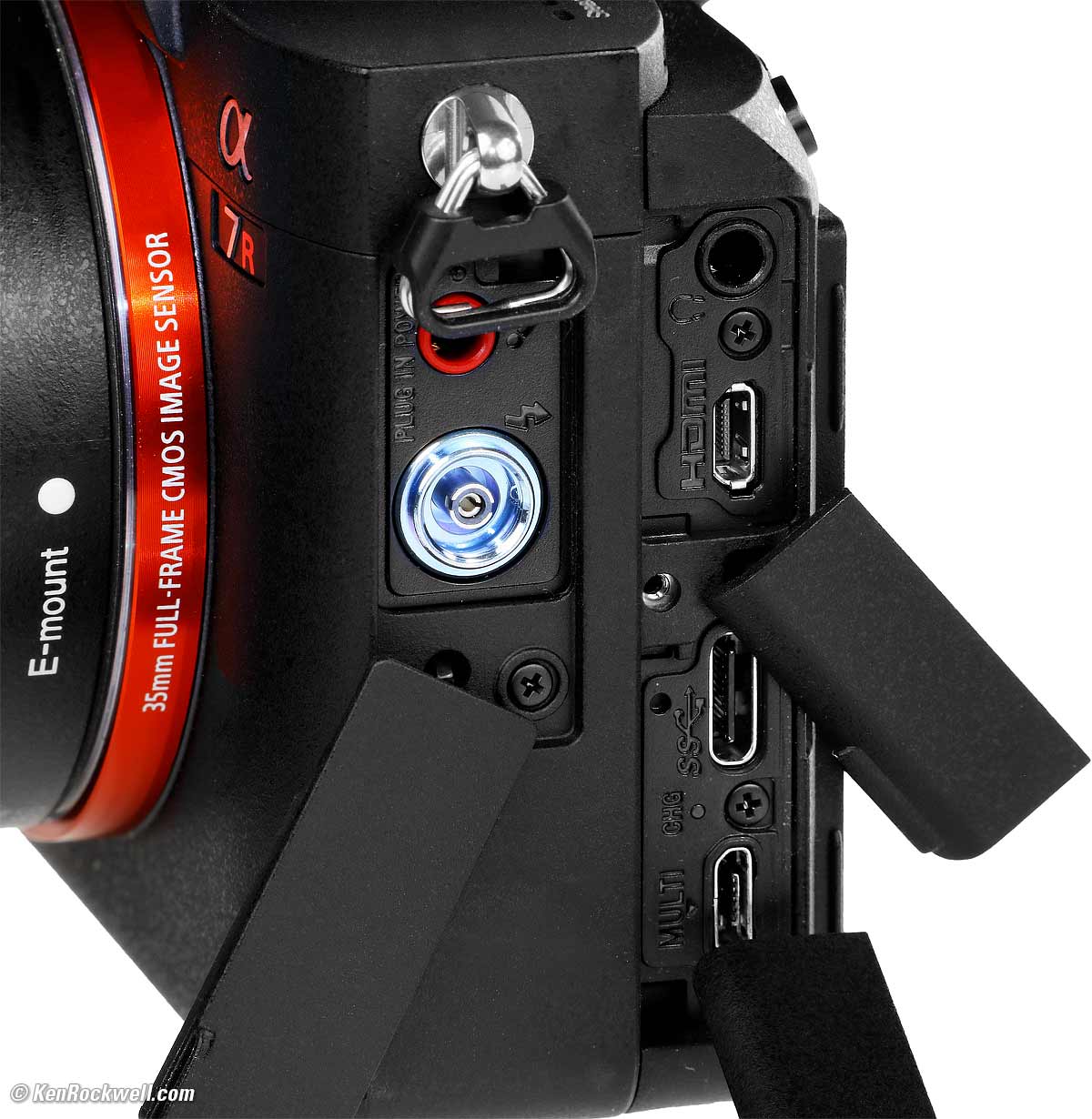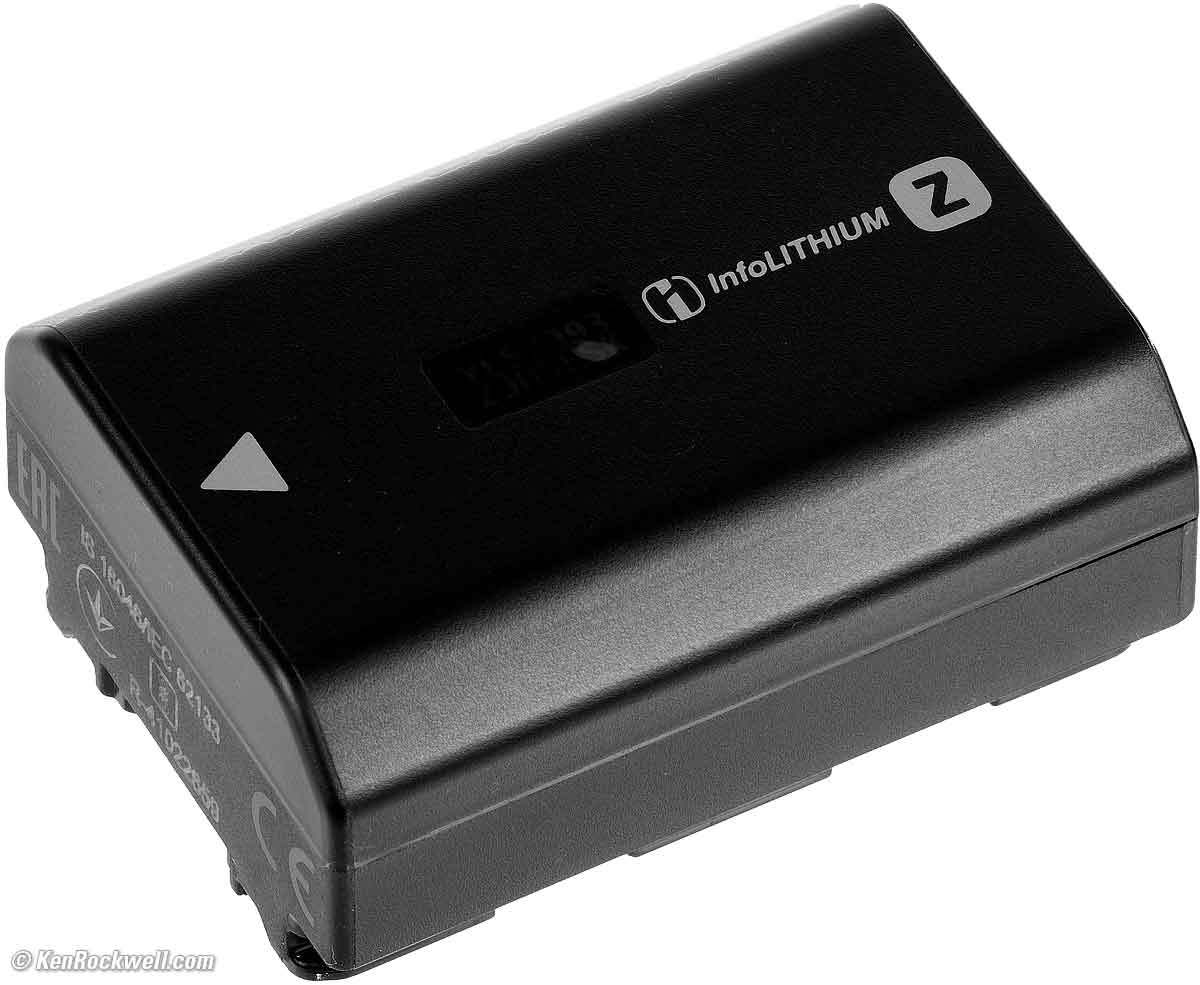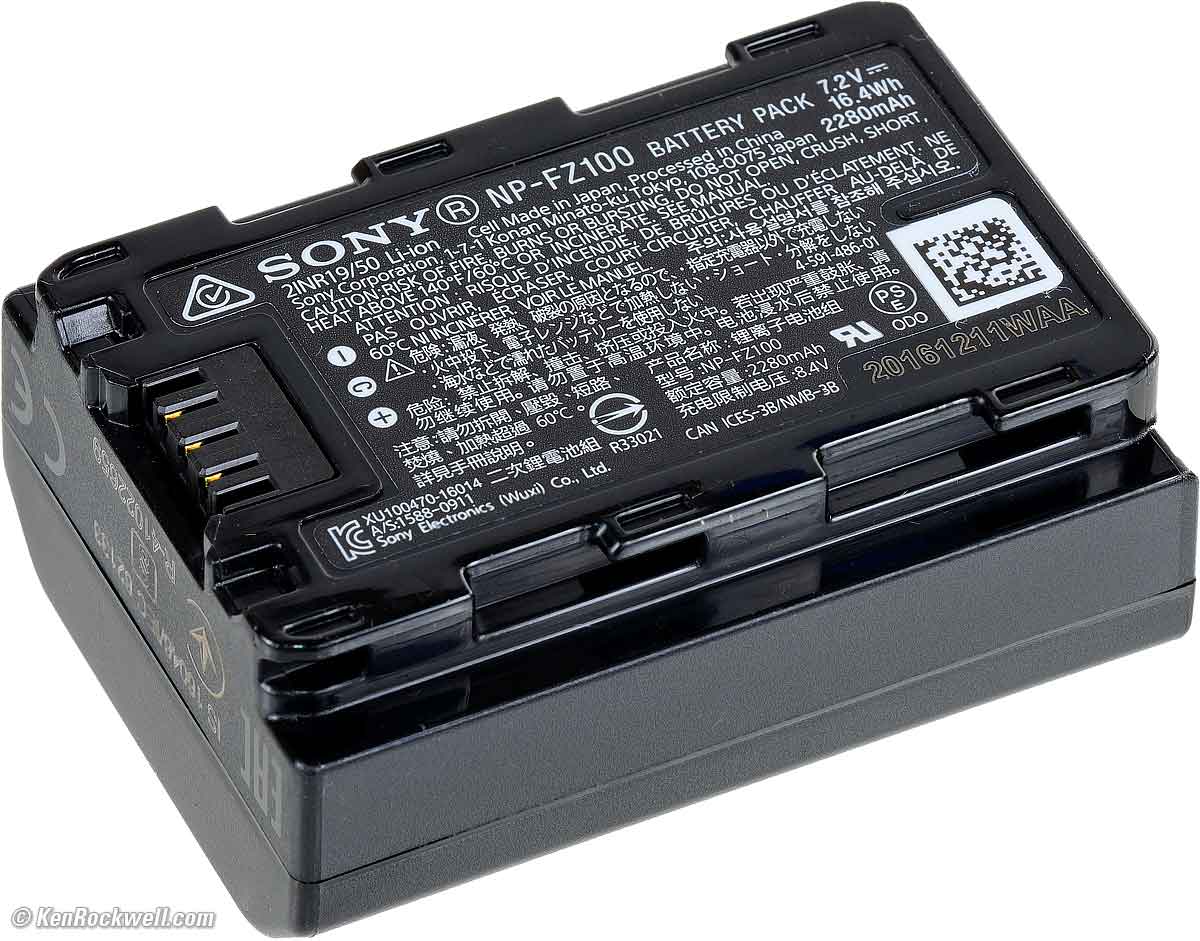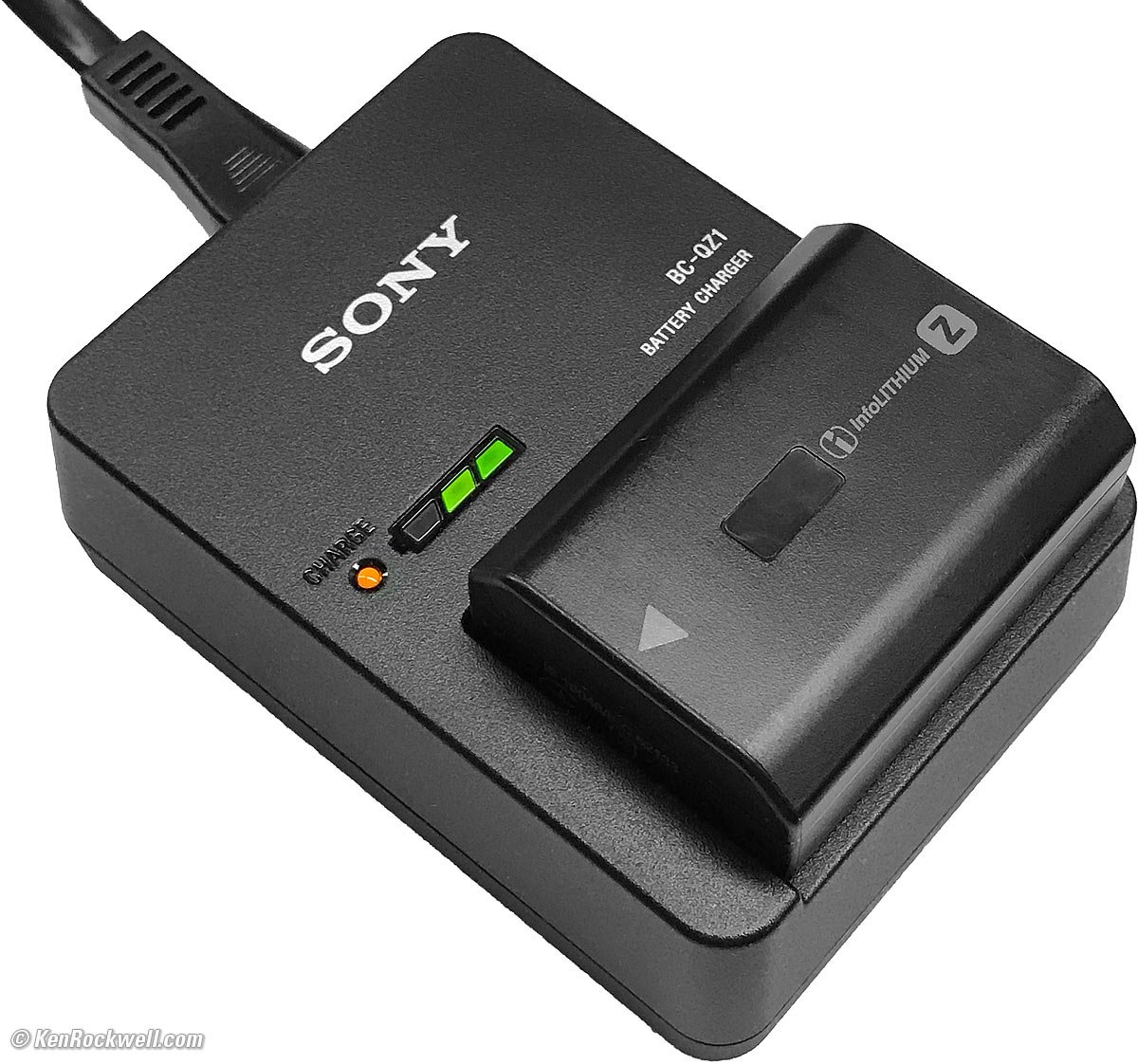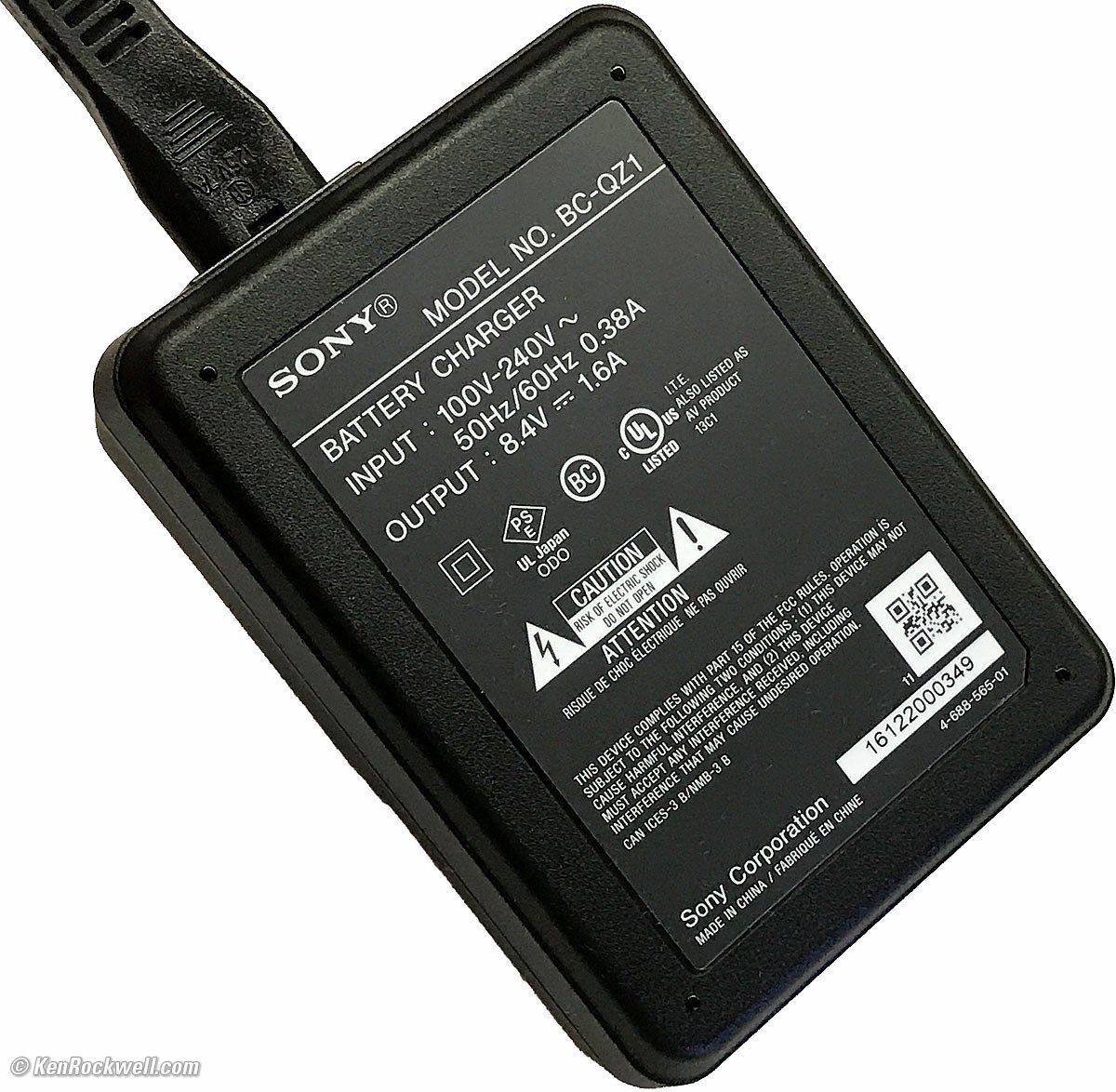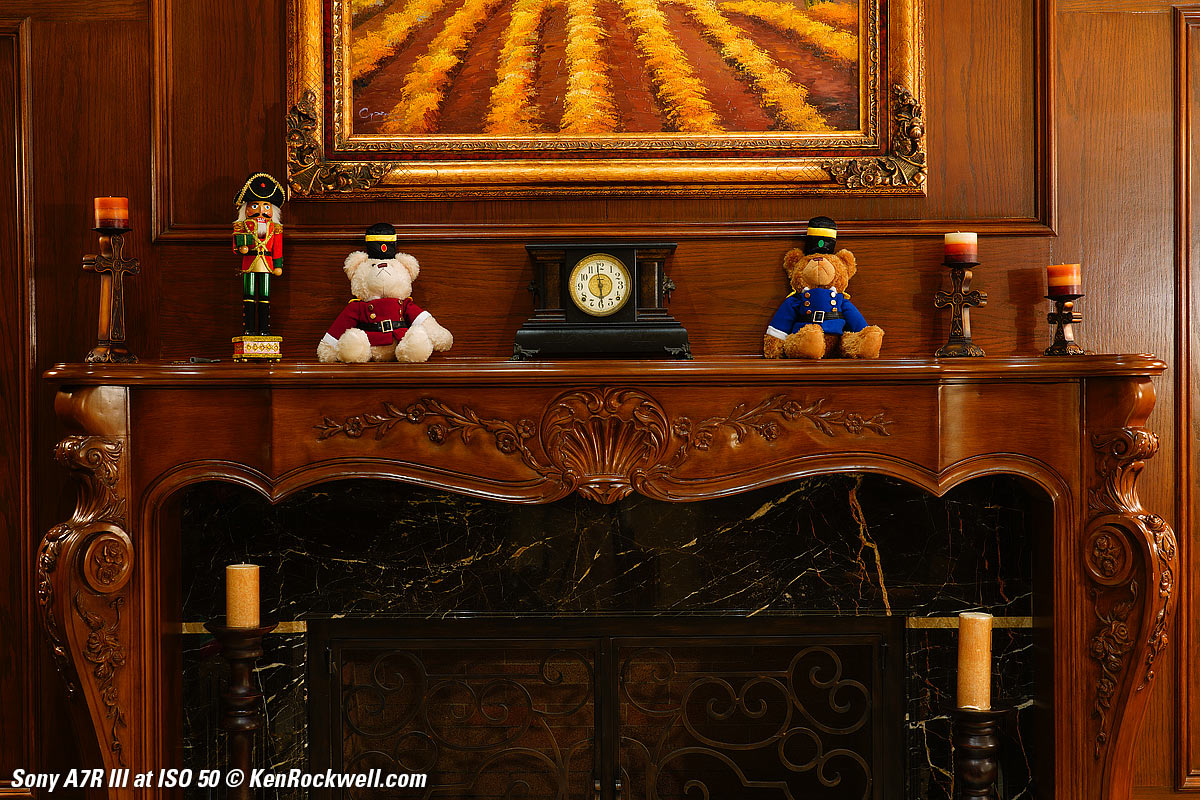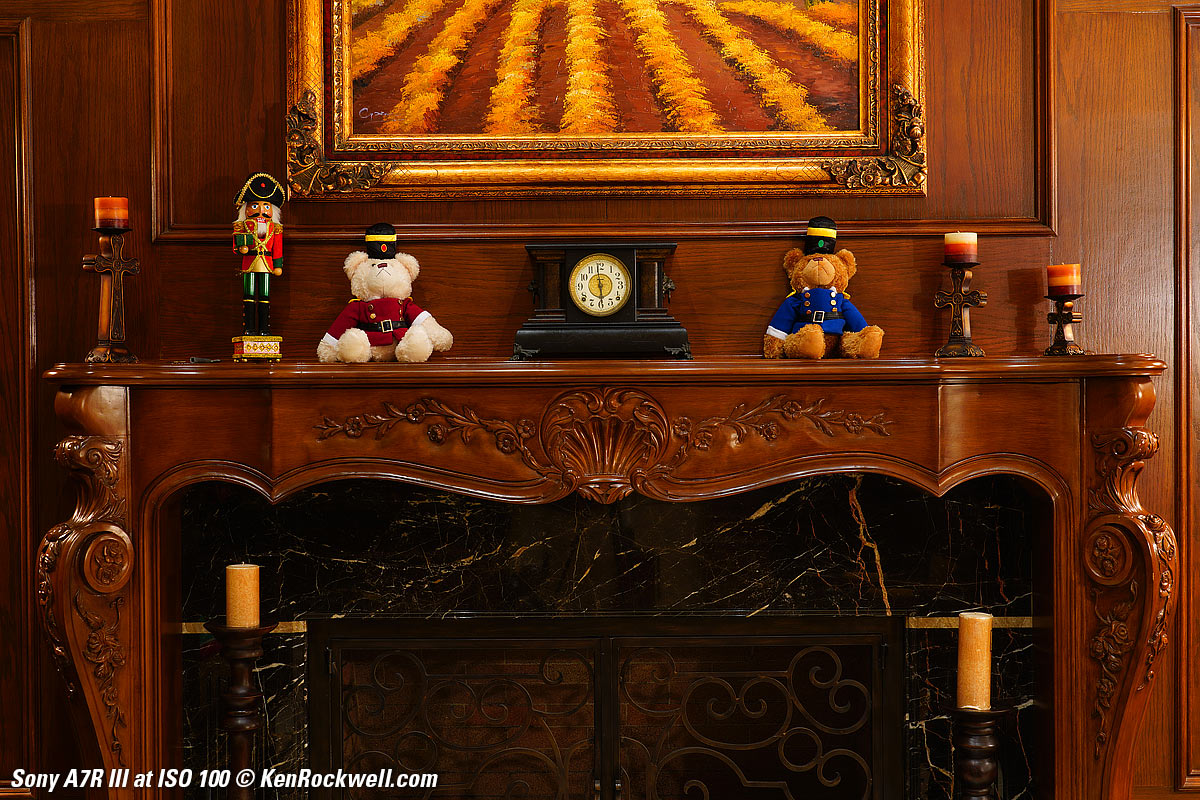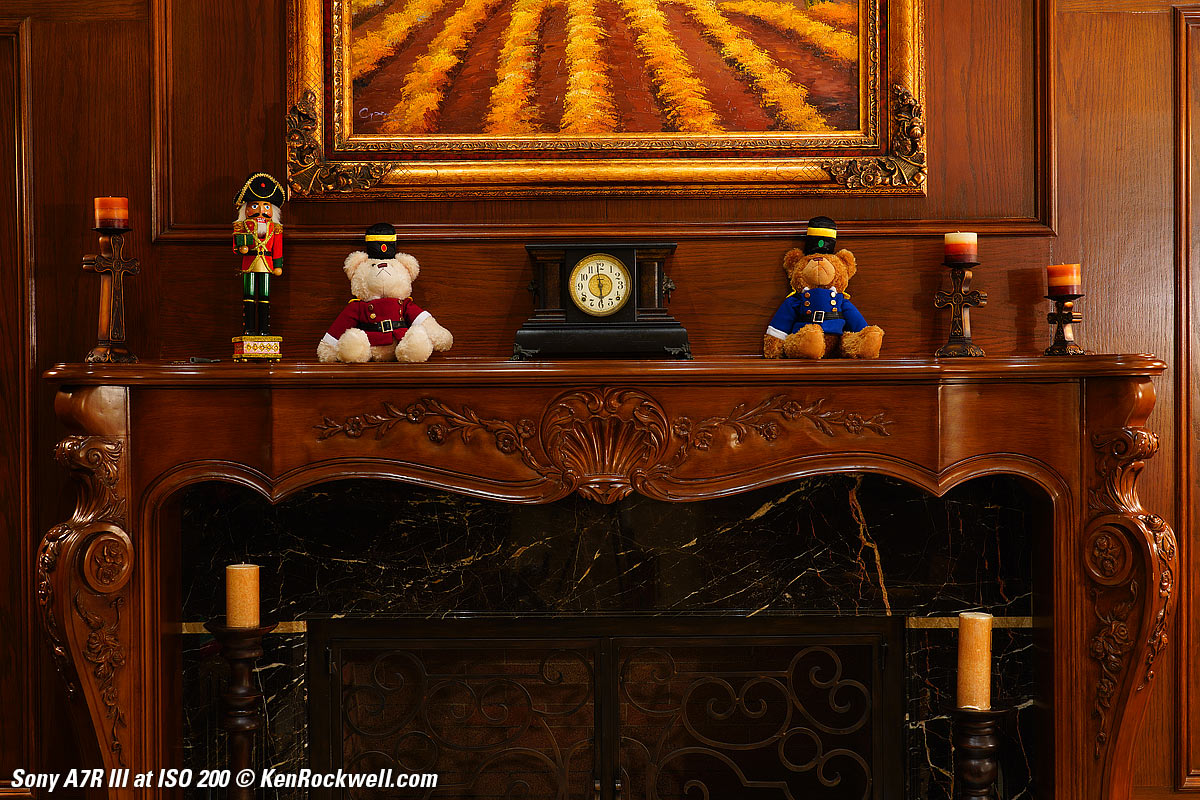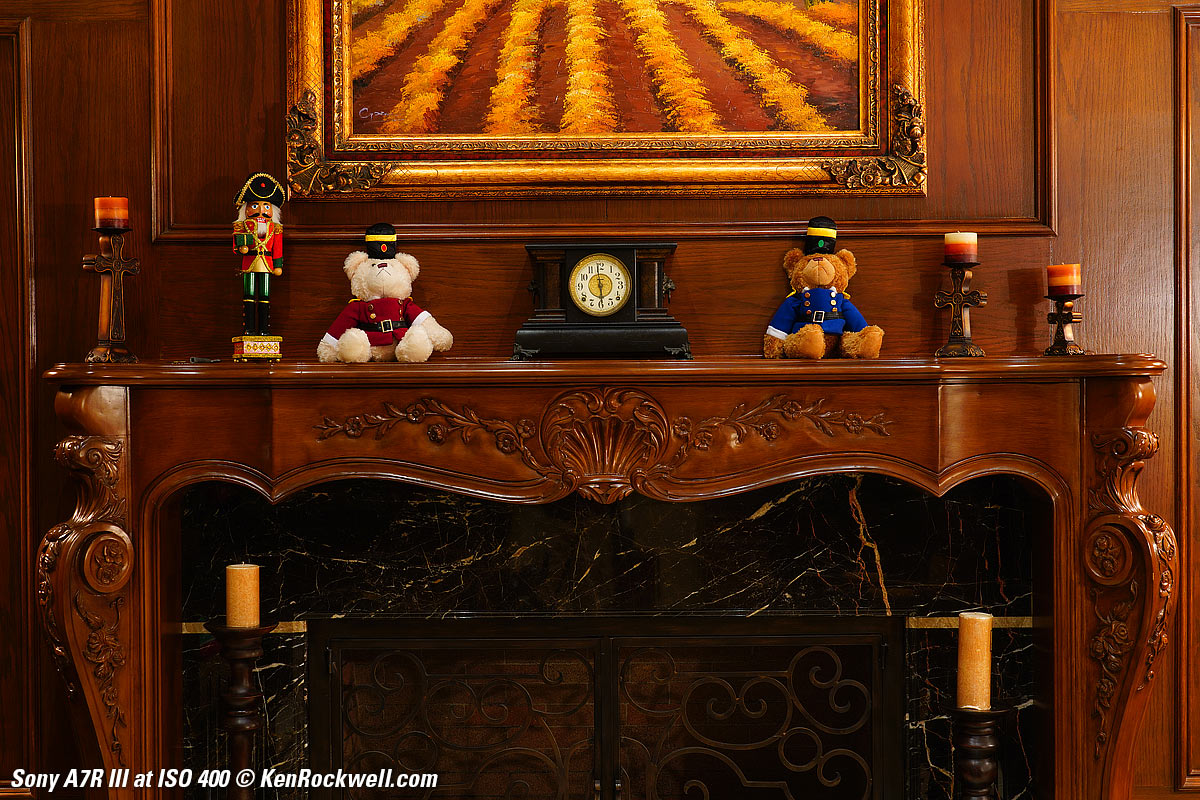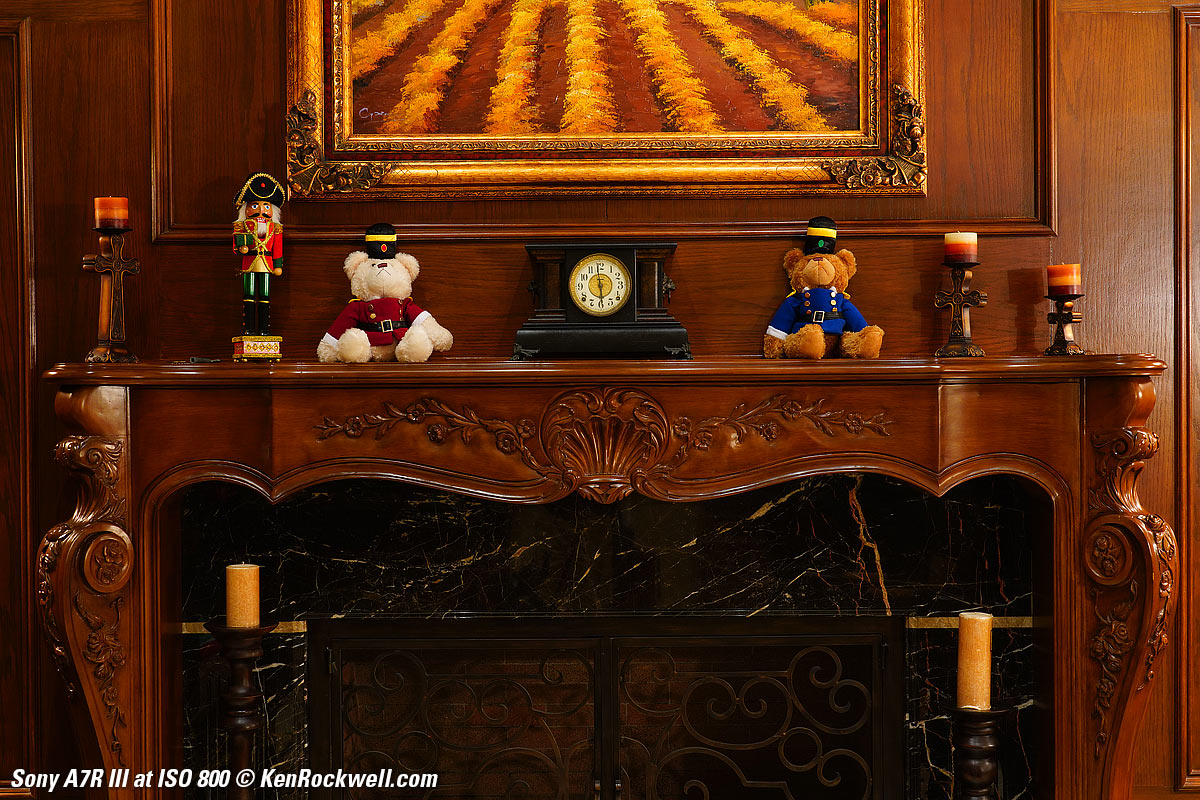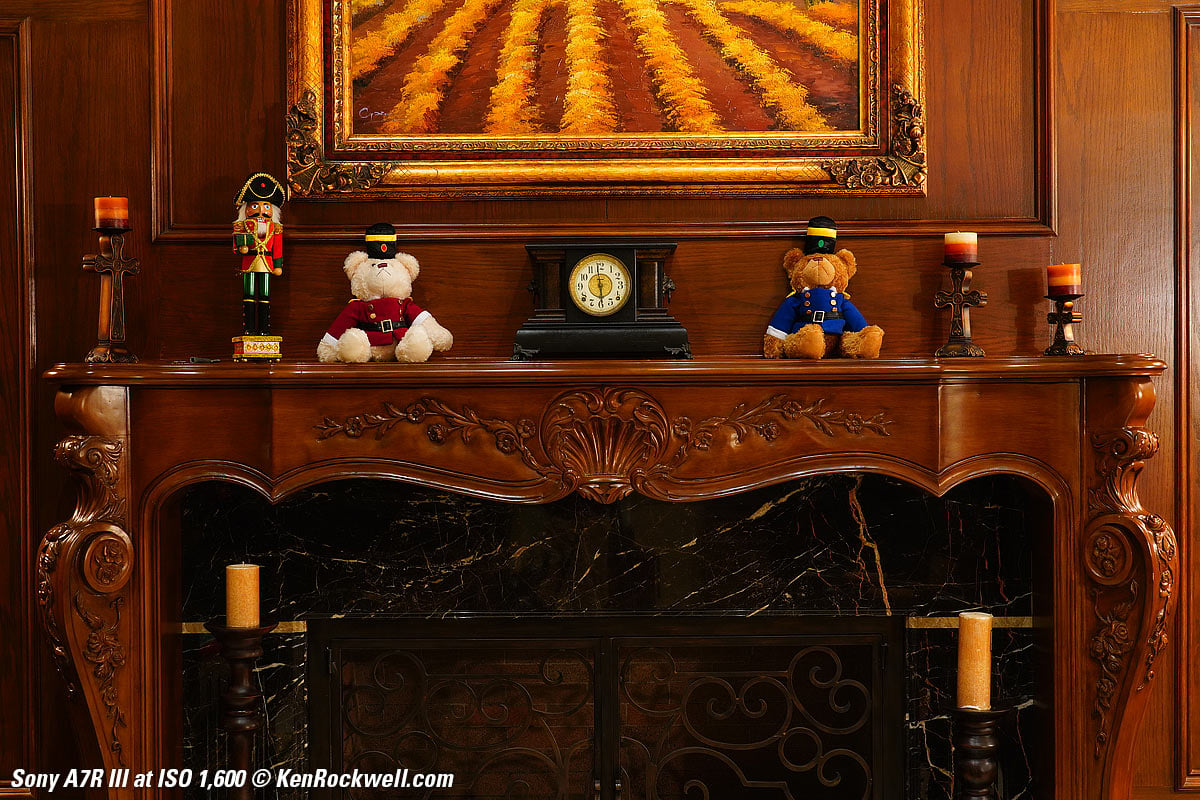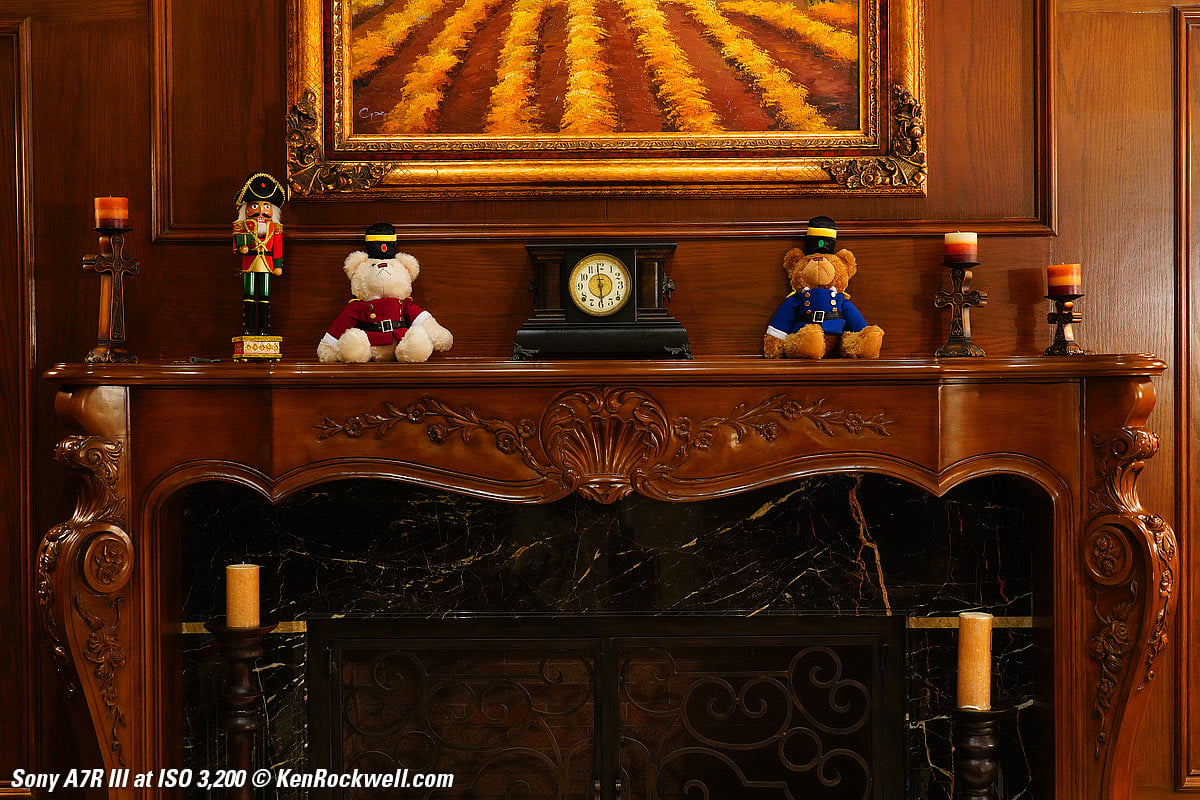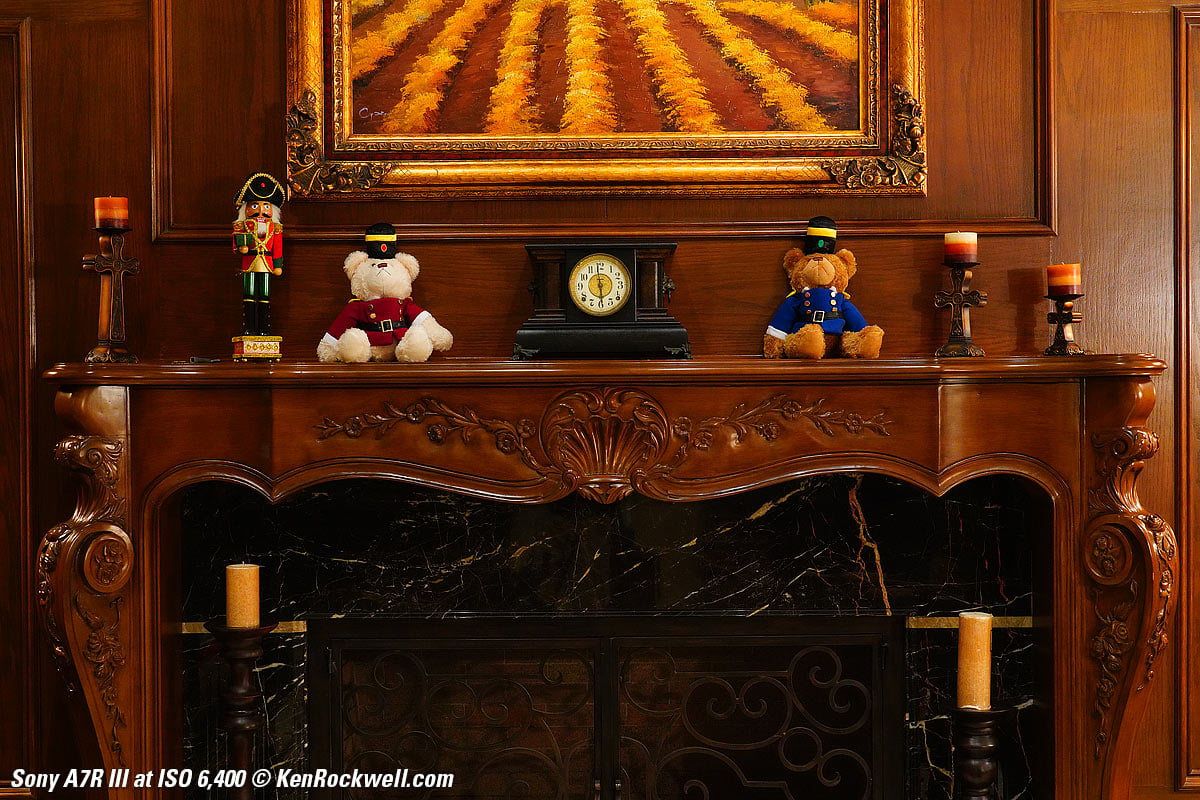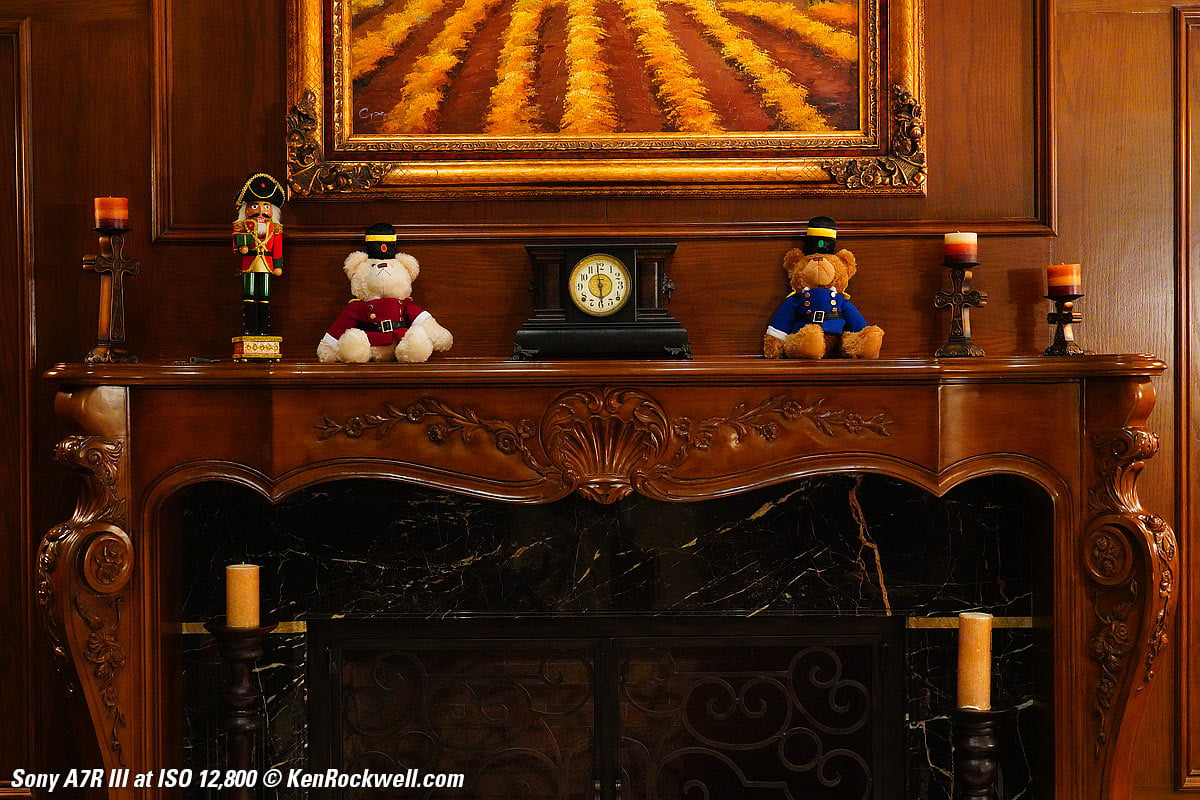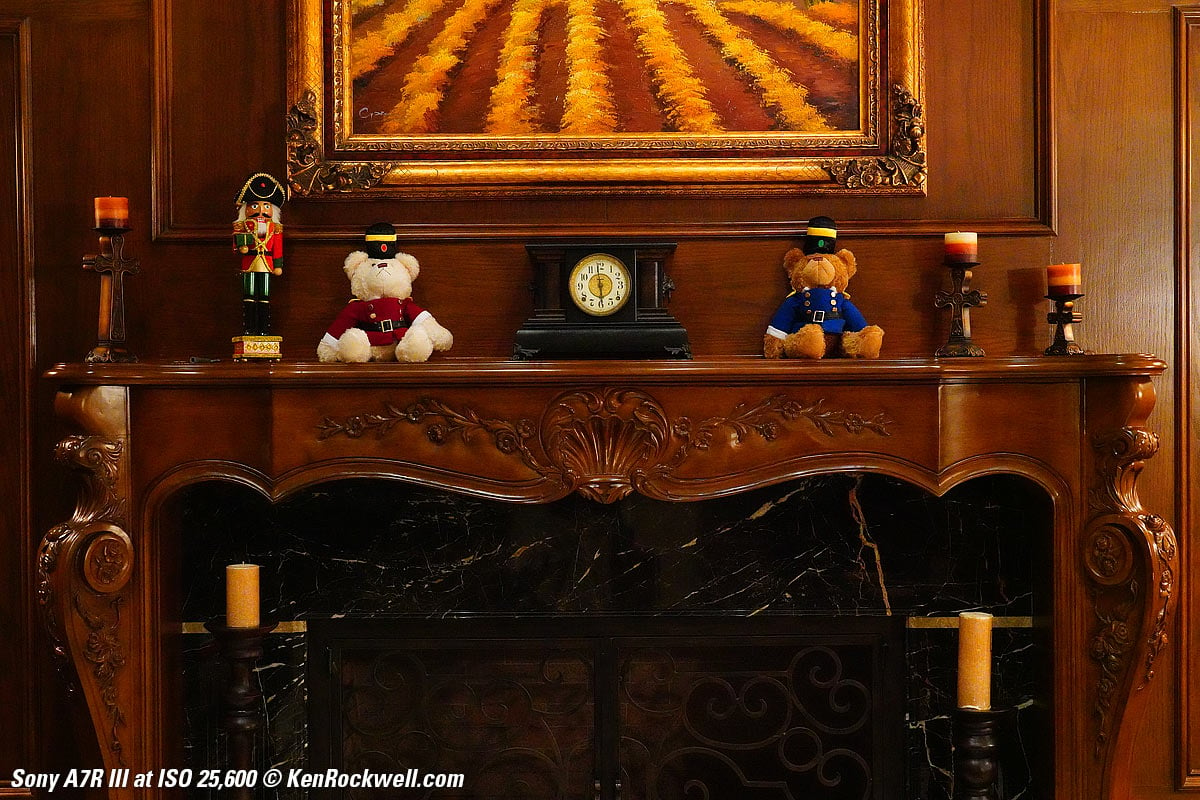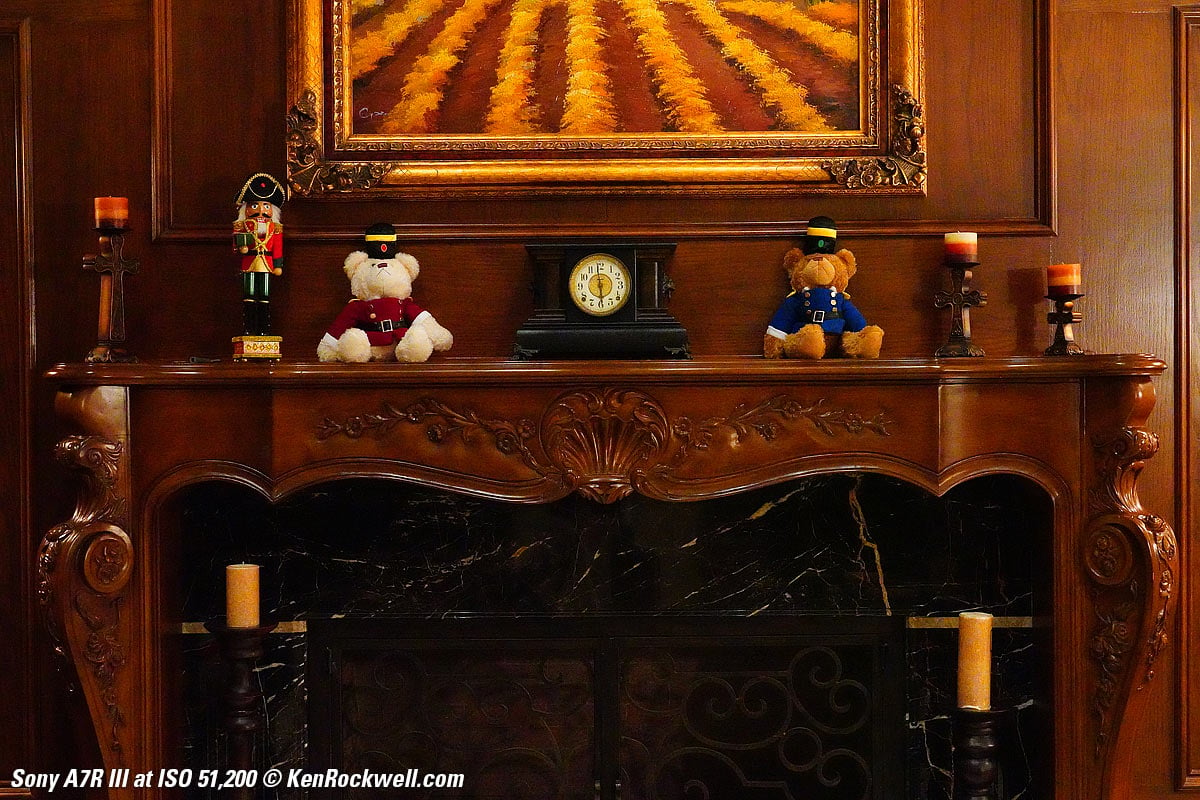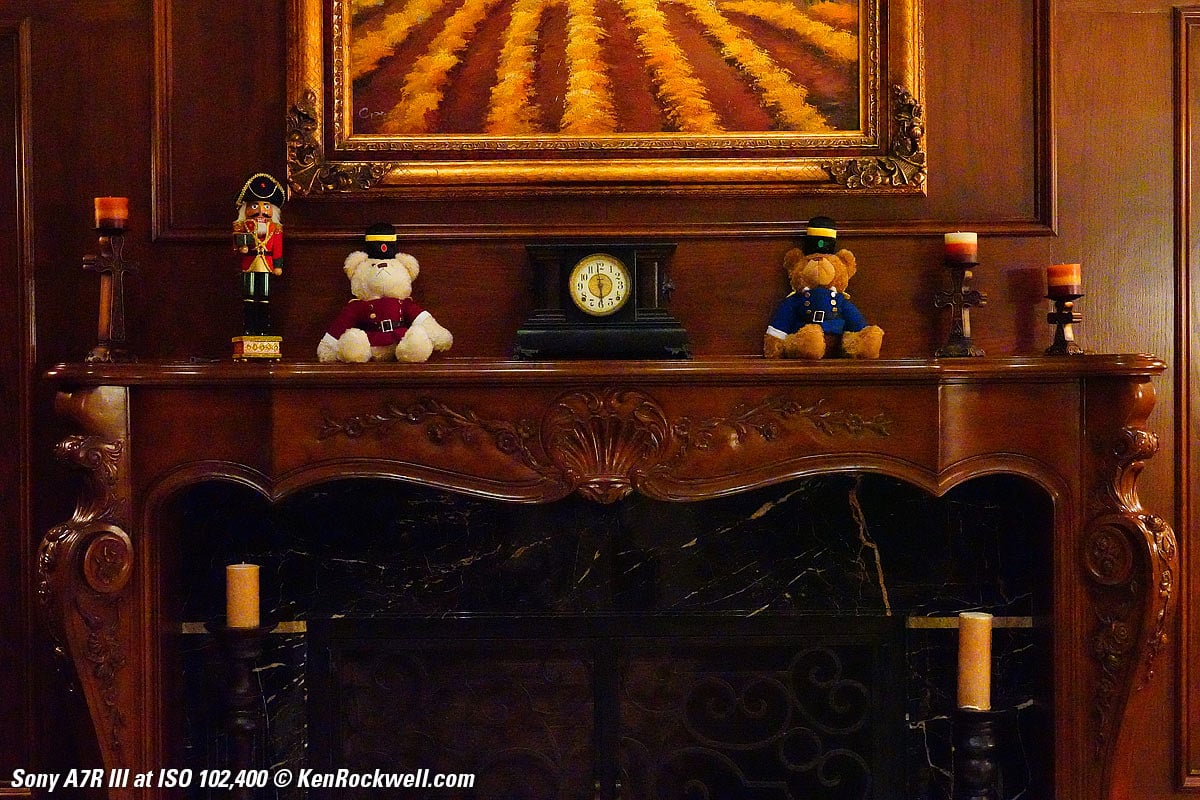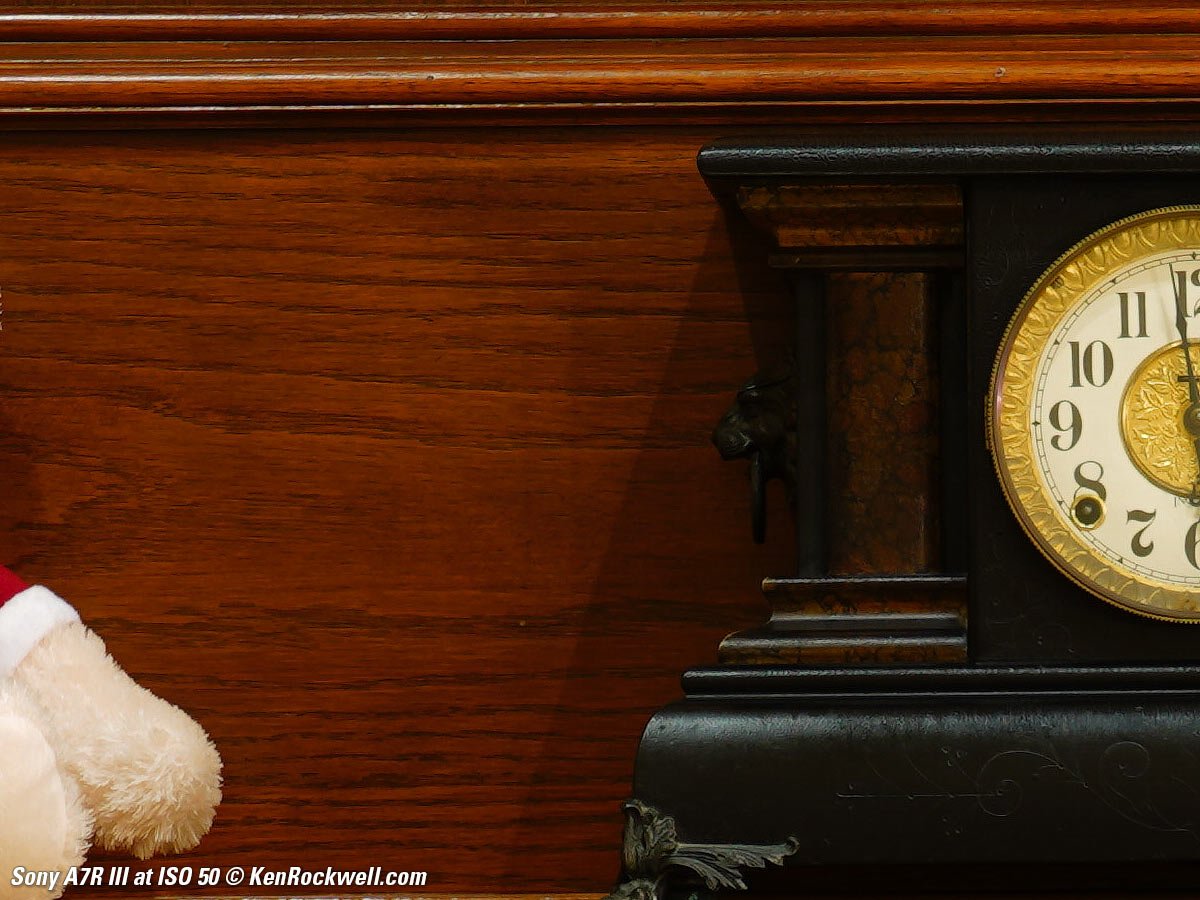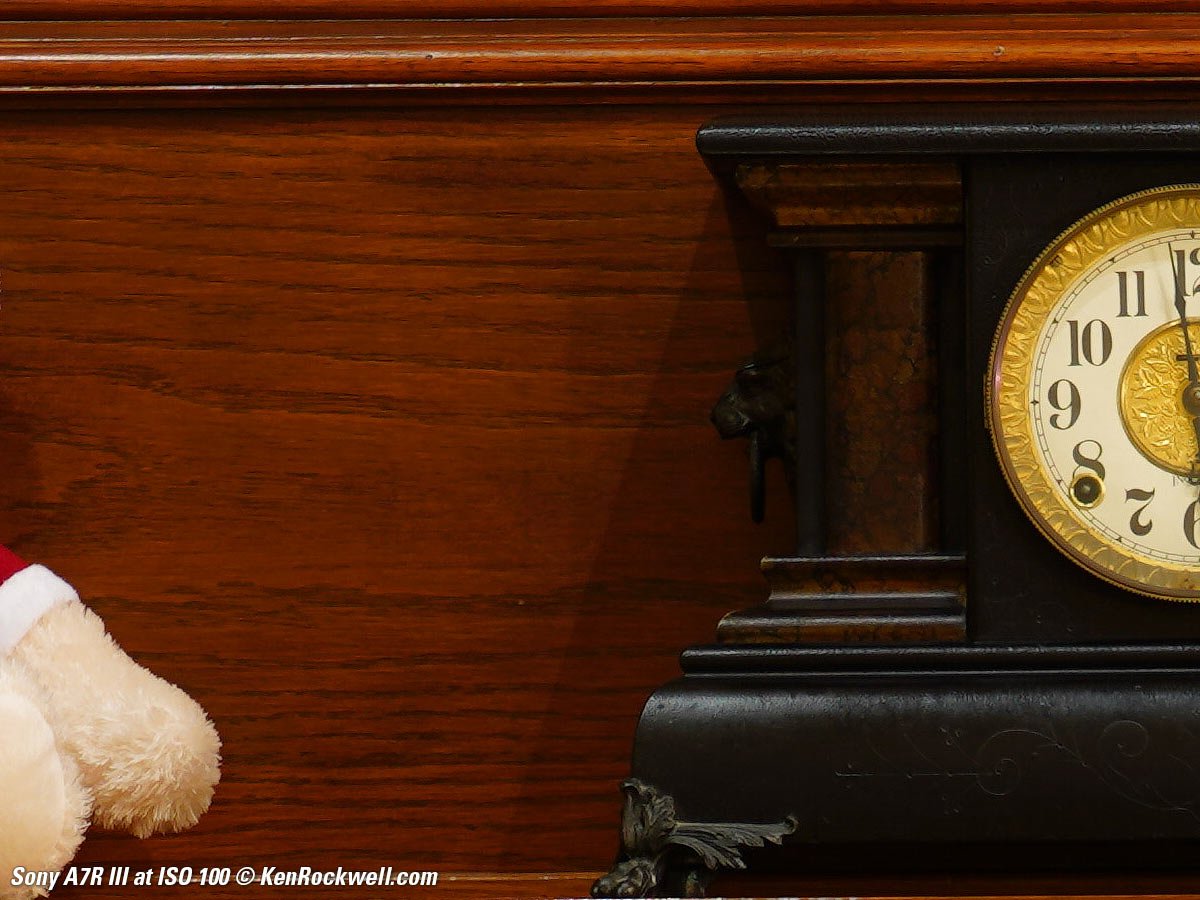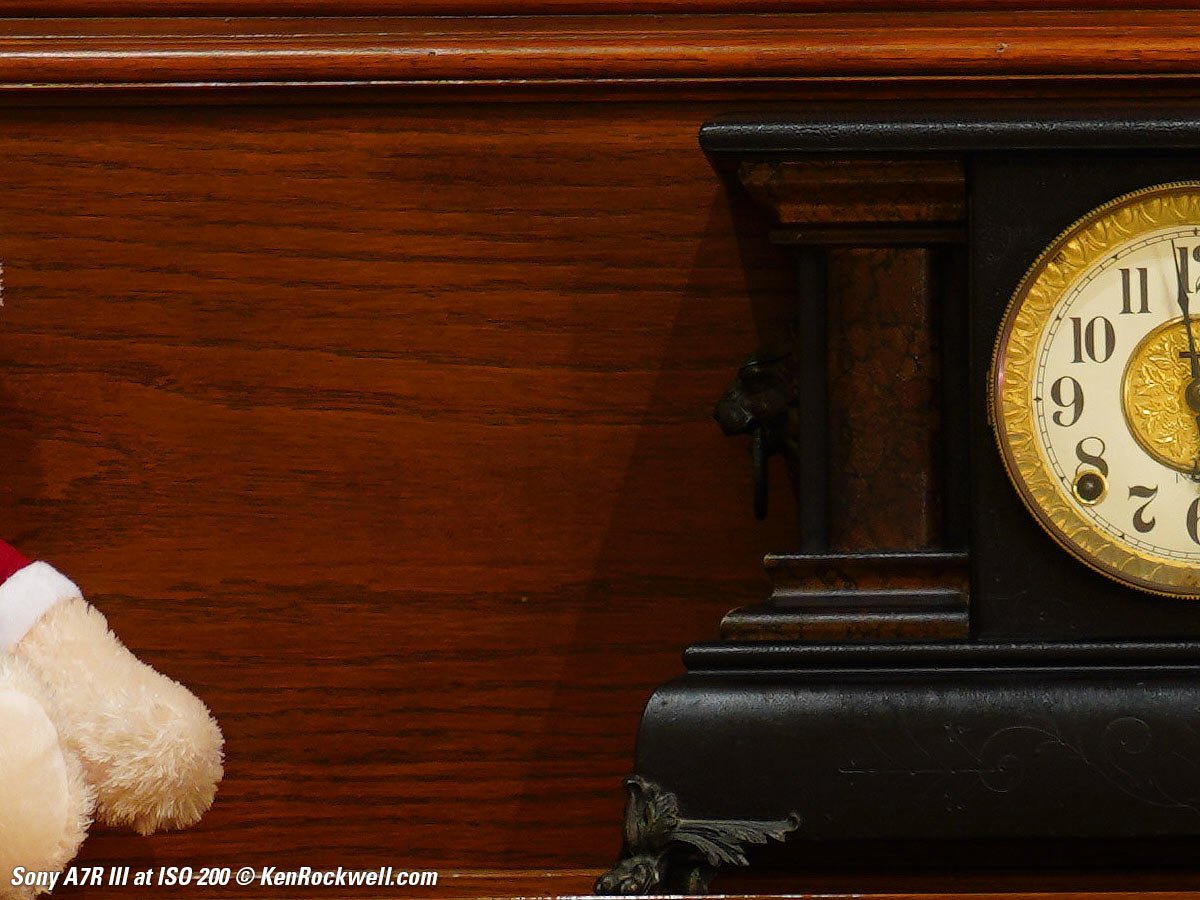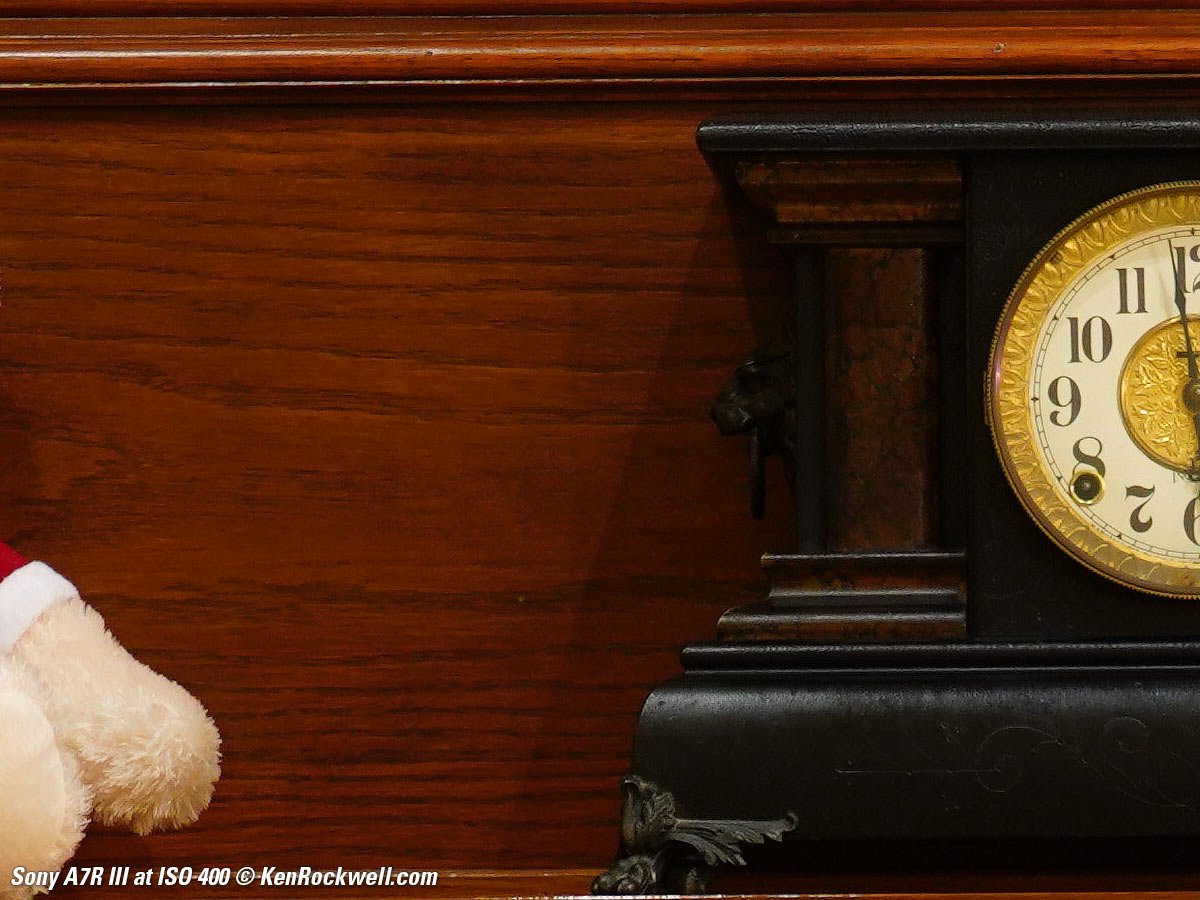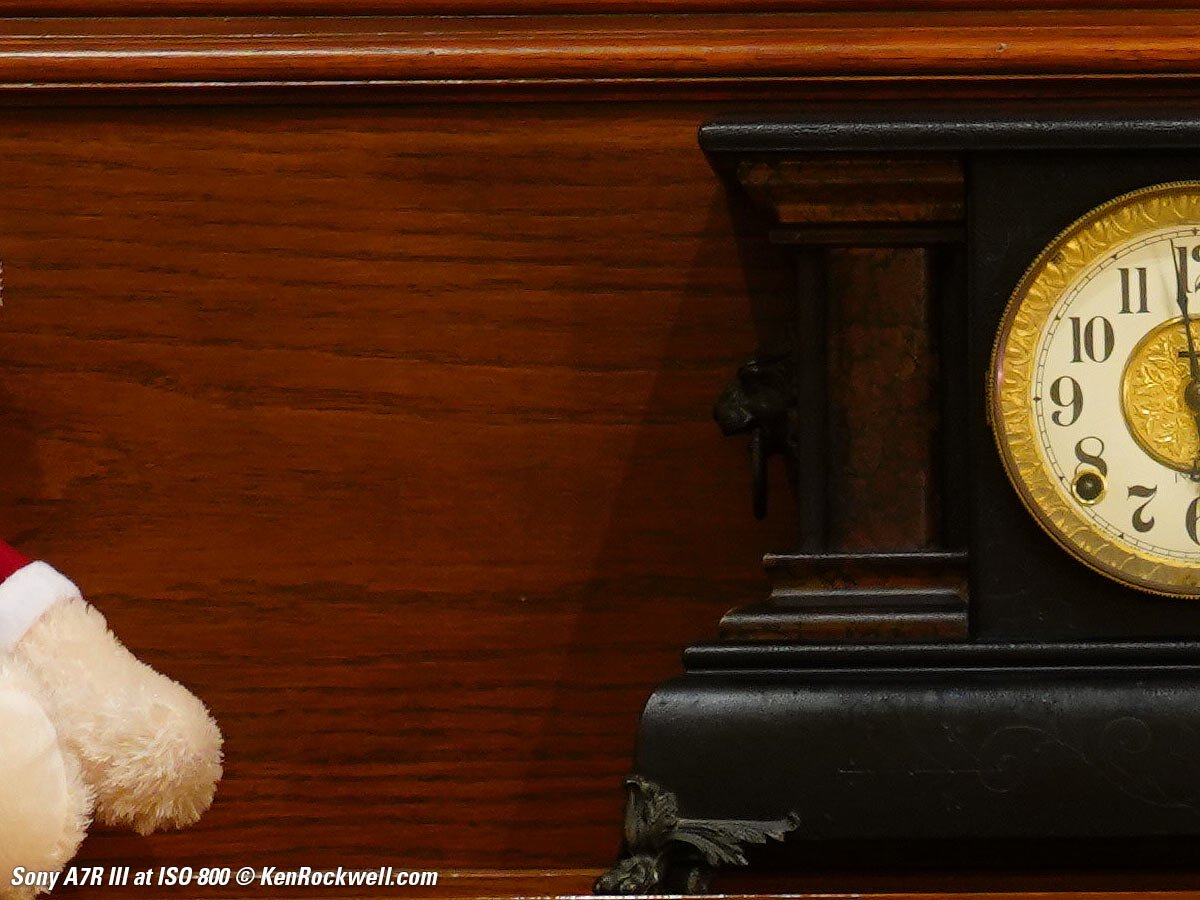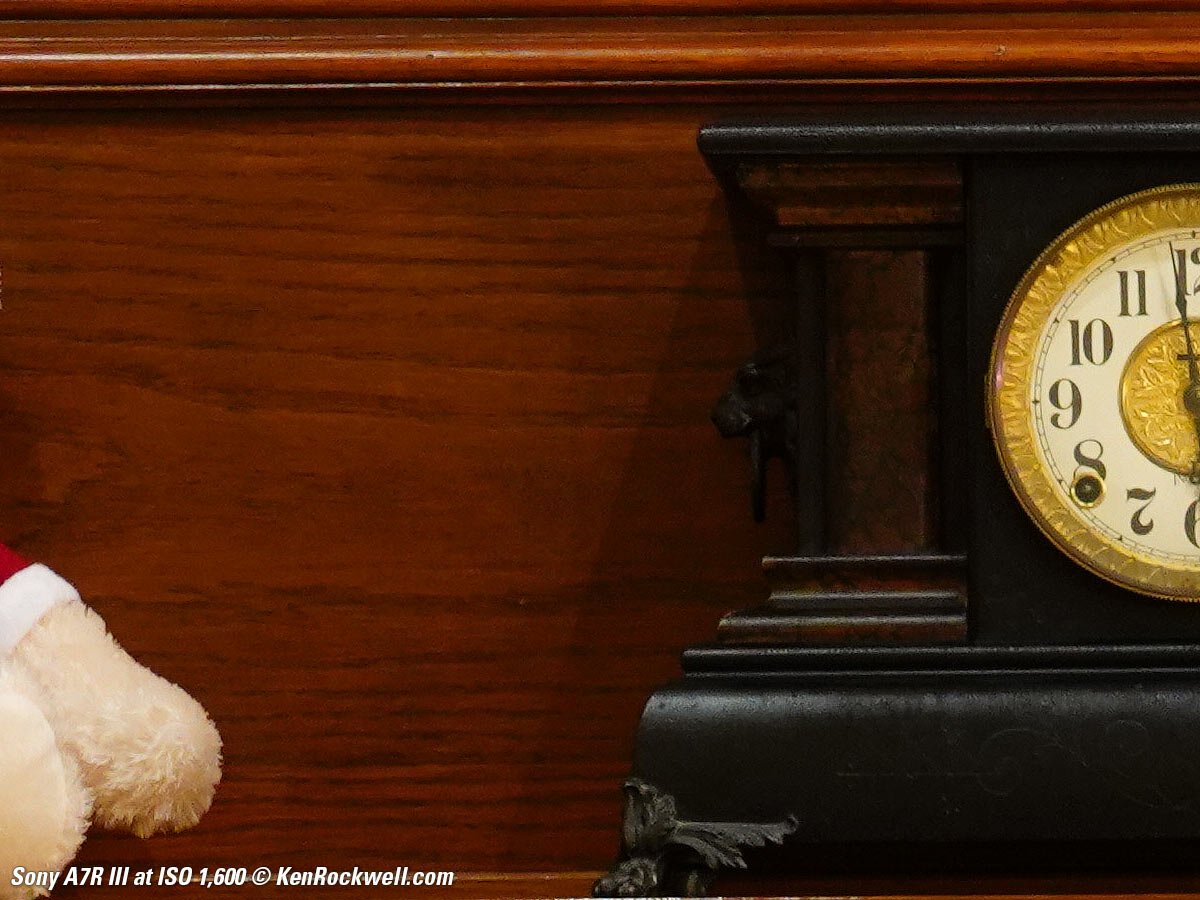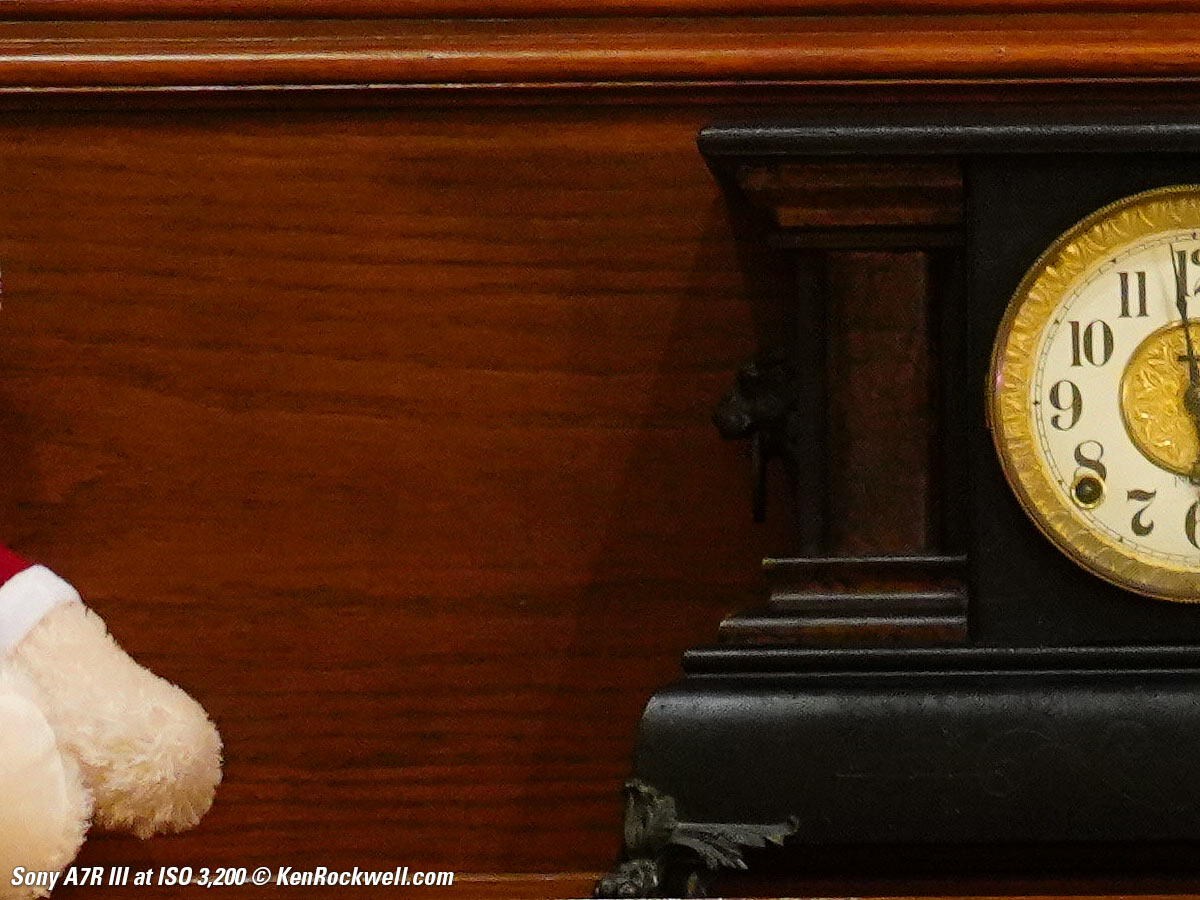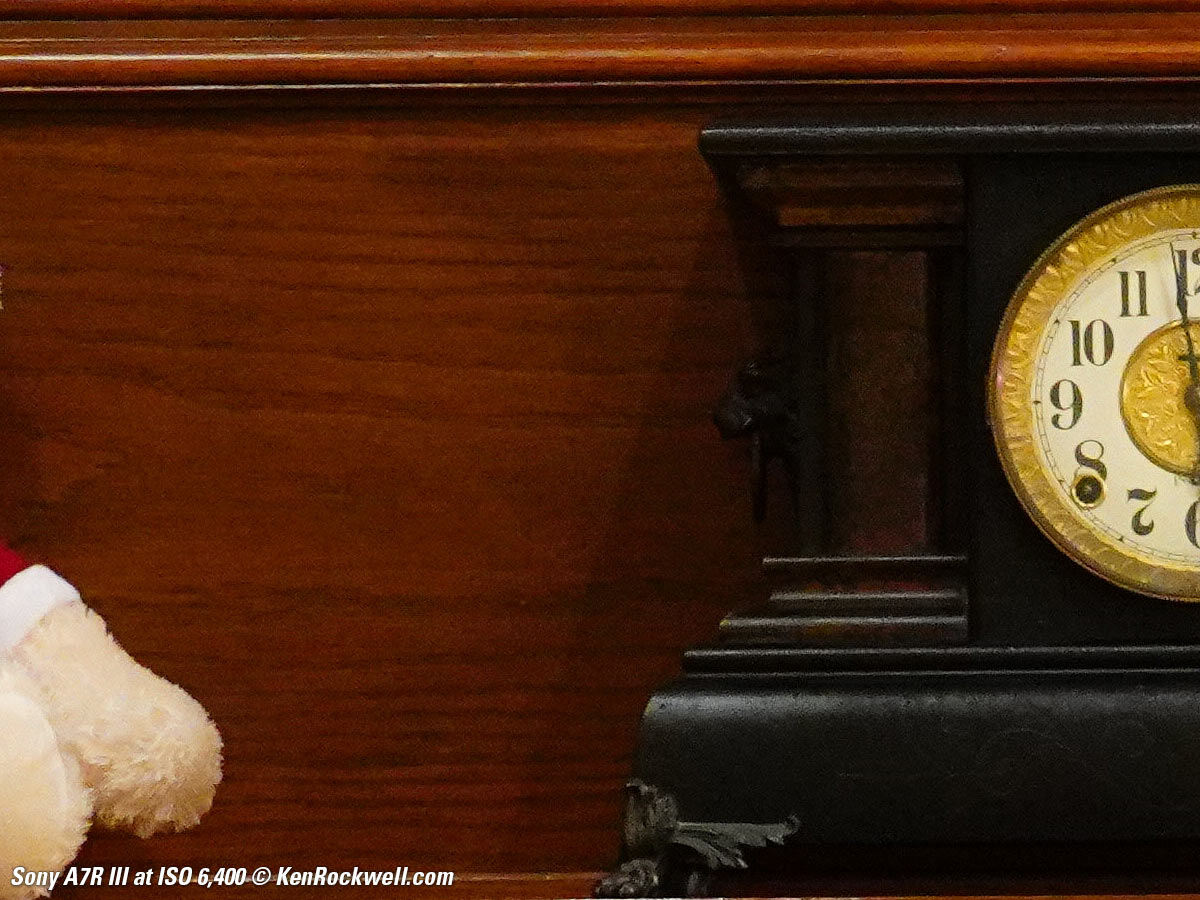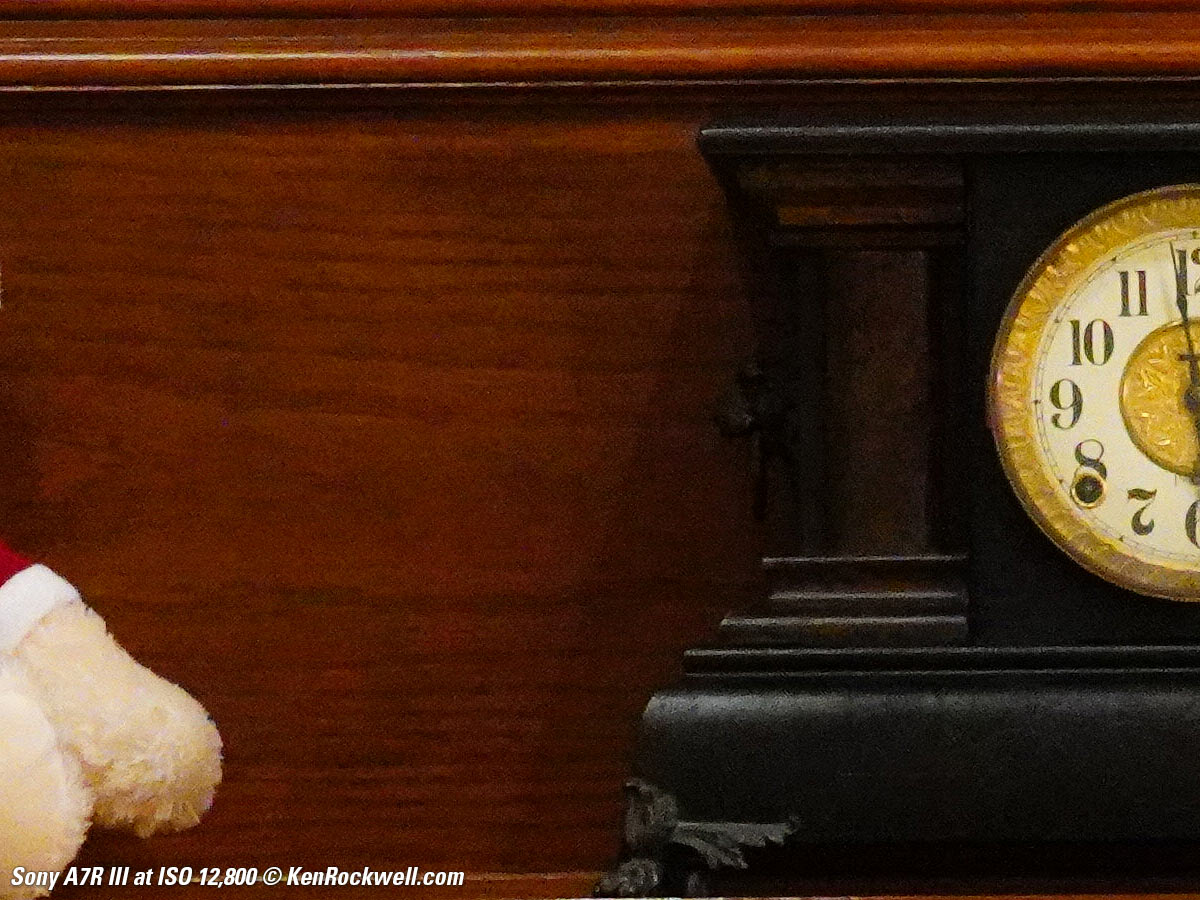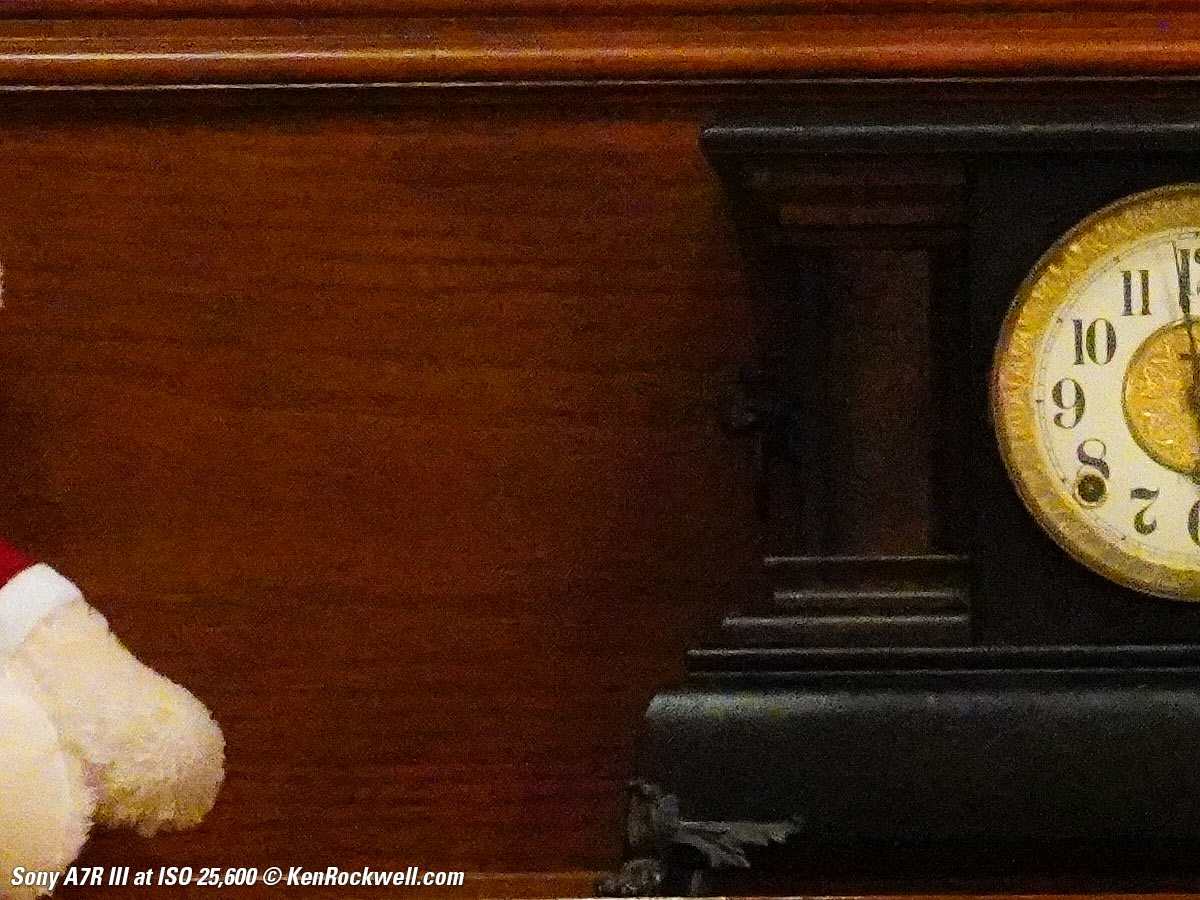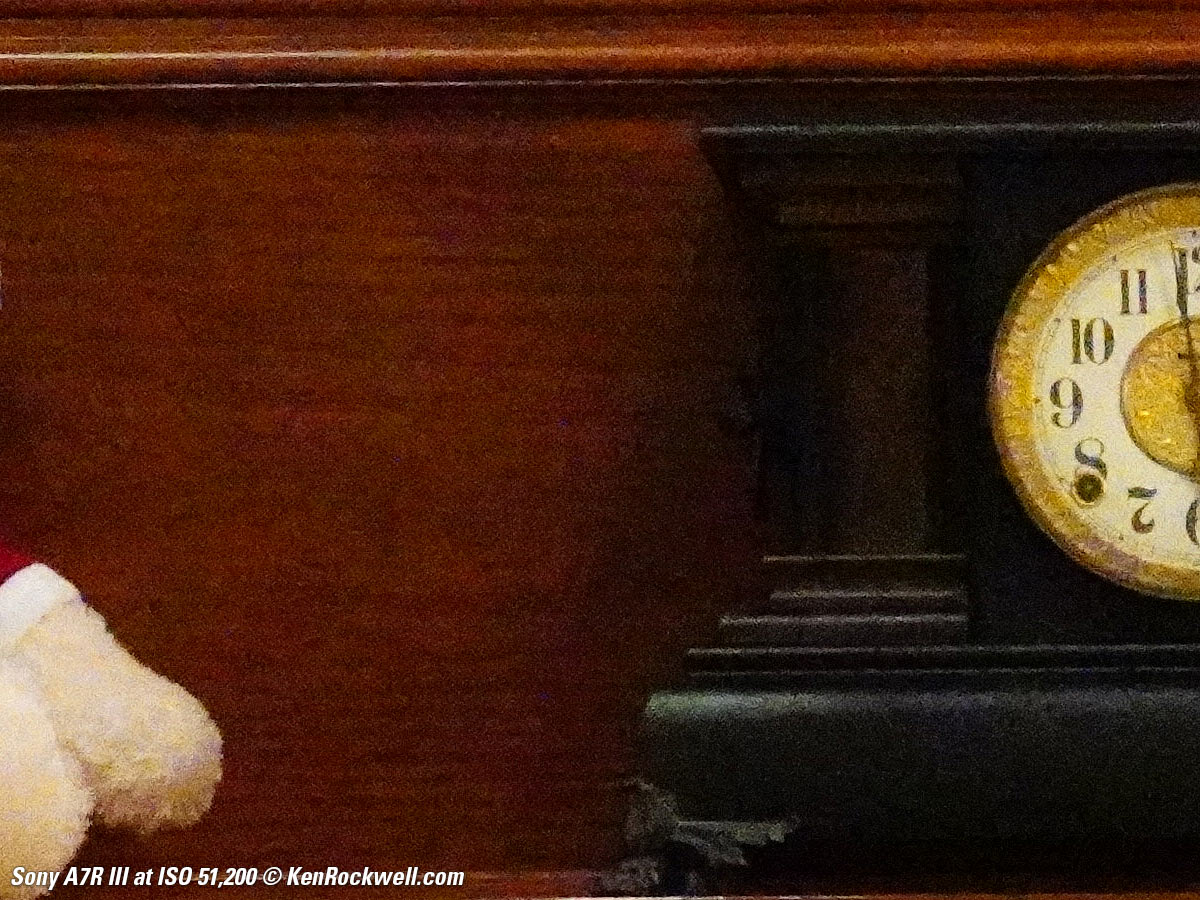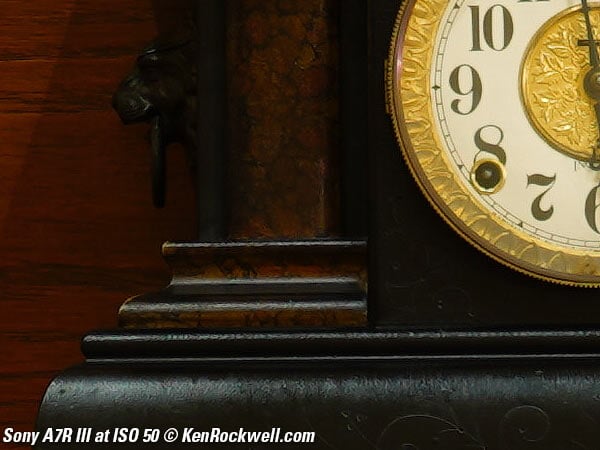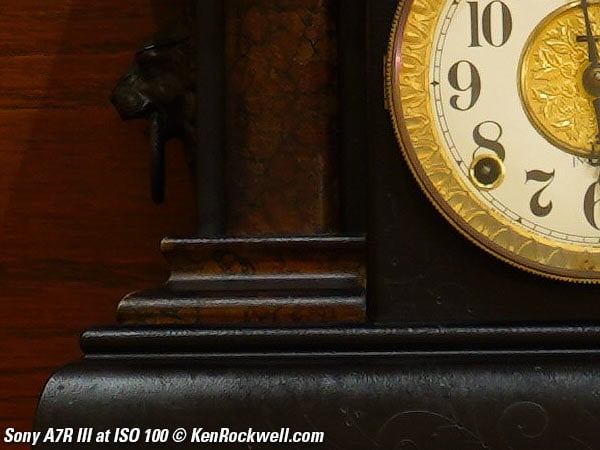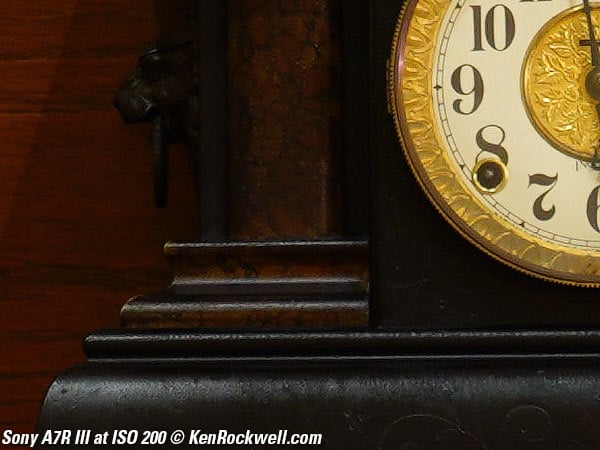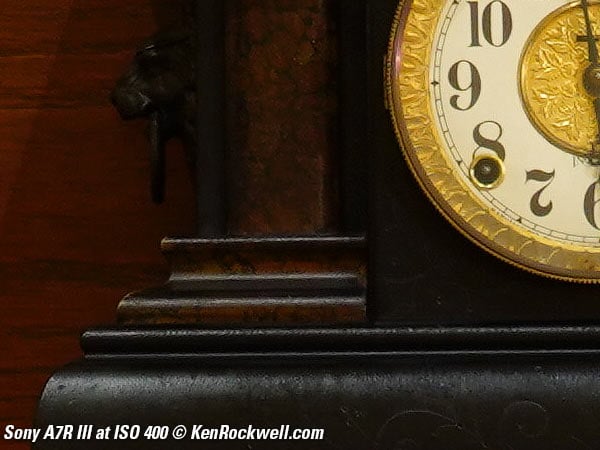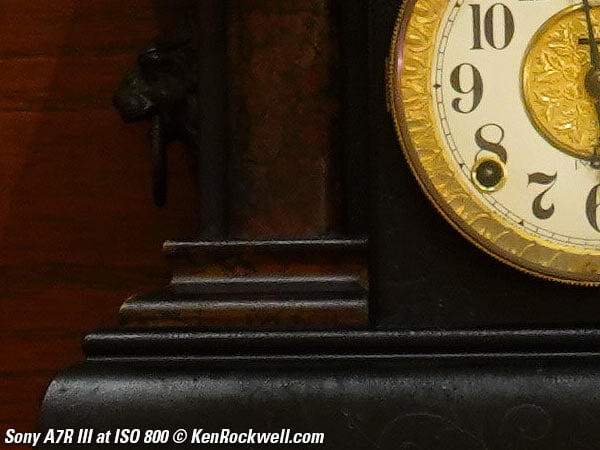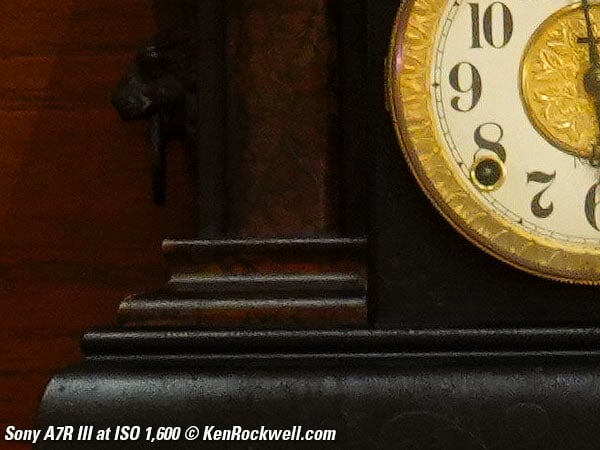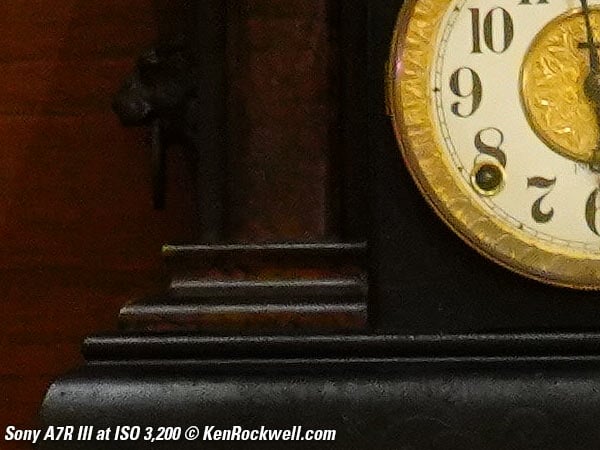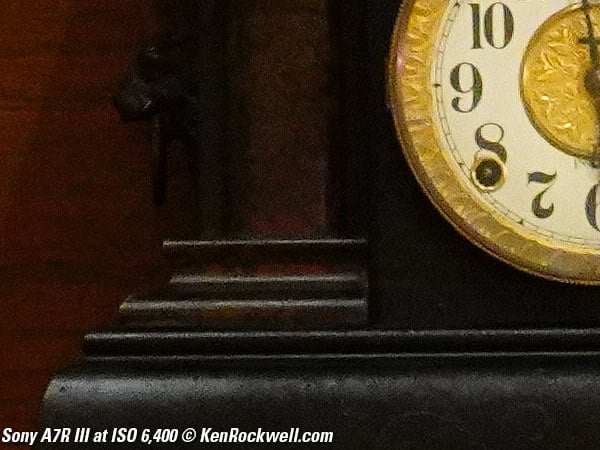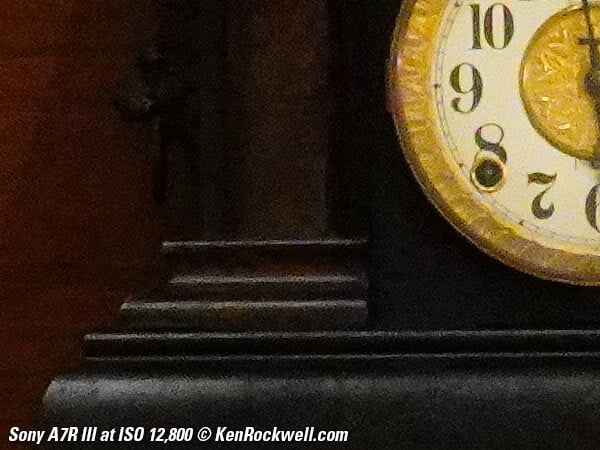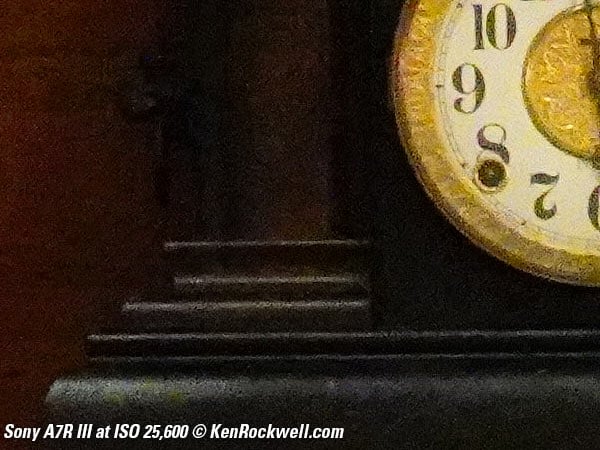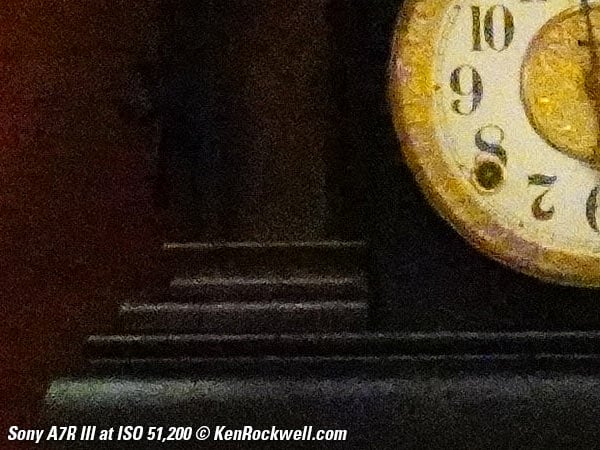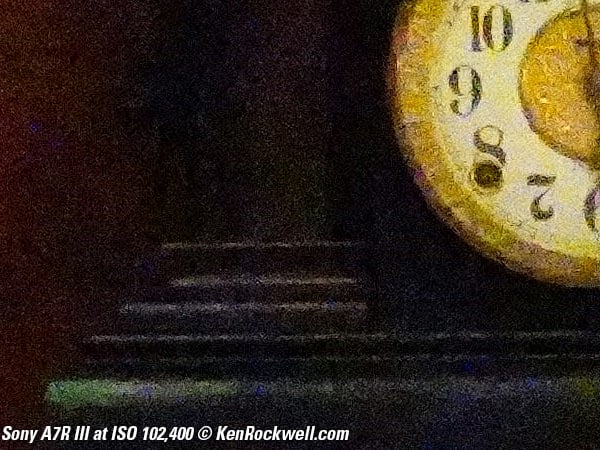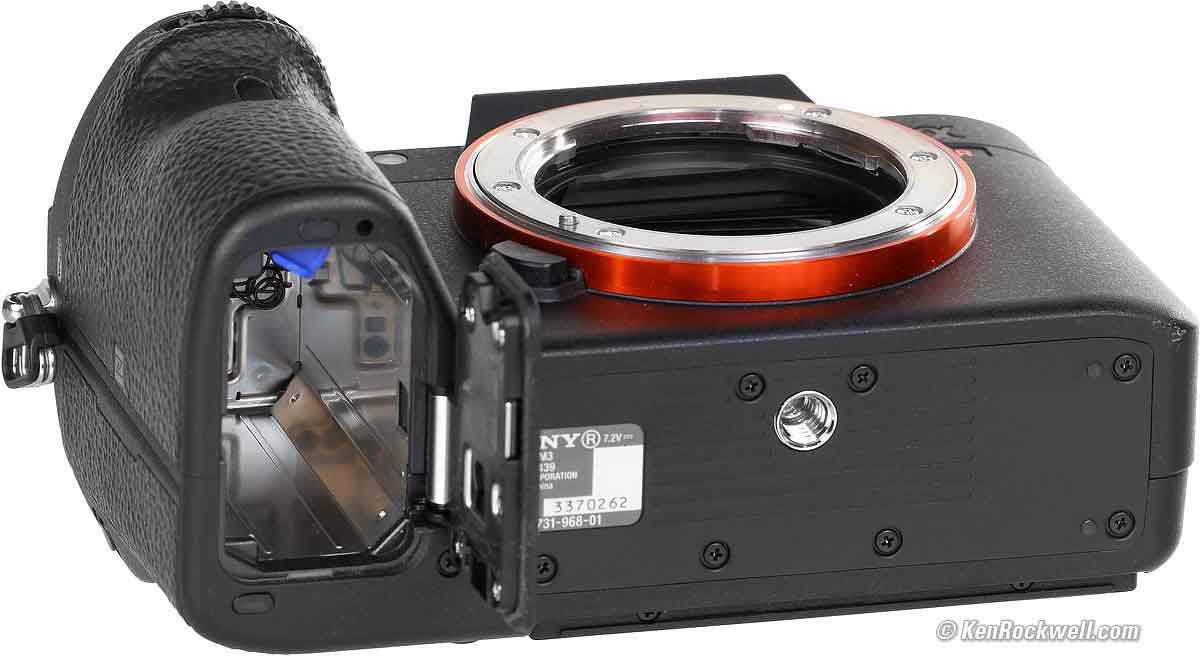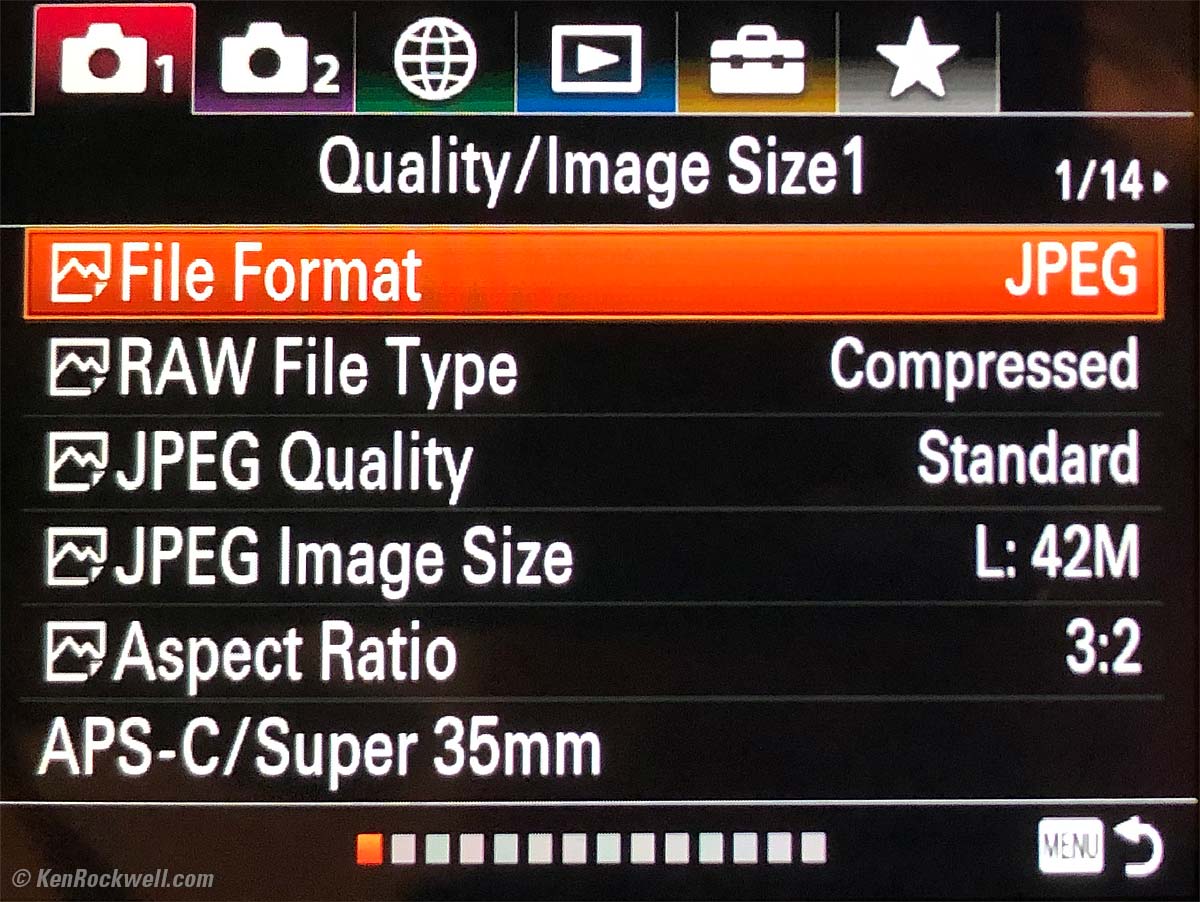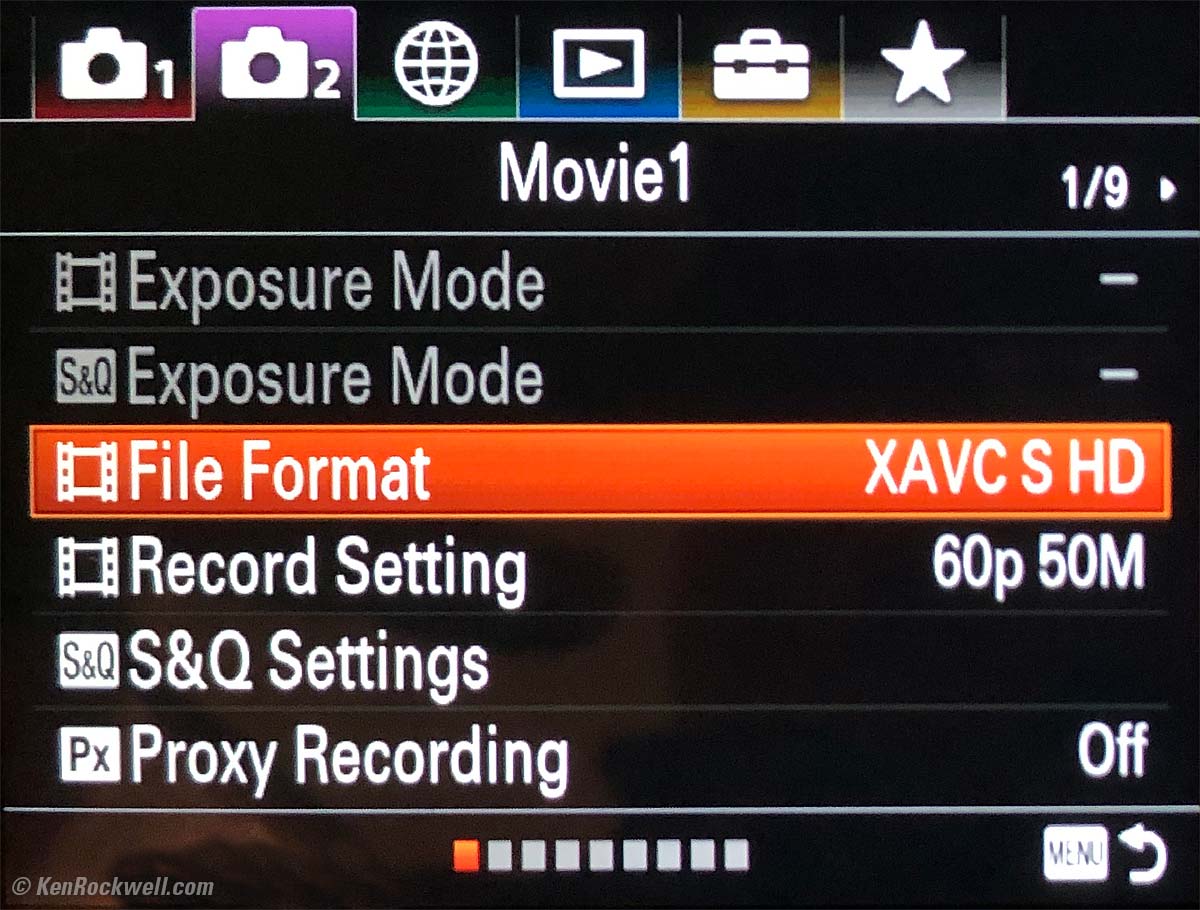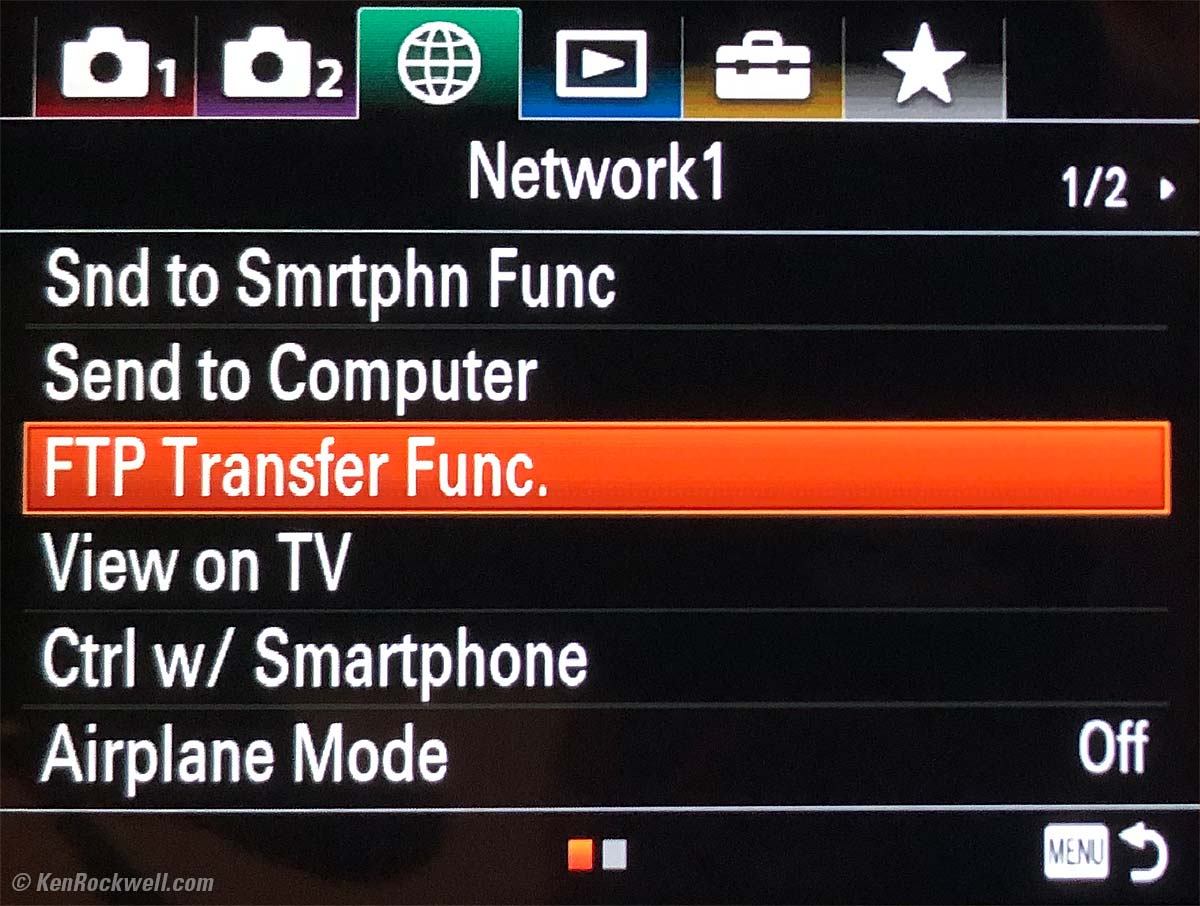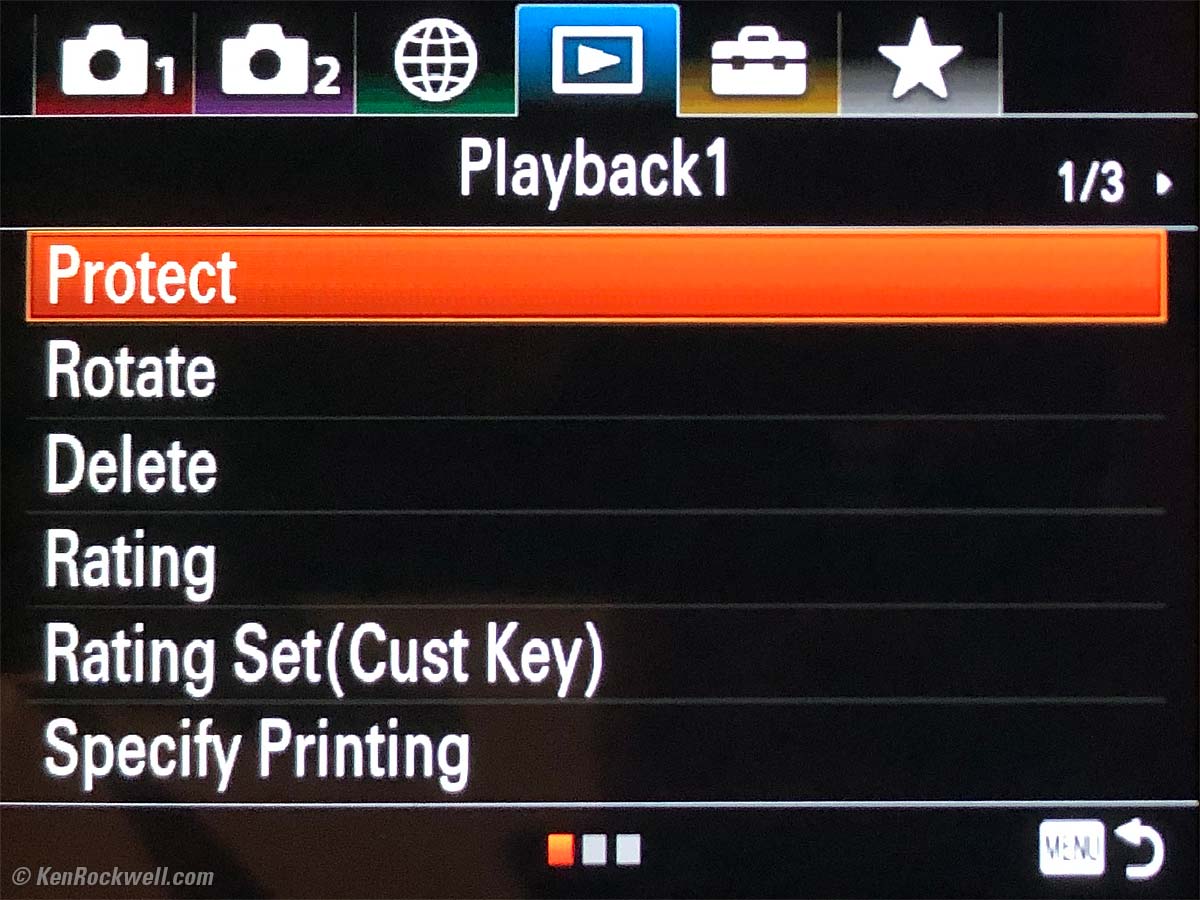Sony A7R III
42MP stabilized full-frame, 10 FPS, ISO 102,400, 4K Stereo
NEW: Sony A7R Mark IV.
Sample Images Intro Lenses & Adapters
Specifications Accessories USA Version
Sony: A9 III A1 A9 II A9 A7R V A7R IV A7R III A7 IV A7 III A7R II A7S III A7c A7 II A6600 A6400 A6100 A6000 ZV-E10 RX10/4 RX100/7 RX100/6 Flash Lenses
Sony A7R III (23.2 oz./658g with battery and one card, $2,498) and 24-105mm f/4 G. bigger. I'd get mine at Adorama, at Amazon, at B&H or at Crutchfield, or get it used if you know How to Win at eBay.
This all-content, junk-free website's biggest source of support is when you use those or any of these links to approved sources when you get anything, regardless of the country in which you live. Thanks for helping me help you! Ken.
July 2019 Sony Sony Lenses Zeiss Nikon Canon Fuji LEICA All Reviews
NEW: Sony A7R Mark IV.
Nikon vs Canon vs Sony Full Frame Mirrorless Compared.
Sony A7R III. bigger.
Sony A7R III. bigger.
Sample Images
(more at High ISOs)
Top Sample Images Intro Lenses & Adapters
Specifications Accessories USA Version
I'd get my A7R III at Adorama, at Amazon, at B&H or at Crutchfield, or get it used if you know How to Win at eBay.
ISO 100
Chinese Restaurant San Francisco, 12:25 P.M., 16 September 2018. Sony A7R III with Sony 24-105mm f/4 G at 86mm at f/6.3 at 1/250 at Auto ISO 100, Perfectly Clear. bigger or full-resolution.
20th Street, Dogpatch, San Francisco, 6:06 P.M., 16 September 2018. Sony A7R III with Sony 24-105mm f/4 G at 49mm at f/7.1 at 1/160 at Auto ISO 100, Perfectly Clear. bigger, full-resolution or camera-original © JPG.
Three Brick Windows, San Francisco, 5:54 P.M., 16 September 2018. Sony A7R III with Sony 24-105mm f/4 G at 93mm at f/7.1 at 1/320 at Auto ISO 100, Perfectly Clear. bigger or full-resolution.
Intercontinental Hotel San Francisco, 11:35 A.M., 17 September 2018. Sony A7R III with Sony FE 24mm f/1.4 GM at f/8 at 1/640 at Auto ISO 100, Perfectly Clear. bigger or full-resolution.
Islands, 12:53 P.M., 19 December 2017. Sony A7R III with Sony 24-105mm f/4 G at 105mm at f/5.6 at 1/250 at Auto ISO 100, as shot. bigger or camera-original © JPG.
ISO 400
Model, Muir Woods, 3:28 P.M., 17 September 2018. Sony A7R III with Sony FE 24mm f/1.4 GM at f/1.4 at 1/100 at ISO 400, Perfectly Clear. bigger, full-resolution or camera-original © file.
San Francisco Skyline at Dusk as Seen from the San Francisco Bay, 7:34 P.M., 17 September 2018. Sony A7R III with Sony FE 24mm f/1.4 GM at f/1.4 at 1/60 at ISO 400, Perfectly Clear. bigger, full-resolution or camera-original © file.
Chevron by Mimi's, 9 P.M., 15 December 2017. Sony A7R III with Sony 24-105mm f/4 G at 24mm at f/4 at 1/15 hand-held at Auto ISO 400, Perfectly Clear. bigger, full-resolution file or camera-original © JPG.
ISO 500
Sunset over the Golden Gate Bridge with Backlit Waves as Seen from the San Francisco Bay aboard the USS Potomac, 6:57 P.M., 17 September 2018. Sony A7R III with Sony FE 24mm f/1.4 GM at f/7.1 at 1/400 at Auto ISO 500, Perfectly Clear. bigger, full-resolution or camera-original © file.
ISO 800
Ryan and the snowman he made at his school Christmas party, 12:13 P.M., 21 December 2017. Sony A7R III with Sony 24-105mm f/4 G at 65mm at f/4 at 1/125 at Auto ISO 800, Perfectly Clear. bigger or full-resolution file.
Mixed fluorescent and window light? No problem! Instant autofocus on the eyes? Absolutely! I had hundreds of shots like this; the A7R III and a great lens like the 24-105mm f/4 G just nail each shot; all I have to do is point and shoot.
ISO 1,250
A Walk Through the American Revolution, 8:25 A.M., 20 December 2017. Sony A7R III with Sony 24-105mm f/4 G at 56mm at f/4 at 1/30 hand-held at Auto ISO 1,250, Perfectly Clear. bigger, full-resolution file or camera-original © JPG.
ISO 1,600
Redwood Trees in Muir Woods with Sunstar, 2:55 P.M., 17 September 2018. Sony A7R III with Sony FE 24mm f/1.4 GM at f/16 at 1/15 at Auto ISO 1,600, Perfectly Clear. bigger, full-resolution or camera-original © file.
Sausalito Staircase, 1:53 P.M., 17 September 2018. Sony A7R III with Sony FE 24mm f/1.4 GM at f/13 at 1/15 at Auto ISO 1,600, Perfectly Clear. bigger, full-resolution or camera-original © file.
Blue, Green and Red, Third Street, San Francisco, 8:02 P.M., 16 September 2018. Sony A7R III with Sony 24-105mm f/4 G at 24mm at f/4 at 1/5 hand-held at ISO 1,600, Perfectly Clear. bigger, full-resolution or camera-original © JPG.
ISO 2,000
Palm Trees at Night, AT&T Park, San Francisco, 8:04 P.M., 17 September 2018. Sony A7R III with Sony FE 24mm f/1.4 GM at f/1.4 at 1/60 at Auto ISO 2,000, Perfectly Clear. bigger, full-resolution or camera-original © file.
ISO 3,200
Third Street at 19th, San Francisco, 8:03 P.M., 16 September 2018. Sony A7R III with Sony 24-105mm f/4 G at 105mm at f/4 at 1/10 hand-held at ISO 3,200, Perfectly Clear. bigger, full-resolution or camera-original © JPG.
Ryan and his MacBook Air, 1:35 P.M., 17 December 2017. Sony A7R III with Sony 24-105mm f/4 G at 78mm at f/4 at 1/125 at Auto ISO 3,200, Perfectly Clear. bigger or full-resolution © file.
Face recognition is magic, finding the closest eye and ignoring distracting elements that are closer:
Crop from above. bigger or full-resolution © file.
ISO 6,400
Christmas Tree 6:30 P.M., 15 December 2017. Sony A7R III with Sony 24-105mm f/4 G at 94mm at f/4 at 1/50 hand-held at Auto ISO 6,400, Perfectly Clear. bigger, full-resolution file or camera-original © JPG.
This is shot wide-open so very little is in focus due to the slim depth-of-field, and you can still see how sharp, clean and colorful is this image, even in dim light hand-held at slow speeds.
ISO 40,000
Palm tree at night, 8:40 P.M., 18 December 2017. Sony A7R III with Sony 24-105mm f/4 G at 24mm at f/4 at 1/15 hand-held at Auto ISO 40,000. bigger or camera-original © JPG.
The dots in the sky are stars.
Introduction
Top Sample Images Intro Lenses & Adapters
Specifications Accessories USA Version
|
I buy only from these approved sources. I can't vouch for ads below. |
The Sony A7R III is the best mirrorless camera ever introduced for consumer photography. It's super easy to shoot, with clairvoyant autofocus and exposure that makes it trivial to get hundreds of ultrasharp photos every day — especially of moving subjects!
When photographing people it has an instantaneous and clairvoyant ability to find and just focus on faces and track them as they move. If you're a people or event photographer, the A7R Mk III is going to make your life much simpler; you'll never have to manually select AF areas again. It's that good.
The A7R III takes Sony's highest-resolution sensor from the A7R II and essentially puts it in the body of Sony's professional A9 camera. The A7R III has twice the resolution of the professional A9 and runs at twice the frame rate of the old A7R II, along with many other features that previously were unique to the A9. The A7R3 adds a much bigger battery, a second card slot, a third memory recall position on the top dial and many other important new features to the old A7R II.
The new A7R III is a joy to shoot. Once set up, everything just goes, and the pictures look great. Better than DSLRs, you never need glasses to see the rear LCD; the electronic finder also works for menu setting, playback and zooming-in on both playback and shooting!
The Sony A7R III runs at up to 10 frames per second, and does it silently, if you activate this in a menu. No one will know you're shooting, opening many new worlds where photography was previously prohibited or inappropriate.
The pro A9 runs at up to 20 FPS in total silence, while this A7R III runs at up to 10 FPS in total silence with fewer restrictions on ISO and shutter speeds than the silent mode of the A9. (see Compared).
Unless you're mostly shooting sports and action where you need the 20 frames per second of the Sony A9, this A7R 3 is a better camera for a lot less money. In actual use they have the same high ISO performance as each other. Even though you can set the A9 higher, it looks worse. At the same ISO, the A7R III and A9 look the same while the A7R III has higher resolution.
The silent mode isn't on by default; you have to set it at MENU > Camera 2 > page 4/9 > Silent Shooting > ON. In silent mode you can be blazing away at ten full 42 MP frames per second, even in raw with the A7R III's huge buffer, and no one may notice you're shooting. By comparison, every single frame in the "quiet" modes of the pro Canon 1DX Mk II and Nikon D5 are so loud that I can hear them echo off the neighbor's houses. The pro DSLRs are the very loudest cameras of all.
This is the first Sony mirrorless other than the pro A9 with two card slots, and has just as tough a mechanical shutter, "tested" to 500,000 cycles! The mechanical shutter is tough, and the silent electronic shutter has no moving parts to wear out — ever!
The Sony A7R3's images look great in every light and are always sharp and well exposed under very difficult and active conditions. It also turns-on and wakes immediately; no longer do we have to wait for it to wake up each time.
The AF system is magical; I never have to select sensors or systems manually; it just focuses and I can shoot.
It offers facial recognition autofocus over the entire frame, not just in the center of the picture like full-frame DSLRs. Autofocus is essentially instantaneous with the right lenses, and even with good consumer lenses it can track fast-moving targets in the dark at night. Presuming you activate face recognition in a menu, the A7R3 instantly recognizes faces, focuses on them and tracks them as they move around. It works flawlessly. The only way to trick the A7R3's facial recognition is when you have several faces at different distances for which it may swap back and forth as to which face it thinks is most important — unless you also program it to which faces are the most important.
If there are multiple faces and the closest one turns away, my A7R III actually pulls focus to the next nearest face immediately, always keeping the most relevant face in perfect focus
It also has 399 phase-detection AF sensors that it uses to focus on things that aren't faces. These sensors cover the central picture area inside the big gray brackets in the finder.
Many buttons are programmable, so you can program them to do just about anything.
It has three memory recalls on its top mode dial, so it's easy to set up one for photos of things (Vivid picture with +3 Saturation), one for people pictures (standard color with +1 Saturation), and the other for anything else, like sports or a custom white balance. If three memories aren't enough, there are four more hidden ones, M1, M2, M3 and M4, which are almost as easy to recall.
I'd get my A7R III at Adorama, at Amazon, at B&H or at Crutchfield, or get it used if you know How to Win at eBay.
New since the A7R II
 10 FPS, up from 5 FPS.
10 FPS, up from 5 FPS.
 Two card slots.
Two card slots.
 Bigger NP-FZ100 battery lasts about 1,500 shots in normal shooting (CIPA rated 530 single shots; old A7R II was rated only 290 shots).
Bigger NP-FZ100 battery lasts about 1,500 shots in normal shooting (CIPA rated 530 single shots; old A7R II was rated only 290 shots).
 Three memory recalls on the top mode dial, with four more presets almost as easy to recall.
Three memory recalls on the top mode dial, with four more presets almost as easy to recall.
 New thumb-nubbin controller on rear.
New thumb-nubbin controller on rear.
 Touch screen, but only for AF point selection.
Touch screen, but only for AF point selection.
 425 contrast AF points, up from 25.
425 contrast AF points, up from 25.
 Ability to shoot-through flickering lighting.
Ability to shoot-through flickering lighting.
 Two separate AEL and AF-ON buttons, instead of just one button with a selector lever as on A7RII, A7SII, A7II and A7.
Two separate AEL and AF-ON buttons, instead of just one button with a selector lever as on A7RII, A7SII, A7II and A7.
 C3 button moved to left side of camera; it's on the right on A7RII, A7SII, A7II and A7.
C3 button moved to left side of camera; it's on the right on A7RII, A7SII, A7II and A7.
 Higher resolution electronic viewfinder.
Higher resolution electronic viewfinder.
 In-camera 5-axis sensor-shift stabilization now claims 5.5 stops improvement.
In-camera 5-axis sensor-shift stabilization now claims 5.5 stops improvement.
 Weird "Pixel Shift" mode uses sensor-shifting to make four sequential scans of a fixed image that, if combined later in your computer with Sony's "Imaging Edge" software, might improve resolution. This only works on a tripod and only with rigid subjects; if anything moves even slightly you'll get weird color fringes.
Weird "Pixel Shift" mode uses sensor-shifting to make four sequential scans of a fixed image that, if combined later in your computer with Sony's "Imaging Edge" software, might improve resolution. This only works on a tripod and only with rigid subjects; if anything moves even slightly you'll get weird color fringes.
 14-bit raw.
14-bit raw.
 Shoots 4K video using the entire 36mm width of the image sensor.
Shoots 4K video using the entire 36mm width of the image sensor.
 XAVC S high-bitrate video formats for 60~100 MBPS video.
XAVC S high-bitrate video formats for 60~100 MBPS video.
 Under- and over-crank video from 1 FPS to 120 FPS, MOS (without sound).
Under- and over-crank video from 1 FPS to 120 FPS, MOS (without sound).
Good
 Magnificent electronic finder: always big, bright, sharp and wonderful in any light. Super-bright in daylight, and dims perfectly indoors and at night.
Magnificent electronic finder: always big, bright, sharp and wonderful in any light. Super-bright in daylight, and dims perfectly indoors and at night.
 Two card slots.
Two card slots.
 Hybrid AF system uses phase-detection for speed and contrast detection for ultimate precision and accuracy.
Hybrid AF system uses phase-detection for speed and contrast detection for ultimate precision and accuracy.
 Battery life seems almost unlimited.
Battery life seems almost unlimited.
 Solid mostly metal construction.
Solid mostly metal construction.
 Even the regular mechanical shutter only moves at the ends of exposures. There's never any need for a special vibration-free mode; it always works this way. Suck on that, LEICA!
Even the regular mechanical shutter only moves at the ends of exposures. There's never any need for a special vibration-free mode; it always works this way. Suck on that, LEICA!
 Excellent high ISO performance.
Excellent high ISO performance.
 Facial recognition works well, but only after you find it and turn it on.
Facial recognition works well, but only after you find it and turn it on.
 In-finder 2-axis level works great for keeping horizons and vertical lines as they should be.
In-finder 2-axis level works great for keeping horizons and vertical lines as they should be.
 In-camera, as-shot automatic lens vignetting, lateral chromatic aberration and distortion correction.
In-camera, as-shot automatic lens vignetting, lateral chromatic aberration and distortion correction.
 Almost any lens of any brand or age can be adapted to work - but with no lens corrections.
Almost any lens of any brand or age can be adapted to work - but with no lens corrections.
 Stereo microphone built-in.
Stereo microphone built-in.
 3.5mm powered mic and headphone jacks.
3.5mm powered mic and headphone jacks.
 Can extract stills from video, in-camera after it's shot. In other words, shoot 4K video and you can pull-out 8MP stills shot at 30 FPS.
Can extract stills from video, in-camera after it's shot. In other words, shoot 4K video and you can pull-out 8MP stills shot at 30 FPS.
 Bluetooth & NFC.
Bluetooth & NFC.
Bad
 If you set it to record to two cards for backup as I do, and then remove one card or it fills, the camera stops shooting. It should just shoot to either card that has space, not leave you dead in the water.
If you set it to record to two cards for backup as I do, and then remove one card or it fills, the camera stops shooting. It should just shoot to either card that has space, not leave you dead in the water.
Missing
 Silent electronic shutter is a game-changer, but won't work with flash. Flash sync speed is still only 1/250.
Silent electronic shutter is a game-changer, but won't work with flash. Flash sync speed is still only 1/250.
 No built-in flash.
No built-in flash.
 No auto brightness control for the rear LCD (but great auto brightness control for the electronic finder).
No auto brightness control for the rear LCD (but great auto brightness control for the electronic finder).
 No GPS.
No GPS.
 No shutter speed dial.
No shutter speed dial.
 No ISO dial.
No ISO dial.
 No square, 4:5 or 4:3 crops; 16:9 only.
No square, 4:5 or 4:3 crops; 16:9 only.
 No way to back up the complete camera state as Nikons can do.
No way to back up the complete camera state as Nikons can do.
 No more 0.5 second image auto review option, just 2, 5 or 10 seconds.
No more 0.5 second image auto review option, just 2, 5 or 10 seconds.
 4K video, but no 4K/60. So?
4K video, but no 4K/60. So?
 Touch screen lets you select movie focus areas, but doesn't work for setting the camera in the menu screens.
Touch screen lets you select movie focus areas, but doesn't work for setting the camera in the menu screens.
 No more multi-frame noise reduction (just set a slower ISO and make a longer exposure for the same effect).
No more multi-frame noise reduction (just set a slower ISO and make a longer exposure for the same effect).
 No more swept panoramas (an iPhone does this better anyway).
No more swept panoramas (an iPhone does this better anyway).
 Three preset memory modes (good), but no way to set these to auto-update as you're learning your new camera. The memories can only be saved manually.
Three preset memory modes (good), but no way to set these to auto-update as you're learning your new camera. The memories can only be saved manually.
Sony A7R III and 24-105mm f/4 G. bigger.
Lenses & Adapters top
Top Sample Images Intro Lenses & Adapters
Specifications Accessories USA Version
I'd get my A7R III at Adorama, at Amazon, at B&H or at Crutchfield, or get it used if you know How to Win at eBay.
Lens Compatibility
Lens Mount, Sony A7R III. bigger.
The A7R III uses the Sony E-Mount, formerly called the NEX mount, whose shallow 18mm flange focal distance allows better lens designs than DSLRs do — the same advantage rangefinder cameras have, as well as allowing just about any lens to mount with an adapter.
The A7R III works best with all the lenses made by Sony, Zeiss and others for Sony's mirrorless E-Mount.
If you mount a Sony or Zeiss APS-C lens, it automatically uses only the central APS-C section of the full-frame sensor. You'd never know, since all the displays just look right. It's that seamless, but sort of silly to waste most of this camera's sensor area with an APS-C lens.
Highest Performance Lenses
The Sony 12-24mm f/4 G, 16-35/2.8 GM, 24-70/2.8 GM, Sony 24-105mm f/4 G and 70-200/2.8 GM are extraordinary on my A7R III. They focus just about instantly, and are super sharp at every setting.
If you want the high performance for which you're paying a premium with your A7R III, be sure to get the best lenses for it.
See also my list of Best Sony Lenses.
Sony's Adapters
Sony's own adapters work pretty well, but know that none of Sony's A-mount lenses are as good as the latest E-mount lenses, especially when used on E-mount.
LA-EA2: Discontinued.
LA-EA3: only for lenses with built in AF motors.
The LA-EA3 is a great adapter and allows just about full performance with any Sony Alpha DSLR or Minolta MAXXUM 35mm SLR - but only if it's one of the very few lenses with an internal autofocus motor.
If the lens has its own AF motor, with this adapter you should get full communication and AF and everything.
LA-EA4: Recommended for all Sony Alpha and Minolta MAXXUM lenses.
The LA-EA4 is everything the LA-EA3 is, and adds its own AF motor to drive every Sony Alpha and Minolta MAXXUM lens for full autofocus — for every lens back to 1986. It works with lenses both with or without internal AF motors.
Sony Alpha and Minolta MAXXUM lens work great with the LA-EA4 on the A7R III. They focus very fast, and even Auto ISO and Program Shift all follow your zoom's focal length.
While phase-detection points only are active around the center of the frame, Face Recognition sees and focuses on faces anywhere. Oddly the face box stays gray or white, not locking-on in green unless the face is near the center of the frame, but it works anyway.
Lenses stay wide open most of the time for framing and focus and only stop down for the exposure. I program my C1 button for aperture preview.
Other Brand Adapters
While you can adapt any lens of any brand or age to the A7R III, they won't work as well as native Sony or Zeiss FE lenses, or Alpha or MAXXUM lenses with the LA-EA4 adapter.
Lenses that perform magnificently on their own brand of camera may or may not autofocus that well adapted to Sony. If you demand the best performance, just use the same brand of lens as your camera. Adapters should never be your go-to for the best performance. Don't expect the best results for sharpness or for autofocus from other-brand adapters if you're picky.
Adapters are great for fun; you can get adapters cheap for any kind of lens, but not only may autofocus be iffy, adapted wide-angle lenses usually aren't very sharp on the sides at large apertures because Sony's full-frame mirrorless sensors are optimized for lenses with a curved fields. Most other adapted lenses won't seem very sharp on the sides at large apertures due their flat fields not interfacing well with the curved fields needed by Sony's sensors on these cameras. If you get the center in focus, the sides will probably be off, and if you get the sides in focus, the center will be off. This is more of a problem with wider lenses and at large apertures; stop a lens down and the sides will come into better focus.
Metabones Mark V Adapter
The Metabones Canon EF to Sony E-Mount Mark V Adapter is the best I've used.
It works with every crazy Canon lens with which I tried it, and the results were usually much sharper than I expected.
See its review for lots of sample images and details. If you want an adapter for Canon, this is the one.
Other Canon Adapters
You never know which particular AF lenses will work or not with other brands of adapters. There is always firmware and software to update, so you never know. While my A7R III works with my Canon Canon 100-400mm L IS II and most of my lenses including my 1986 Canon 80-200/2.8 L, with the Fotodiox adapter my 50mm f/1.0 most things work, including electronic manual focus — but AF doesn't.
I bought a Fotga adapter direct from China for $37 if you know How to Win at eBay, and it worked for 30 seconds, and then never communicated with any of my lenses again. Just get the Metabones if you are serious about this.
LEICA Lenses
Lenses with goggles for the LEICA M3 (35mm and 135mm) won't mount regardless of what adapter you use: the A7R III's grip gets in the way.
Silent shooting: no one asks why I'm taking pictures, period. Sensor-stabilization makes it easy to hand hold at 1/15!
While LEICA lenses are the world's finest, they are not designed for the curved fields or rear nodal point positions optimized for the Sony cameras, and like all other adapted lenses, perform more poorly than Sony's own lenses because the sides and corners often aren't in proper focus.
LEICA lenses of 35mm and wider aren't as sharp as they should be at the sides. They sharpen up as stopped down, but if you want great results, use LEICA lenses on a LEICA camera, or use Sony's lenses on the A7R III. It all has to do with the specific alignment of micro lenses and layer configuration towards the sides of the sensor.
Specifically, there is a lot of field curvature induced by the design of the Sony sensor, and to focus at infinity at the sides with a modern semi-retrofocus LEICA SUPER-ELMARIT-M 21mm f/3.4 ASPH, you have to turn the focus ring to about 10'/3 meters! With the 1959 SUPER-ANGULON 21mm f/4 whose rear nodal point really is only about 21mm away from the image plane, you have to set the focus ring to about 3'/1 meter to get things at infinity in focus at the sides!!! Because of this, I've tried and confirmed that my cheap Voigtländer 21mm f/4 works about as well on my A7R III as my genuine ASPH LEICA 21mm.
Not only does the combination of a LEICA (or other traditional Nikon or Canon) lens and Sony A7R III sensor induce field curvature (there are a lot of optics and micro lenses on a sensor before you get to the light-sensitive part), it also induces astigmatism: the sagittal and meridional planes diverge.
There's no need to splurge for the latest APO ASPH LEICA lenses since the LEICA's (or anyone else's) lenses, with their flat fields are never going to be that sharp across a frame that's expecting a curved field lens. Therefore, it's best to select the lightest-weight (older) lenses rather than the hottest new ones. The performance of my LEICA SUMMICRON-M 35mm f/2 (7-element) is the same as with the newest LEICA SUMMICRON-M 35mm f/1.4 ASPH (floating element), so I prefer to use the older, lighter lens.
With my LEICA APO-SUMMICRON-M 90mm f/2 ASPH, probably the world's sharpest photographic lens legally sold to consumers, it actually works reasonably well because the curvature effects are less pronounced, but it's still not as good as a SONY lens on my A7R III, or the APO-SUMMICRON on a LEICA. It all has to do with how well sensors interface with particular lenses.
My LEICA TELE-ELMAR-M 135mm f/4 works great because its rear nodal point is far enough away from the sensor to give sharp images edge-to-edge wide open.
LEICA lenses also have the big disadvantage of not focusing any closer than 0.7 or 1 meters (2.5 or 3 feet). A huge advantage of mirrorless is that the system works great regardless of close-focus distance, so if you're going to use a lens on the A7R III, you ought to use one that focuses close enough. LEICA lenses were always limited by having to work with a viewfinder on the side of the camera which leads to big parallax problems at closer distances.
Summary
Stick with lenses sold by Sony, be they branded Sony or Zeiss, for the best results as you expect. Sony's G and GM lenses are especially excellent in every way on the A7R III.
Adapting lenses of other brands, even though these lenses may be state-of-the-art on those manufacturers' cameras, probably won't be that breathtaking on the A7R III — or any other camera of a brand different than the lens' manufacturer. Stick to Sony G and GM lenses on the A7R III and you won't go wrong.
Specifications
Top Sample Images Intro Lenses & Adapters
Specifications Accessories USA Version
I'd get my A7R III at Adorama, at Amazon, at B&H or at Crutchfield, or get it used if you know How to Win at eBay.
Sensor
42 MP full-frame 24.0 × 35.9mm CMOS sensor.
1.5:1 aspect ratio.
15-stop dynamic range.
No anti-alias filter.
Anti-reflection coated.
Ultrasonic cleaner.
Mechanical "5-axis" sensor-shift stabilizer claims 5.5 stops improvement.
ISO
Stills, regular mechanical shutterRegular: ISO 100 ~ 32,000.
Extended: ISO 50 ~ 102,400.
Stills, silent electronic shutter
Regular: ISO 100 ~ 32,000.
Extended: ISO 100 ~ 102,400.
Video
Regular: ISO 100 ~ 32,000.
Auto ISO
Upper and lower limits selectable from ISO 100 to ISO 102,400 in full stops (limited to ISO 32,000 for video).
Slowest shutter speed settable in full stops from 1/8,000 to 30s in full stops, as well as an Auto setting that varies with the lens focal length. The Auto Slowest Shutter Speed setting my be varied ±2 stops slower or faster than the lens' focal length.
Image Sizes
Cropped Sizes
The A7R III automatically crops the full-frame down to APS-C if you mount an APS-C lens, or you can set this manually (MENU > Camera 1 > page 1/14 > APS-C/Super 35mm > AUTO), and either of these 1.5:1 formats may also be set to a 16:9 crop.
Full Frame
7,952 × 5,304 pixels (Large, 42 MP), native.
5,168 × 3,448 (Medium, 18 MP).
3,984 × 2,656 (Small, 11 MP).
APS-C
5,168 × 3,448 (Large, 18 MP), native.
3,984 × 2,656 (Medium, 11 MP).
2,592 × 1,728 (Small, 4.5 MP).
Image Formats
JPG, raw or raw + JPG.
JPG: Extra Fine, Fine or Standard.
Raw: 14-bit compressed or uncompressed, even when shooting in silent or continuous modes.
Video & Audio
Stereo mic built-in.
Regular, S-Log2 , S-Log3 and HLG (Hybrid Log-Gamma).
XAVC S
File Format
MPEG-4 AVC/H.264 XAVC S ver.1.0 format compliant video with LPCM 48 ksps 16-bit stereo audio.
Rates & Sizes
3,840 × 2,160 (4K): 29.97p, 25p or 23.976p at 100 or 60 MBPS
1,920 × 1,080: 119.88p or 100p at 100 MBPS or 60 MBPS; 59.94p,50p, 29.97p, 25p or 23.976p at 50 MBPS.
AVCHD v 2.0
File Format
MPEG-4 AVC/H.264 video with Dolby Digital 2 channels, equipped with Dolby Digital Stereo Creator.
Rates & Sizes
1,920 × 1,080: 59.94p, 28 MBPS, PS; 59.94i, 24 MBPS, FX; 59.94i, 17 MBPS, FH; 23.976p, 24 MBPS, FX, 23.976p, 17 MBPS, FH; 50p, 28 MBPS, PS; 50i, 24 MBPS, FX; 50i, 17 MBPS, FH; 25p, 24 MBPS, FX; 25p, 17 MBPS, FH.
MP4
File Format
MPEG-4 AVC/H.264 video with stereo MPEG-4 AAC-LC.
Rates & Sizes
1,920 × 1,080: 59.94p or 50p at 28 MBPS; 29.97p or 25p at 16 MBPS
1280 × 720: 29.97p or 25p at 6 MBPS.
Under- and Over-crank (slow-mo and fast-motion)
Sony calls this S&Q, for "Slow and Quick" motion.
MOS (recorded without sound) only.
1, 2, 4, 8, 15, 30, 60 and 120 FPS in the pulled-down ("NTSC") modes.
1, 2, 3, 6, 12, 25, 50 and 100 FPS in the straight ("PAL") modes.
Autofocus
399 point on-sensor phase-detection.
425 point contrast-detection.
Hybrid AF uses phase-detection for speed and fine-tunes with contrast detection when it can.
AF range LV -3 to +20 with an f/2 lens.
LED AF illuminator, 10'/3m range.
Face recognition, but only if you activate it.
6.2× and 12.4× magnifiers.
Electronic Viewfinder
0.5" (13mm) OLED.
3,686,400 dots quad-VGA.
120 frames per second update rate with regular mechanical shutter, 60 FPS with silent electronic shutter.
100% coverage.
0.78× with 50mm lens.
Auto and manual brightness control.
5 steps of manual color temperature shift.
-4 to +3 diopters.
Eyepoint: 18.5mm from the eyepiece frame, 23mm from the eyepiece lens.
Fluorine external coating to repel fingerprints, dust, water and dirt.
Light Meter
1,200 zone evaluative, entire screen Averaging, Center-Weighted, Spot, Spot standard or large or highlight-weighted.
Meter range LV -3 to +20 with an f/2 lens.
Flash Sync
1/250 sync speed, with Sony flashes.
Only works with mechanical shutter; no flash works with the silent electronic shutter.
Dedicated hot shoe and PC (Prontor- Compur) connector.
Shutters
Mechanical Focal-Plane
1/8,000 to 30s and Bulb.
"Tested to 500,000 cycles."
Silent Electronic
1/8,000 to 30s (no Bulb).
Self Timer
2, 5 or 10s delay.
Also can shoot 3 or 5 frames each time, and can make those bracketed.
Frame Rates
It runs to 10 FPS with each of the mechanical or silent electronic shutters.
Continuous High +: 10 FPS.
Continuous High: 8 FPS.
Continuous Mid: 6 FPS.
Continuous Lo: 3 FPS
Frame Buffer
76 frames JPG or raw.
28 frames uncompressed raw.
Storage
Sony A7R III Card Door. bigger.
Two slots:
Slot 1 (bottom): SD, SDHC or SDXC, UHS-I and UHS-II compliant.
Slot 2 (top): SD, SDHC and SDXC, UHS-1 compliant, or Memory Stick PRO Duo.
LCD
Flipping LCD, Sony A7R III. bigger.
3" TFT LCD.
1,440,000 dots.
Flips, but can't flip 180º for self-portraits. Only flips up 107º or down 41.º
Does not swing left or right.
Manual brightness control only. There is a "Sunny" mode, too.
Touch screen to move focus area, but not for menus or playback.
Connectors
Sony A7R III Connectors. bigger.
On Left:
3.5mm microphone jack with plug-in power.
PC (Prontor-Compur) flash sync.
On Right:
3.5mm headphone jack.
Micro-D HDMI. The HDMI output supports 3,840 × 2,160 (25p), 1,920 × 1,080 (50p, 50i, 24p, 60p, 60i and 3,840 × 2,160 at 30p and 24p. YCbCr 4:2:2 8-bit and RGB 8-bit.
USB 3.1 Type C.
MULTI/Micro USB 2.0.
On Top and Bottom:
Hot shoe, which is also a Sony "Multi Interface" Shoe.
Vertical Grip Connector (inside the battery chamber).
WiFi
IEEE 802.11 b/g/n
Infrastructure mode
2.4 GHz.
WEP, WPA-PSK and WPA2-PSK.
Wi-Fi Protected Setup (WPS) or Manual setup.
NFC
NFC Forum Type 3 Tag compliant.
Bluetooth
v4.1.
2.4 GHz.
Model No. WW361847.
Power & Battery
Sony NP-FZ100 rechargeable lithium ion battery included:
Sony NP-FZ100 battery. enlarge.
Sony NP-FZ100 battery. enlarge.
It's 7.2V, 2,280 mAh, 16.4 Wh.
Rated 650 still shots or 115 minutes of video shooting with the rear LCD
Rated 530 still shots or 100 minutes of video shooting with the viewfinder.
Charging
Although I prefer a folding plug charger, this universal corded charger works anywhere with the right cord.
A nice feature is the three-segment battery status indicator. It shows about 2/3 charged here:
Sony BC-QZ1 Battery Charger with NP-FZ100 battery. bigger.
Sony BC-QZ1 Battery Charger. bigger.
It charges via USB in-camera, or also charges in the included BC-QZ1 Corded Battery Charger.
The BC-QZ1 is rated 100~240V, 50/60 Hz, 0.38A in, and 8.4VDC @ 1.6A out.
You can charge two batteries at once; one in the camera via USB and the other in this charger.
Camera Power Consumption
The A7R III consumes about 3.7W (5.5W for video) using the finder and 3W (5.2W for movies) using the LCD.
Size
Including grip and eyepiece:
3⅞ × 5 × 3 inches HWD.
95.6 × 126.9 × 73.7 mm HWD.
Including grip but excluding eyepiece overhang:
3⅞ × 5 × 2½ inches HWD.
95.6 × 126.9 × 62.7 mm HWD.
Weight
23.224 oz./658.4g with battery and one card, actual measured.
Rated 23.2 oz. (657g) with battery and card.
Rated 20.2 oz (572g), stripped.
Quality
Made in China:
Bottom, Sony A7R III. bigger.
Magnesium alloy top cover, front cover, internal frame and rear cover.
The grip area has been reinforced with magnesium alloy.
Sony claims weather seals around most of the buttons and dials, but there are no seals on the card and connector covers.
Announced
Wednesday, 25 October 2017.
Shipping Since
Early December 2017.
Included
A7R III camera & body cap.
FDA-EP18 eye cup, attached.
Black plastic hot shoe cover, attached.
Shoulder strap.
NP-FZ100 rechargeable lithium ion battery (unique to A9 and A7R III as of 2017).
BC-QZ1 Battery Charger and unpolarized AC power cord.
USB Type-C cable.
Cable strain-relief for use if you're shooting tethered.
Two printed manuals, one in English and one in French.
Model Numbers
Bottom, Sony A7R III. bigger.
Sony's official "ILCE-7RM3" model number is printed on the certification sticker on the bottom. It's also how the model is listed in the EXIF information.
Sony also refers to this as the ILCE-7RM3/B in printed documents.
Its more casual "α7R" designation is on the front of the camera.
The only place it's marked α7R III (A7R III) is at the top left of the back of the camera:
Sony A7R III. bigger.
Environment
0 ~ +40º C (32 ~ 104ºF) operating.
-20 ~ +55º C (-4 ~ 131ºF), storage.
Price
$2,498 at Adorama, at Amazon, at B&H and at Crutchfield, or about $2,100 used if you know How to Win at eBay, July 2019.
$2,598, June 2019.
$2,798, Black Friday 2018, otherwise $2,998 November 2018 ~ May 2019.
$2,998, October 2018.
$3,198, October 2017 ~ September 2018.
Accessories
Top Sample Images Intro Lenses & Adapters
Specifications Accessories USA Version
I'd get my A7R III at Adorama, at Amazon, at B&H or at Crutchfield, or get it used if you know How to Win at eBay.
Included
Optional
VG-C3EM Vertical Battery Grip
The VG-C3EM vertical grip takes-over the existing battery bay and holds two batteries for double the shooting life, rated to 950 single shots.
Magnesium alloy exterior.
Dust and moisture resistant.
You can charge the batteries in the grip via the camera's USB connector.
GP-EX1 Grip Extender
This extends the left-hand grip down a little bit, making it easier to grab a camera with all your fingers. Without this extender, a man's hand typically will only be able to wrap three fingers around the camera's grip, not all four. (The thumb isn't a finger.)
NPA-MQZ1K Multi Battery Adapter
This is a crazy adapter that holds up to four batteries!
Not only does it hold them all so you can just keep on shooting, it also can charge up to four batteries in 8 hours.
It may seem expensive, but it comes included with two NP-FZ100 batteries to get you started. Along with the one that comes with your A7R III, you're already up to three.
PCK-LG1 Glass Screen Protector
ECM-XYST1M Stereo Mic
An inexpensive stereo mic which attaches to the A7R III's hot shoe for much better audio than the built-in mics.
XLR-K2M or XLR-K1M XLR Mic/Line Adapters
Each of these includes a professional stereo XLR preamplifier that slides into the A7R III's hot shoe and allows using professional microphones or mixing consoles. It's pretty nifty, with auto and manual gain controls, selectable lo-cut filters, line and mic level inputs and +48V phantom power.
Each also includes an ECM-XM1 shotgun microphone.
Getting a Legal USA Version
(for USA only)
Top Sample Images Intro Lenses & Adapters
Specifications Accessories USA Version
So long as you get yours from an authorized source like these links to it at Adorama, at Amazon, at B&H or at Crutchfield, you'll get a legitimate USA version with a warranty from Sony USA.
USA versions are marked "UC2" above the UPC bar codes on the box. Be sure the serial number on the bar code matches the one on your camera.
USA versions also include a warranty slip which specifically mentions the USA and has Sony's USA phone number in your unsealed box.
USA versions DO NOT HAVE GERMAN as an option for LANGUAGE. Sony specifically removes this from American versions to make it easy to identify gray-market cameras. USA versions also probably have a serial number beginning with a 3.
If you do something stupid like buy from a source that is not an approved source, you may get a gray market version, which has no warranty in the USA and will lack this code on the box or the USA warranty sheet.
Just to keep things interesting, you'll notice that the A7R III has a much larger and longer warranty sheet, no longer just a card, because this warranty now has many more exclusions and limitations than ever before. It specifically adds, about halfway down, that even if you have all this paperwork, if you didn't get your A7R III from an approved (by Sony) dealer, then the warranty doesn't apply.
Buying gray market or what looks like a USA model from an unauthorized dealer is always taking a chance compared to getting a legal USA version from an authorized dealer. If you can save $1,000, then by all means go for it, but if you only get $100 off, I wouldn't risk it.
Performance
Top Sample Images Intro Lenses & Adapters
Specifications Accessories USA Version
Overall Autofocus Ergonomics Exposure
Finder Shutter Frame Rates High ISOs
Auto ISO Auto White Balance Stabilization
Silent Mode Mechanics Rear LCD
I'd get my A7R III at Adorama, at Amazon, at B&H or at Crutchfield, or get it used if you know How to Win at eBay.
Overall
The Sony A7R III is the best high-resolution mirrorless camera on Earth. It shoots faster and more autonomously than any other mirrorless camera other than the half-resolution Sony A9. Set it as you want it, and it will self-select focus and shoot anything in any light with ease — so long as you use good lenses. Much of the fast focus magic is lost if you waste time with old lenses not optimized for Sony mirrorless cameras.
When the original A7 came out there were no great lenses for the Sony system, and today there are a great set, with more coming out every other month.
Autofocus
Autofocus is great. It's fast, sure and usually totally automatic.
With face recognition the A7R III autofocuses throughout the entire frame, not just the central area.
It's important to use a top G or GM lens whose internal AF system is optimized for the Sony mirrorless system; if you use an older or adapted lens, you'll miss much of what the A7R III can do.
While Sony claims only "47% coverage" for the phase-detection pixels, for people photos face recognition covers the entire frame. This 47% lies inside the big gray brackets in the finder.
Set the A7R III to AF-C for continuous AF to let the system shine.
Turn on Face Detection (MENU > Camera 1 > page 6/14 > Set Face Prty in AF > ON), and the A7R III finds the closest eye and just focuses on it all by itself, with no need to select autofocus areas manually:
With general subjects, zillion little green boxes magically fly all over your subject and the camera just focuses on it.
Set the DMF focus mode with the Fn button to allow manual focus override during AF-S (single) autofocus. It's so smart that it will magically zoom into faces as you turn the focus ring!
As I showed at the top, Face Recognition magically finds the closest eye and focuses on it. It ignores closer distracting elements like Ryan's arm:
Ryan and his MacBook Air, 1:35 P.M., 17 December 2017. Sony A7R III with Sony 24-105mm f/4 G at 78mm at f/4 at 1/125 at Auto ISO 3,200, Perfectly Clear. bigger or full-resolution © file.
Crop from above. bigger or full-resolution © file.
My A7R III does a better job of selecting AF points automatically, but you can program your A7R III to let you touch the rear LCD even as you look through the electronic viewfinder to let you select AF points much more easily than using a nubbin. If you set this, just slide your right thumb around the dark LCD to move the AF points wherever you want them.
Ergonomics
It turns on immediately.
The A7R III has so many programmable buttons that it's easy to get it set up the way we'd like.
Memory cards go in with the label away from you. Oddly card 1 is on the bottom and card 2 is on the top; which you'll need to know when you set what records to which.
Unlike Nikon and Canon pro DSLRs whose physical design has been refined over many decades and whose cameras feel soft and comfortable due to their expertly designed curves, the A7R III feels blocky because it is. The A7R III is mostly straight lines and hard edges, and feels that way.
The mode dial locks.
In P, S and A modes the front and rear dials both control the same thing; use whichever you prefer.
The battery goes in backwards from what you'd expect: instead of the curved side facing the curved outside of the grip into which it slides, the square side of the battery faces the outside curved part of the grip and the battery's curved side faces in. I'm always getting confused since it's counterintuitive.
Exposure
Typical for better mirrorless cameras, exposure is almost always perfect. It's very hard to fool the A7R III, and no big deal if you do; just spin the dedicated compensation dial.
Finder
The electronic viewfinder (EVF) is excellent.
It's sharp, bright and colorful, and it's always the right brightness day or night.
It stays in focus because the finder focus wheel is where it's not likely to get knocked.
Even with the silent electronic shutter the EVF seems live, with no delay, for moving subjects.
The electronic shutter is 100% silent and vibration free.
The mechanical shutter usually only moves at the ends of exposures, so there's no vibration in the image. This works by default; there's no need for any prerelease modes for astronomy or other vibration-sensitive shooting.
Frame Rates
It can run at 10 FPS regardless of whatever crummy cards you put in it.
It runs at 10 FPS with just about every ordinary Sony lens like the 24-240mm as well as the fancy GM lenses.
It runs at 10 FPS with adapted manual-focus lenses.
It may take a long time to write all the frames from the buffer to the cards, but you can shoot with slow cards unimpeded so long as you’re patient enough for them to write to the card before playback. The top left of the finder often shows the progress of the buffer unloading onto the cards, which is more of a distraction than useful.
The A7R III is very smart: since it can autofocus and set exposure even with lenses stopped down, it doesn't bother to open and close the diaphragm for each shot at high frame rates if it doesn't have to.
High ISO Performance
High ISO performance is spectacular.
The A7R III looks great at normal image display sizes at just about any ISO other than ISO 102,400 where it gets just a little murkier. Use whatever ISO you need to get a sharp picture if you need it.
High ISO Sample Image Files
Complete Sample Images
Click any for the camera-original © files to explore on your computer; mobile devices rarely show the full resolution files properly. These are all shot with the 24-105mm f/4 G at 50mm at f/8 on a tripod at various exposure times.
These images all look about the same at this web size up to ISO 51,200; the highlights, shadows and colors match very well across the entire ISO spectrum with just a little extra rattiness at the very highest ISO 102,400. Some years ago this wasn't the case; higher ISOs on older cameras would look quite different from lower ISOs even at small print sizes.
As you can see, pretty much any ISO will work well for reasonably sized web or print images. Blotchiness is normal at the very highest ISOs; the camera is doing everything it can to make a picture out of essentially no light and no exposure:
1,200 pixel crops from above
These are 1,200 × 900 pixel crops from the above images. They will vary in size to fit your browser window; if they are about 6" (15cm) wide on your screen, the complete image would print at 26 × 40" (67 × 100 cm) at this same high magnification. If they are about 12" (30cm) wide on your screen, the complete image would print at 53 × 80" (4.5 × 6 feet or 1.3 × 2 meters) at this same high magnification.
While images at high ISOs look great at reasonable print sizes as shown above, the differences are much more obvious at the high magnification shown below or if you choose to look at the original files by clicking any of these.
Details and textures get blurrier as ISOs increase because the camera's noise reduction is removing them along with the noise. Look at the camera-original files (click any image here) on your computer at 100%, and as ISO climbs we lose the subtle texture in animal fur and the wood grain starts to get smeared by about ISO 1,000.
If you're on a tripod shooting as I've done here — or night photography on a tripod — obviously use ISO 100 or 50 as with every camera, never 400 or above, simply because lower ISOs yield cleaner, sharper pictures — if you're going to look at them this close:
600 pixel crops
These are 600 × 450 pixel crops from the top images. They will vary in size to fit your browser window; if they are about 6" (15cm) wide on your screen, the complete image would print at 53 × 80" (1.3 × 2 meters) at this same high magnification. if they are about 12" (30cm) wide on your screen, the complete image would print at 107 × 160" (9 × 12 feet or 2.7 × 4 meters) at this same high magnification! Obviously we're looking very closely here.
As ISO climbs we lose the details in the gold parts of the clock face about ISO 1,000, and the minute marks on the clock face are erased by the noise reduction by about ISO 25,600.
Click any for the same camera-original © files as above to explore on your computer (mobile devices rarely show the full resolution files properly:
Auto ISO
Auto ISO works perfectly, with the one exception that it doesn't shift as you use Program shift.
Auto ISO is perfect in all modes including Program, but if you shift the Program settings (just turn either dial for different combinations of shutter and aperture), the automatically selected ISO doesn't update to keep the shutter speed from falling below the desired slowest speed — or won't decrease an elevated ISO if you shift to a larger aperture.
Therefore if you shift the program in dark conditions you may have to stop everything and change ISO manually.
It sets and does whatever I need it to — except shift the ISO as you shift the Program. The best way around this flaw is to revert to S or A modes if you need to change the selected aperture or shutter speeds in dim light.
Otherwise, it's completely flexible as I explain at its section under Specifications.
Auto White Balance
Auto White Balance works great. It seems to give perfect results in any light. Bravo!
Image Stabilization is great.
The A7R III claims internal 5-axis sensor-shift stabilization with 5.5 stops of improvement.
Of course our world only has three axes, so two of these are made up by the marketing department, but in any case the camera and OSS lenses let me shoot without problem in darkness without a tripod.
Silent Shooting
I always shoot my A7R III in the silent mode. Everything I use works flawlessly and fast.
You have to activate the Silent mode at MENU > Camera 2 > page 4/9 > Silent Shooting > ON.
Most other cameras degrade many performance aspects in their Quiet modes, but not the A7R III — and the A7R III is completely silent, not merely quiet.
You can do everything in the silent mode, except use flash, use the flicker shoot-through mode or shoot below ISO 100. This is better than the Sony A9, which can't shoot at longer than 1/8 of a second or above ISO 25,600 in its silent mode. Ha!
Mechanical Quality
Sony A7R III. bigger.
The top and bottom covers are alloy.
Sony claims weather seals for the knobs and buttons, but the card door and connector covers have no gaskets.
The battery and card doors are plastic.
The buttons, switches, and front and rear dials are all plastic.
The connector covers are just flimsy plastic caps.
The top knobs are metal.
Menu System
Sony's menu system is the worst in the business.
While the tiny top tabs seem like they are color coded, the big highlights for every menu item are orange, so every item looks the same as you can see below. You just can't recall where to find it by color as you can with Canon. Instead, you have to look through every page to find just about anything you haven't saved to MY MENU.
Every page in each of the six main categories is distinct; you get to each next page with a single left or right click, and each item always is in the same place on the page.
As the last image shows, once you're in a menu item to set it, again it's all orange so there is no color to help remind you of where to find it next time.
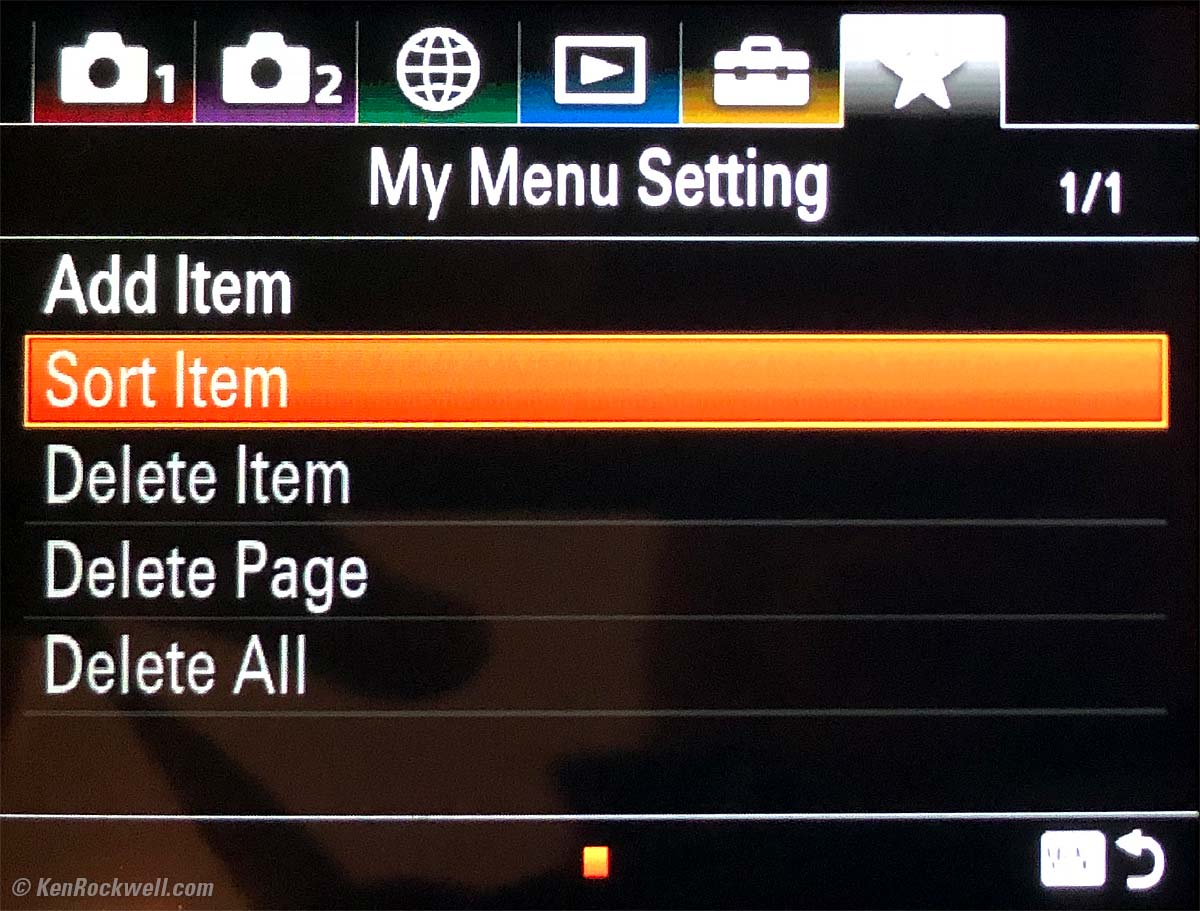 |
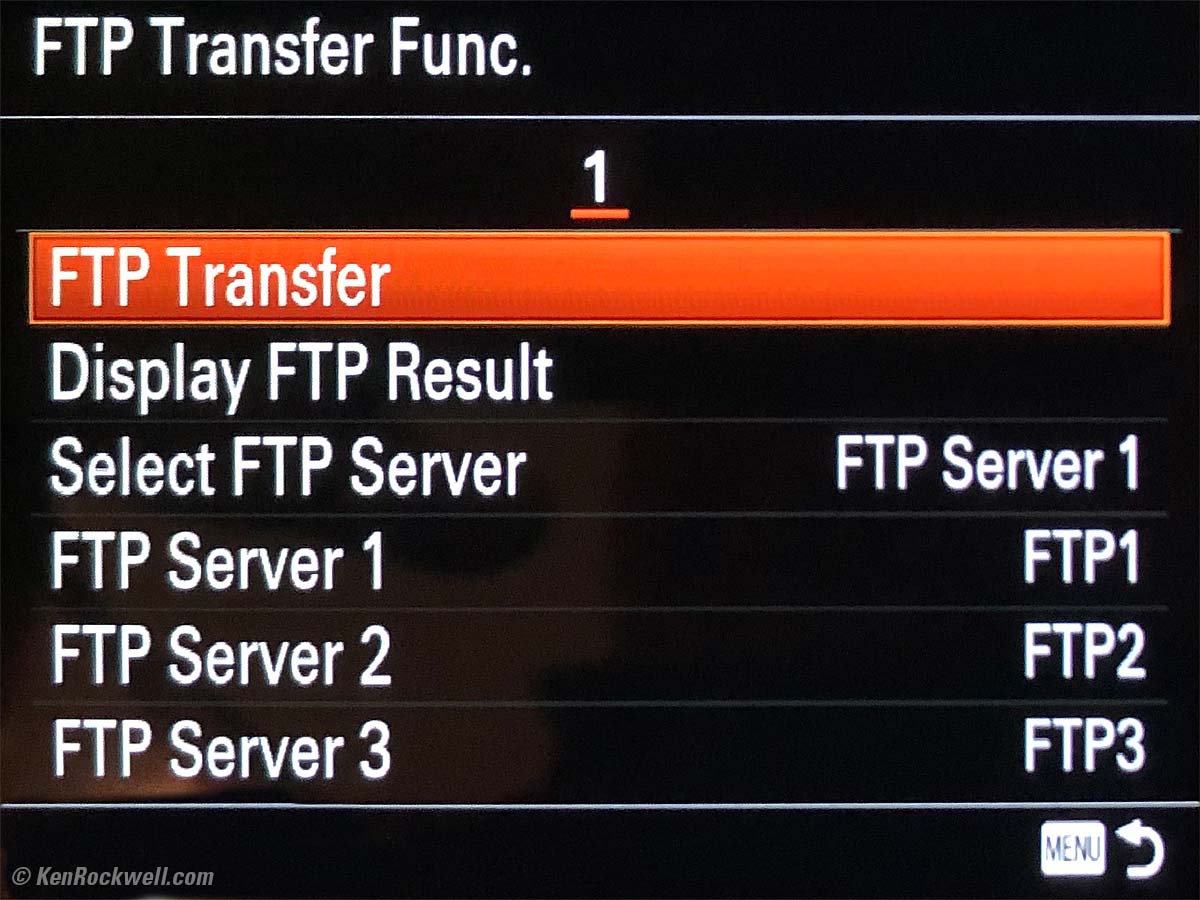 |
Canon's menu system color-codes everything, even inside a menu item, so we instinctively can find it next time.
Nikon's menu system isn't color-coded, but it is very well organized.
The LCD is great, except for use in direct sunlight. It has no auto-brightness control.
No worries, use the superb EVF in daylight.
The LCD flips vertically, but not very far, and it doesn't swing left or right.
Honestly I never use the rear LCD. I use the EVF for everything.
It autorotates as you turn the camera, just like an iPhone, if you set MENU > PLAY > page 3/3 > Display Rotation > Auto.
Oddly as in earlier Sonys, even though it's smart enough to rotate the image as you rotate the camera during playback, if you zoom the image, it won't autorotate.
There's no way to read the file number.
There is no 1/2 second auto review option (MENU > Camera 2 > page 7/9 > Auto Review) as there is in some other Sonys; only 2, 5 and 10 seconds.
While there is no diagonal scroll in a zoomed image using the rear four-way control dial just like other Sonys, this A7R III has a new thumb-nubbin which works in all 8 directions.
Cards are not properly titled when formatted. Even weirder, the two different card slots format with different titles!
Slot one, the UHS-II slot on the bottom, formats cards as "NO NAME," and slot two, the UHS-I slot on the top, formats cards as "Untitled." I was wondering if it simply wasn't bothering to retitle the cards and was leaving them as they were, but no, it is retitling the cards this particular way. They ought to be titled "SYA7R3-1" and "SYA7R3-2" for the two slots, or let us preset a value, but no.
It takes longer than other brands of camera to format cards.
JPG image file sizes vary with image complexity, as they should.
Fantastic is that we have the menu option for it to create a new folder each day. I wish my DSLRs did that! For instance, everything I shoot on 20 December 2017 is in a folder DCIM / 10071220.
Battery life is fantastic for a mirrorless camera, as good or better than a DSLR in actual sports shooting. In sports shooting where I make long bursts at 10 FPS, I can shoot 1,800 frames and only use 33% of the battery's capacity — or about 5,400 shots on a full charge.
If I shoot more stills, meaning fewer shots at a time before I look at the playback, I only run the battery down to about 82% after about 250 shots, which means about 1,400 shots on a charge for that kind of shooting.
The A7R III may be left turned on and it will go to sleep after a minute.
The A7R III has a battery percentage indicator, but no long-term battery health indication.
I usually charge via USB, where it draws 425mA DC while charging.
The dedicated charger is faster. It has a great charge-state icon, but both the orange CHARGE LED and the green 3-segment indicators all turn off soon after the battery is charged, meaning when you come back to the charger you never really know if all is well, or something was disconnected.
Sony BC-QZ1 Battery Charger with NP-FZ100 battery. bigger.
Compared
Top Sample Images Intro Lenses & Adapters
Specifications Accessories USA Version
I'd get my A7R III at Adorama, at Amazon, at B&H or at Crutchfield, or get it used if you know How to Win at eBay.
NEW: Sony A7R Mark IV.
Nikon vs Canon vs Sony Full Frame Mirrorless Compared.
All Sony Cameras Compared
Versus the Sony A9
This A7R III is newer, less expensive, has twice the resolution and is better in most ways for most photography than the Sony A9, unless you specifically need 20 FPS and exclusively shoot sports and action.
This A7R III takes the 42MP sensor of the old A7R II and puts it in a Sony A9 body, with the A9's newest processing and the A9's viewfinder, external controls and rear LCD.
The A7R III is essentially an A9 with 42 megapixels that runs at 10 FPS.
While the A9 has a special sensor whose data can instantly be read in its entirety that allows 20 FPS shooting without blackout and without rolling shutter effects, the A7R III's conventional high-resolution sensor has a rolling shutter and its finder may jump a little during continuous shooting.
Each has the same high ISO performance. At the same ISO setting, each makes about the same quality image, but the A7R III has more resolution. The A9 has an ISO 204,800 setting that the A7R III lacks, but the A9 looks much worse at this setting.
I prefer that the A7R III lacks the A9's mechanical dials for focus and advance modes because these modes now save and recall with the memory settings on the top dial.
The silent mode of the A7R III is superior to the A9 because it works at all speeds, while it only works to 1/8 second on the A9 in continuous shooting. You can shoot at all high ISOs to ISO 102,400 in Silent mode on the A7R3, but only up to ISO 25,600 on the A9.
They use the same battery, but battery life is just a little better with the A7R3, CIPA rated 530 versus 480 shots per charge in the A9.
A huge battery advantage of the A7R III is that it doesn't drain the battery while turned off. My A9 consumes about 15% of its charge each day even if left turned off. If you charge the A9 battery and come back in a week, it's dead.
The A7R III's maximum shutter speed is 1/8,000, while the A9's electronic shutter can go to 1/32,000.
Both have full frame face recognition, but the A7R III covers only half the frame with phase detection pixels. The A9 covers the whole frame with phase-detection pixels, better for tracking action.
Get the A9 for shooting action, and the A7R III for everything else, or a mix of things.
Versus Nikon and Canon Pro DSLRs
This Sony is smaller and completely silent, but only runs at 10 FPS versus 12 or 14.
The Nikon D5 and Canon 1DX Mk II are bigger, heavier, more expensive — and tougher. They are mostly metal and have all their doors sealed, and their card doors are metal, too, while the doors of the A7R III are plastic and unsealed. The Nikon D5 and Canon 1DX Mk II are also much more comfortable in-hand, with more mature ergonomic design. They cost twice as much and are much tougher.
The Nikon D5 and Canon 1DX Mk II both have direct voice-memo recording buttons for discreet note-taking while shooting, but oddly Sony, which has been one of the world's leading innovators in audio recorders for their entire history, has no audio note recorder in the A7R III.
Versus the A7R II and A7S II
The A7S II and A7R II are much older and slower. You can see what's different from the A7R II above.
The A7R III adds features I use every day like a far superior battery, a second card slot and a third memory preset on the top dial.
A7R III User's Guide
Top Sample Images Intro Lenses & Adapters
Specifications Accessories USA Version
I'd get my A7R III at Adorama, at Amazon, at B&H or at Crutchfield, or get it used if you know How to Win at eBay.
See also Sony's A7R III User's Manual.
Charging
The battery charges internally via USB or externally in the included corded charger.
Either charge method lights an amber LED while charging, which simply goes out when done.
It's hard to see the camera's tiny charge LED hidden near the USB socket inside a cover.
USB also can power the camera indefinitely.
Power
Auto power off doesn't work that well. I prefer to turn it OFF whenever it's around my neck, but then I need to remember to turn it ON every time I bring it to my eye.
Set the Clock
Set this at MENU > Suitcase > page 5/7 > Date/Time Setup.
Format Card
This is hidden at MENU > Suitcase > page 5/7 > Format.
File Name Prefixes
Set this at MENU > Suitcase > page 5/7 > Set File Name.
I set mine to "7R3."
Automatic New Daily Folders
This creates a new folder on your card each day.
I set it at MENU > Suitcase > page 6/7 > Folder Name > Date Form.
Beeps
To turn off the annoying beeps that are on by default, set MENU > Camera 2 > page 9/9 > Audio signals > OFF.
Setting What the Controls Do
Set these at MENU > Camera 2 > page 8/9 > Custom Key (Shoot, Movie or Playback).
Setting the Fn menu
The Fn menu is the options you see at the bottom of your screen when you press the (Fn) button.
Set this at MENU > Camera 2 > page 8/9 > Function Menu Set.
I like to put Auto ISO Minimum Shutter Speed and Image Size, there, for instance.
There is no right or wrong, just what works for you.
Auto ISO
To set the minimum shutter speed if you don't assign this control to the Fn menu, set it at MENU > Camera 1 > page 9/14 > ISO AUTO Min. SS.
If you choose Auto for the slowest shutter speed, it sets it based on focal length. Slow or Fast shift it by one stop, and Slower or Faster shift it by 2 stops from the focal length.
I set 1/125 for people shots and 1/500 for action.
For things that hold still, I set AUTO, or SLOW or SLOWER if it's an optically stabilized lens.
Again, there is no right or wrong; just what works for you.
Face Detection
This is one of the A7R III's most important features, but it's OFF by default.
Set it at MENU > Camera 1 > page 6/14 > Set Face Prty in AF > ON.
I never turn it off.
Getting Awesome Autofocus Performance
This is easy: once you've enabled Face Detection, I shoot in AF-C (continuous) and leave the Focus Area setting in its default of WIDE (either at the Fn button or MENU > Camera 1 > page 5/14 > Focus Area > Wide. Now my A7R III magically finds the subject, focuses on it, and tracks it all over the finder if it moves. It's that simple.
You need lenses that have fast autofocus. Sony's G and GM lenses are the best, designed to excel with the A7R III.
Older lenses, or anything on an adapter, probably won't give you the performance you deserve or expect, but with the 24-70/2.8 GM and 70-200/2.8 GM I use, it's spectacular.
Manual AF point selection with the touch screen
When you set this you can slide your finger around the touch screen — even if it's off as you use the electronic finder — to position the AF points.
Set:
1.) MENU > Suitcase > page 2/7 > Touch Operation > ON.
2.) MENU > Suitcase > page 3/7 > Touch Panel/Pad > Touch Panel+Pad.
3.) MENU > Camera 1 > page 6/14 > Center Lock-on AF > OFF.
4.) MENU > Camera 1 > page 5/14 > Focus Area should be set to anything other than Flexible Spot or Expanded Flexible Spot. I use Wide.
Set all this, and you can just slide your right thumb around the dark LCD to move your AF points wherever you want them.
When you want to return to the center point, press the big center button on the back.
I don't use this mode since my A7R III usually selects what I need automatically, and if I set this mode my fingers usually wind up selecting zones at random if I touch the screen by accident.
Manual Focus Override
Set the DMF focus mode with the Fn button to allow immediate manual focus override with autofocus. It's so smart that it probably will magically zoom into faces as you turn the focus ring!
The gotcha here is that DMF works in AF-S (single) mode, not AF-C (continuous) mode, so don't use it for sports.
Use a lens with a mechanical focus override ring, like the 70-200/2.8 GM, and you can just grab its focus ring in the AF-C (or any other) mode for instant override. Most lenses, like the 24-105mm f/4 G and 24-70/2.8 GM, won't give manual override unless you're in the DMF mode.
Focus Magnifier
I like to have the manual focus magnifier come up when I tap a button when using an adapted manual focus lens. With an adapted old lens, there's nothing to tell the A7R III when to magnify unless you program something.
Set which button does this at MENU > Camera 2 > page 8/9 > Custom Key(Shoot.) > (choose a key, say Custom Button 2, the C2 button near the shutter) > Focus Magnifier.
"Custom Buttons" 1-4 refer to the buttons marked C1, C2, C4 and C4 (the trash button). For some unknown reason, this works assigned to C2 or C4, but not if I set it on the Multi-Slc Center Btn — but it's supposed to.
Silent Mode
This is a very important feature of the A7R III, and it's off by default.
Set it at MENU > Camera 2 > page 4/9 > Silent Shooting > ON.
I always leave my A7R3 in Silent. You only need turn to this off if you want to use flash or shoot at slower than ISO 100.
Shooting under flickering light
If shooting under fluorescent, dimmed LED, sodium, mercury or other lights that tend to flicker at twice the power line frequency, set MENU > Camera 1 > page 14/14 > Anti flicker Shoot > ON.
You can't use this mode with the Silent mode; pick one. I skip the flicker mode and just shoot in Silent.
Did it Shoot?
If it's silent and you don't set Image Review, how do you know if it went off?
Easy: either the display blacks-out for a moment at slower frame rates, or becomes jerky at high frame rates.
Self Timer
Select the Self Timer at the Advance Mode after pressing Fn.
Image Review
To have what you just shot appear on-screen right after you shot it, turn this on at MENU > Camera 2 > page 7/9 > Auto Review and select for how long you'd like each to appear after you've shot it.
I don't use this; it slows me down.
Playback Rotation
It autorotates as you turn the camera, just like an iPhone, if you set MENU > PLAY > page 3/3 > Display Rotation > Auto.
1, 2, 3, M1, M2, M3 and M4 Memory Modes
The 1, 2 and 3 on the mode dial are instant memory recalls. bigger.
Once you've set the camera as you like it, go to MENU > Camera 1 > page 3/14 > MR Cam 1/Cam 2 Memory and save the current settings to the memory address of your liking. 1, 2 and 3 are recalled by selecting them on the top dial, while M1, M2, M3 and M4 are only recallable via the menu system (MENU > Camera 1 > page 3/14 > MR Cam1/Cam 2 Recall).
Almost everything, like AF modes, frame rates, AF illuminators, shutter type, resolution, image settings, Image Review and white balance are saved and recalled.
The top dial has only 1, 2 and 3 positions, but to select M1, M2, M3 or M4, all you do is move the top dial to any of 1, 2 or 3, and you'll see a screen with what you've selected for recall highlighted at the top. Simply click left or right to select any of the "hidden" M1, M2, M3 or M4 options, and Bingo!, you've recalled them.
The A7R III locks-up for a few critical seconds when you move the memory setting dial. A faster way to swap between modes is to turn off the A7R III, move the mode dial, and turn it back on. This sounds complex, but it actually works faster since it doesn't lock up when turned on in a new mode.
If you change any settings while using one of these modes, the A7R III will wake back up the same way after being turned off. If you want to return to the originally saved settings as opposed to what you've just modified, set it to another preset and then return to other, which will now come back up as saved.
There is no "Auto Update" setting. When you're getting your new camera set, you'll have to save each new iteration manually.
I set number 1 for photos of places and things, which I set to high resolution and slower shutter speeds and ultra high color saturation.
I set number 2 for photos of people: moderate resolution and saturation, and set Auto ISO to a slowest speed of 1/125 to stop motion.
I set number 3 for sports and action, which I set very similarly to number 2, except with a 1/500 minimum shutter speed to stop action.
| Memory setting | 1 |
2 |
3 |
Set at (most of these functions can be assigned to the C buttons or the Fn menu) |
| Used for | Places and Things |
People |
Sports & Action |
|
| Drive Mode | Continuous Low (3 FPS) |
Continuous Low (3 FPS) |
Continuous Hi+ (10 FPS) |
Fn, or MENU > Cam 1 > page 3/14 > Drive Mode |
| AF Mode | AF-A (Auto-selects continuous or single) |
AF-C (continuous) |
AF-C (continuous) |
Fn, or MENU > Cam 1 > page 5/14 > Focus Mode |
| Exposure Mode | Program |
Program |
Program |
Top mode dial (set this while programming the 1, 2 and 3 positions, then select the 1, 2 or 3 position to use these settings) |
| Image Size | L: 42 MP |
S: 11 MP |
S: 11 MP |
Fn, or MENU > Cam 1 > page 1/14 > JPEG Image Size. |
| Quality | Standard |
Standard |
Standard |
MENU > Cam 1 > page 1/14 > JPEG Image Quality |
| Creative Style | Vivid |
Standard |
Standard |
Fn, or MENU > Cam 1 > page 12/14 > Creative Style |
| Saturation | +3 |
+1 |
+1 |
Fn, or MENU > Cam 1 > page 12/14 > Creative Style |
| ISO | Auto |
Auto |
Auto |
Fn, ISO button (right side of rear controller), or MENU > Cam 1 > page 9/14 > ISO |
| Auto ISO Min & Max | 100 & 102,400 |
100 & 102,400 |
100 & 102,400 |
Fn, ISO button (right side of rear controller), or MENU > Cam 1 > page 9/14 > ISO |
| ISO Auto Min Shutter Speed | Auto Slower |
1/125 |
1/500 |
MENU > Cam 1 > page 9/14 > ISO AUTO Min. SS |
Explanations
Drive Mode
3 FPS lets me make one shot at a time, or several if I hold the shutter down.
10 FPS lets me catch all the action.
AF Mode
AF-C is best for tracking people and action, while the AF-A mode will hold and lock focus if the subject is still.
Image Size
While I often shoot still subjects at the highest resolution, for people and action 11 MP is more than enough for anything, and makes editing, storage and transmission so much faster and easier.
Image Quality
Standard gives me the smallest file sizes, and looks great.
Creative Style
I photograph places and things at extreme saturation, but that makes people look bad.
I photograph people in the standard setting, with a minor +1 saturation boost for a little more pizazz.
ISO
I always use Auto, which I program to set ISO exactly as I'd set it manually:
Auto ISO Min & Max
I set ISO 102,400 as the maximum because 102,400 still looks pretty good - much better than a blurry image shot at 51,200. Of course set this to your own taste.
Auto ISO Minimum Shutter Speed
I set it to AUTO Slow for still subjects because this sets it based on lens focal length. I always get sharp shots at this setting.
I set 1/125 for people shots because that's the slowest speed at which most people shots won't show motion blur from people moving and talking.
I set 1/500 for sports and action as 1/500 is the slowest speed that freezes just about any motion. Remember, this is the slowest shutter speed it will use before increasing ISO.
Embed Your Contact Information in Every Image
I set this at MENU > Suitcase > page 5/7 > Copyright info.
This adds whatever text you want in the file's EXIF data; it doesn't draw it on the photo.
Recording to 2 cards at Once as Backup
I set this at MENU > Suitcase > page 6/7 > Rec. Media Settings > Recording Mode > Simult (mountain icon).
Now it records everything to both cards at once as backup.
I do this, but if I pull out one card, it won't record at all!
Be sure to have a spare card if one fills, or know where to reset this setting if you run out of a second card because you'll be dead as soon as either of the cards isn't ready.
Seeing the Rear LCD in Daylight
There is an extra setting called "Sunny Day" in the LCD brightness setting menu.
Use this and it's amazing how good the rear LCD looks in direct sunlight.
Under- and Over-Crank (slow-mo and fast-motion video)
Sony calls this S&Q, for "Slow and Quick" motion.
It's set on the Mode Dial, and adjusted in the menu system at MENU > Camera 2 > page 1/9 > S&Q Settings.
Recommendations
Top Sample Images Intro Lenses & Adapters
Specifications Accessories USA Version
The Sony A7R III is the best cost-no-object mirrorless camera for general photography. While the A9 is twice as fast for sports, it has only half the resolution and its silent shooting mode is more restricted — and the A9 costs much more.
Be sure to have the right lenses if you want the best performance. People love these Sonys because you can adapt any old lens to them, but I see no intelligence in adapting a $10 Pentax 50mm SMC lens to this $3,200 camera, much less using other lenses on adapters, if I want the high-speed, high-resolution performance for which I bought my A7R III.
I use hot SD cards, but even old slow cards work fine in my A7R III; it just may take a while to clear the buffer if you're shooting large files or at 10 FPS.
I'd get my A7R III at Adorama, at Amazon, at B&H or at Crutchfield, or get it used if you know How to Win at eBay.
This all-content, junk-free website's biggest source of support is when you use those or any of these links to approved sources when you get anything, regardless of the country in which you live. Sony does not seal its boxes in any way, so never buy at retail or any other source not on my personally approved list since you'll have no way of knowing if you're missing accessories, getting a defective, damaged, returned, store demo or used camera. I use the stores I do because they ship from secure remote warehouses where no one gets to touch your new camera before you do. Buy only from the approved sources I use myself for the best prices, service, return policies and selection.
Thanks for helping me help you!
Ken, Mrs. Rockwell, Ryan and Katie.
More Information
Top Sample Images Intro Lenses & Adapters
Specifications Accessories USA Version
I'd get my A7R III at Adorama, at Amazon, at B&H or at Crutchfield, or get it used if you know How to Win at eBay.
Sony's A7R III resources page.
© Ken Rockwell. All rights reserved. Tous droits réservés. Alle Rechte vorbehalten.
Help Me Help You
I support my growing family through this website, as crazy as it might seem.
The biggest help is when you use any of these links when you get anything. It costs you nothing, and is this site's, and thus my family's, biggest source of support. These places always have the best prices and service, which is why I've used them since before this website existed. I recommend them all personally.
If you find this page as helpful as a book you might have had to buy or a workshop you may have had to take, feel free to help me continue helping everyone.
If you've gotten your gear through one of my links or helped otherwise, you're family. It's great people like you who allow me to keep adding to this site full-time. Thanks!
If you haven't helped yet, please do, and consider helping me with a gift of $5.00.
As this page is copyrighted and formally registered, it is unlawful to make copies, especially in the form of printouts for personal use. If you wish to make a printout for personal use, you are granted one-time permission only if you PayPal me $5.00 per printout or part thereof. Thank you!
Thanks for reading!
Mr. & Mrs. Ken Rockwell, Ryan and Katie.
